Urban Canyon Flight UC10X skyBeacon UAT Transponder User Manual UC10x Installation Manual
Urban Canyon Flight Inc skyBeacon UAT Transponder UC10x Installation Manual
User Manual

UC10x Installation
Manual
UC100, UC101, UC102 and UC103
145 E Jewett Blvd STE 301
White Salmon, WA 98672
p. 509-493-XXXX
info@ucflight.com
www.ucflight.com
DRAFT
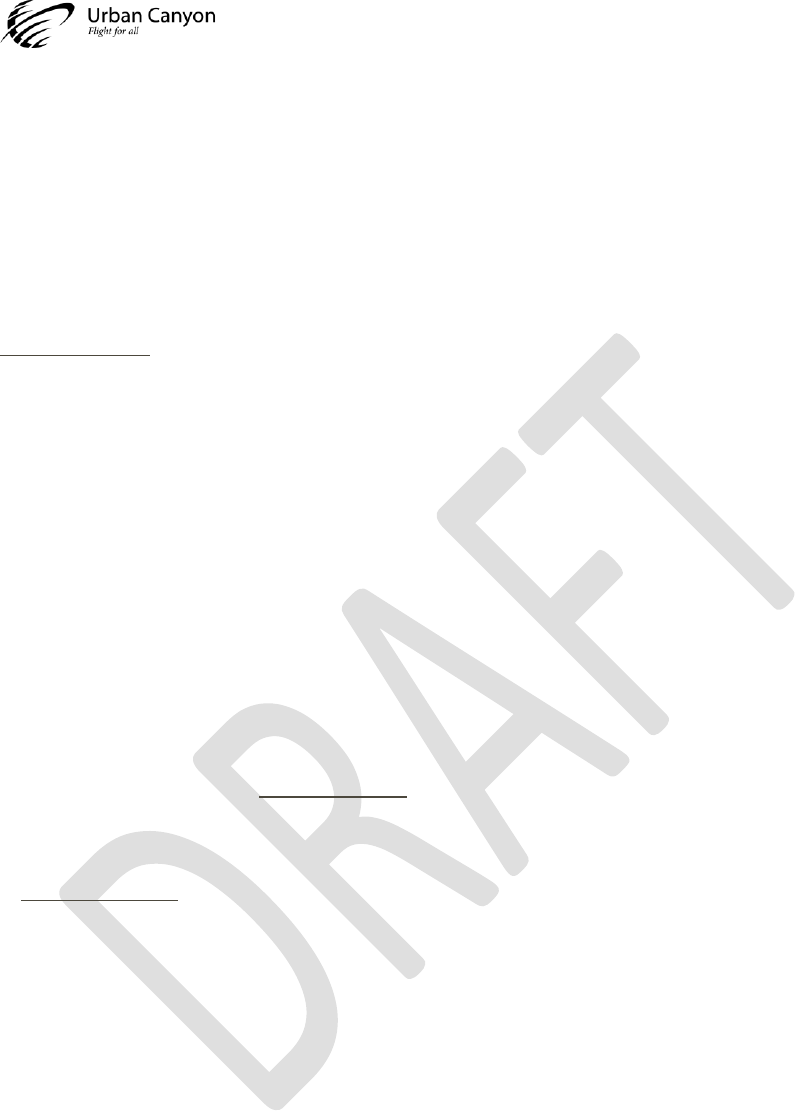
UC10x Installation Manual
URBAN CANYON FLIGHT INC UC10X-001-IM REV02
CONFIDENTIAL & PROPRIETARY PAGE 2 OF 69
Contact Information
Urban Canyon Flight, Inc.
145 E Jewett Blvd STE 301
White Salmon, WA 98672 U.S.A.
Phone: (509) 493-XXXX - 8:00 AM – 5:00 PM (Pacific Time) Monday – Friday
Urban Canyon Flight Technical Support available 7:00 AM – 4:00 PM (Pacific Time) Monday – Friday
info@ucflight.com
Copyright
©2017 Urban Canyon Flight, Inc. All rights reserved. No part of this manual may be reproduced, copied,
transmitted, disseminated or stored in any storage medium, for any purpose without the express written
permission of Urban Canyon Flight Inc (“UCF”). UCF hereby grants permission to download a single copy of this
manual and of any revision to this manual onto a hard drive or other electronic storage medium to be viewed for
personal use, provided that such electronic or printed copy of this manual or revision must contain the complete
text of this copyright notice and provided further that any unauthorized commercial distribution of this manual or
any revision hereto is strictly prohibited. UCF reserves the right to revoke this permission at any time without
cause, at which point the original manual and all electronic or hardcopies must be permanently deleted.
Information in this document is subject to change without notice. UCF reserves the right to change or improve its
products and to make changes in the content without obligation to notify any person or organization of such
changes. Visit the UCF website (www.ucflight.com) for current updates and supplemental information concerning
the use and operation of this and other UCF products.
To report misuse of this copyright or any other breach, please contact us using the information above or email us
at legal@ucflight.com.
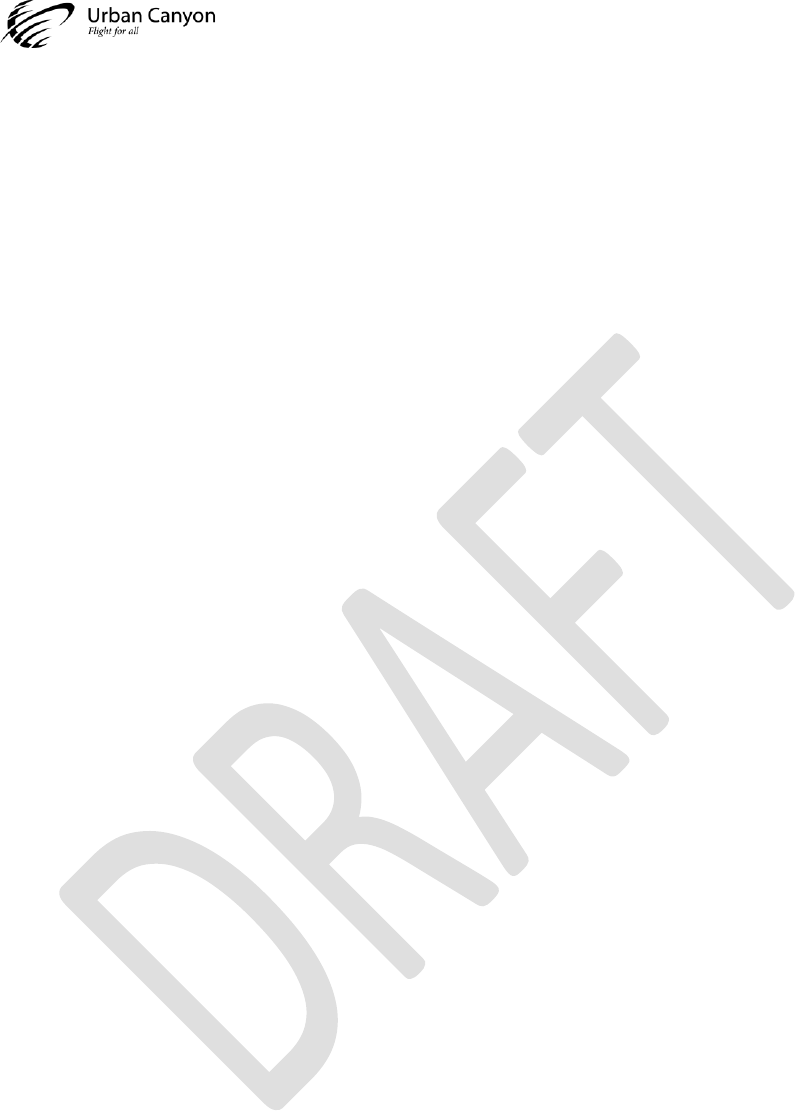
UC10x Installation Manual
URBAN CANYON FLIGHT INC UC10X-001-IM REV02
CONFIDENTIAL & PROPRIETARY PAGE 3 OF 69
This page intentionally left blank.
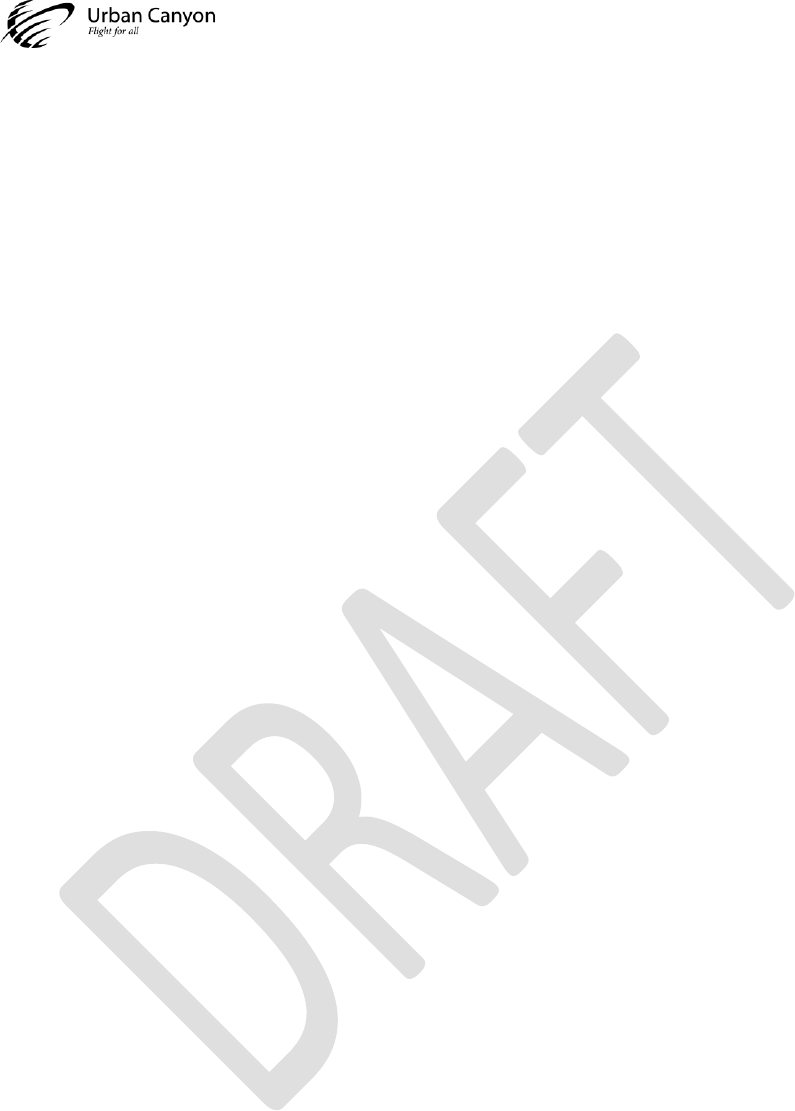
UC10x Installation Manual
URBAN CANYON FLIGHT INC UC10X-001-IM REV02
CONFIDENTIAL & PROPRIETARY PAGE 4 OF 69
Table of Contents
1 DOCUMENT ............................................................................................................................................... 8
1.1 REVISION HISTORY ............................................................................................................................................................... 8
1.2 PRODUCT DOCUMENTS ........................................................................................................................................................ 8
2 LIMITED WARRANTY ............................................................................................................................... 9
2.1 UNPACK AND INSPECT BEFORE USE ................................................................................................................................. 9
2.2 DO NOT DISASSEMBLE .......................................................................................................................................................... 9
3 SOFTWARE LICENSE AGREEMENT..................................................................................................... 10
4 SAFETY AND SECURITY ......................................................................................................................... 11
4.1 FOR YOUR SAFETY ............................................................................................................................................................... 11
4.2 SAFE EXPOSURE LIMITS ..................................................................................................................................................... 11
4.3 USE ONLY PROVIDED AND/OR RECOMMENDED CABLES & ACCESSORIES ............................................................... 11
4.4 LICENSING ............................................................................................................................................................................ 11
4.5 PROFESSIONAL INSTALLATION DISCLAIMER ................................................................................................................. 11
4.6 DESIGN APPROVAL ............................................................................................................................................................. 12
4.7 INSTALLATION APPROVAL ................................................................................................................................................. 12
5 FCC CERTIFICATION AND COMPLIANCE ......................................................................................... 13
5.1 FCC ID .................................................................................................................................................................................. 13
5.2 FCC RADIATION EXPOSURE STATEMENTS .................................................................................................................... 13
5.3 FCC INTERFERENCE STATEMENTS .................................................................................................................................. 13
5.4 FCC OEM LABELING REQUIREMENTS FOR END-PRODUCT ..................................................................................... 14
5.5 FCC OEM END-PRODUCT USER MANUAL STATEMENTS........................................................................................... 14
5.6 FCC-COMPLIANT ANTENNA & CABLE ........................................................................................................................... 14
5.7 PRODUCT LABEL .................................................................................................................................................................. 15
5.8 ELECTRONIC LABELING (E-LABEL) ................................................................................................................................. 19
6 REGULATORY & TECHNICAL OVERVIEW ........................................................................................ 23
6.1 UC100 TRAFFIC AWARENESS BEACON SYSTEM (TABS) ............................................................................................. 23
6.2 UC101 MODE C TRANSPONDER ...................................................................................................................................... 24
6.3 UC102 MODE C TRANSPONDER WITH ADS-B OUT .................................................................................................... 25
6.4 UC103 MODE S TRANSPONDER WITH ADS-B OUT ..................................................................................................... 26
6.5 ENVIRONMENTAL QUALIFICATION FORM ..................................................................................................................... 27
7 GENERAL INFORMATION .................................................................................................................... 29
7.1 INTRODUCTION.................................................................................................................................................................... 29
7.2 GENERAL DESCRIPTION .................................................................................................................................................... 29
7.3 TECHNICAL STANDARD ORDER (TSO) APPROVALS ..................................................................................................... 29
7.4 FAA NEXTGEN / 2020 MANDATE .................................................................................................................................. 30
7.5 INCOMPLETE SYSTEM ......................................................................................................................................................... 31
7.6 NON-TSO FUNCTIONS ....................................................................................................................................................... 31
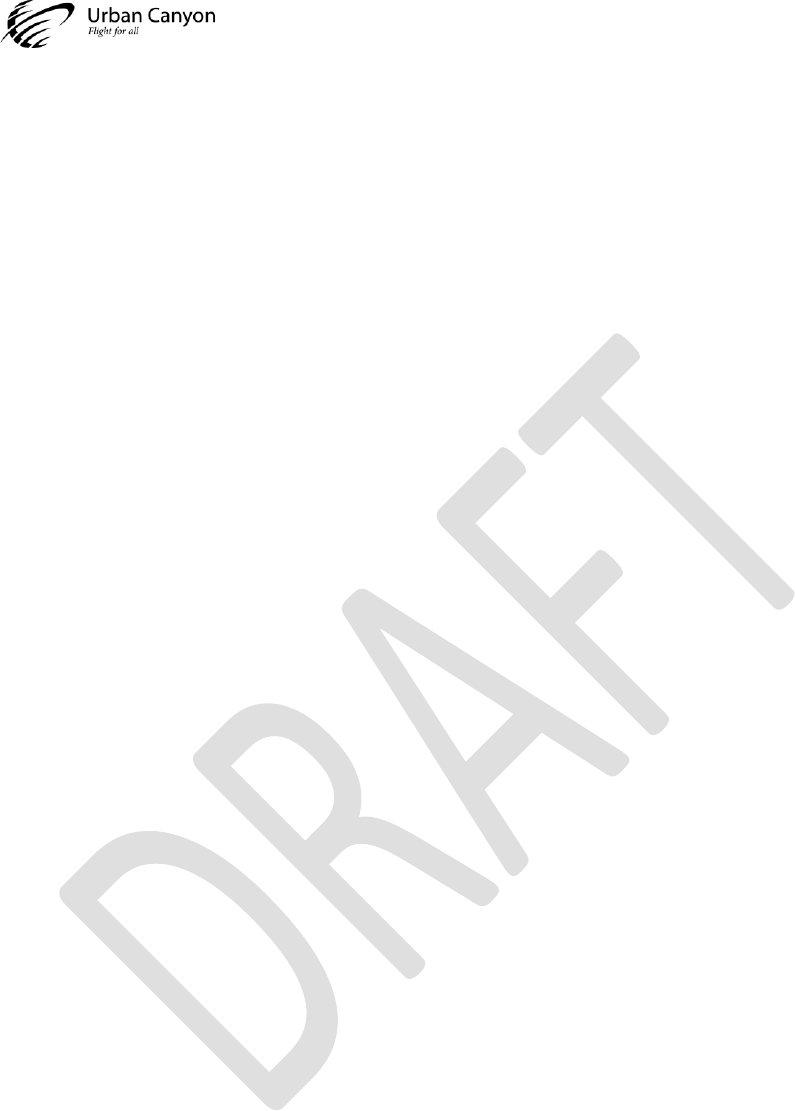
UC10x Installation Manual
URBAN CANYON FLIGHT INC UC10X-001-IM REV02
CONFIDENTIAL & PROPRIETARY PAGE 5 OF 69
8 EQUIPMENT DESCRIPTION ................................................................................................................ 33
8.1 SYSTEMS OVERVIEW AND PLANNING ............................................................................................................................. 33
8.2 INPUT AND OUTPUT INTERFACES .................................................................................................................................... 34
8.3 GPS/GNSS INPUT .............................................................................................................................................................. 36
8.4 ALTITUDE INPUT ................................................................................................................................................................. 38
8.5 RF SUPPRESSION BI-DIRECTIONAL BUS ......................................................................................................................... 38
8.6 AUTOMATIC AIR/GROUND DETERMINATION .............................................................................................................. 38
8.7 ANTENNA PORT ................................................................................................................................................................... 38
9 SUPPORTED REGISTERS AND PARAMETERS .................................................................................. 39
9.1 MODE S.................................................................................................................................................................................. 39
9.2 ADS-B ................................................................................................................................................................................... 41
10 ELECTRICAL CONNECTIONS .......................................................................................................... 43
10.1 POWER / DATA CONNECTOR PINOUT & DESCRIPTIONS ............................................................................................ 44
10.2 BASIC INTERCONNECT DIAGRAM – WITH OPTIONS .................................................................................................... 46
10.3 BASIC INTERCONNECT DIAGRAM – MINIMUM CONNECTIONS .................................................................................. 47
11 EQUIPMENT INSTALLATION .......................................................................................................... 49
11.1 GENERAL .............................................................................................................................................................................. 49
11.2 UNIT AND ACCESSORIES SUPPLIED .................................................................................................................................. 50
11.3 UC10X INSTALLATION ....................................................................................................................................................... 51
11.4 ANTENNA & ANTENNA CABLE INSTALLATION ............................................................................................................ 52
12 INSTALLATION SETUP AND TEST .................................................................................................. 57
12.2 TEST AND CALIBRATION ITEMS ........................................................................................................................................ 58
12.3 CALIBRATION EQUIPMENT ................................................................................................................................................ 59
12.4 POST INSTALLATION CHECKOUT AND OPERATION ..................................................................................................... 59
13 INSTRUCTIONS FOR CONTINUED AIRWORTHINESS ................................................................ 61
13.1 SCHEDULED MAINTENANCE ............................................................................................................................................. 61
13.2 SERVICE LIFE ........................................................................................................................................................................ 61
13.3 REPAIRABILITY ..................................................................................................................................................................... 61
13.4 FIELD FIRMWARE UPDATES .............................................................................................................................................. 61
13.5 ADS-B ................................................................................................................................................................................... 61
14 REFERENCED & IMPORTANT DOCUMENTS ............................................................................... 63
15 ACRONYMS ........................................................................................................................................... 68
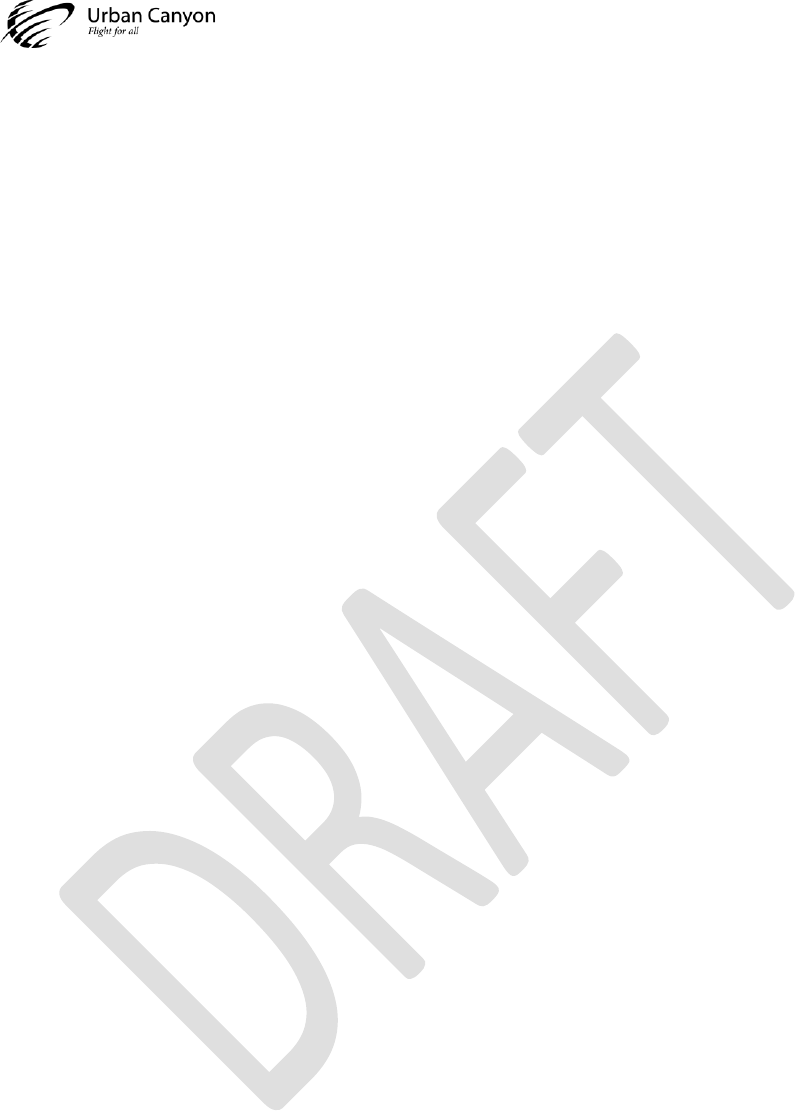
UC10x Installation Manual
URBAN CANYON FLIGHT INC UC10X-001-IM REV02
CONFIDENTIAL & PROPRIETARY PAGE 6 OF 69
List of Figures
Figure 1. UC10x Product Labels (SCALE 2:1) ........................................................................................................... 15
Figure 2. UC10x Product Label Mechanical Drawing (SCALE 2:1) ....................................................................... 16
Figure 3. UC10x Mechanical Drawing with Label Location (SCALE 1:1) ............................................................ 17
Figure 4. FCC Part 15 Declaration of Conformity – Location on 4 x 3 x 1” Product Box ................................ 18
Figure 5. FCC Part 15 Declaration of Conformity – Language on Product Box ................................................. 18
Figure 6. Example Electronic Label for Model Number UC100 ............................................................................ 19
Figure 7. Example Electronic Label for Model Number UC101 ............................................................................ 20
Figure 8. Example Electronic Label for Model Number UC102 ............................................................................ 20
Figure 9. Example Electronic Label for Model Number UC103 ............................................................................ 21
Figure 10. System-Level Block Diagram ...................................................................................................................... 33
Figure 11. Alternate System-Level Block Diagram .................................................................................................... 34
Figure 12. Connector Pinout (as viewed into transponder) ...................................................................................... 44
Figure 13. Connector Pinout (as viewed into the cable) ........................................................................................... 44
Figure 14. UC10x Basic System-Level Interconnect Diagram (with options) ....................................................... 46
Figure 15. UC10x Basic System-Level Interconnect Diagram (minimum connections) ..................................... 47
Figure 16. Mounting Hole Pattern Drawing (SCALE 1:1) ....................................................................................... 51
Figure 17. Example over-the-cable ferrite beads to troubleshoot “reradiating” issue ......................................... 56
List of Tables
Table 1. Document Revision History ............................................................................................................................. 8
Table 2. Documents Related to UC10x Products ........................................................................................................ 8
Table 3. UC10x TSO Authorizations by Product ...................................................................................................... 29
Table 4. FAA NextGen / 2020 Mandate Compliance by Product ......................................................................... 30
Table 5. TSO Deviations ................................................................................................................................................ 31
Table 6. Failure Condition Classifications ................................................................................................................... 32
Table 7. Supported Baud Rates for RS-232 Communication ................................................................................... 35
Table 8. Summary of acceptable data sources ............................................................................................................. 36
Table 9. GPS products for 2020 Mandate (14 CFR 91.227 or AMC 20-24 compliant system) ......................... 37
Table 10. GPS products for TABS (TSO-C199) compliant system ........................................................................ 38
Table 11. Mode S Uplink Formats (UF) Supported .................................................................................................. 39
Table 12. Mode S Downlink Formats (DF) Supported............................................................................................. 39
Table 13. Mode S BDS Registers Supported ............................................................................................................... 39
Table 14. Mode S Fields/Parameters Supported ........................................................................................................ 40
Table 15. ADS-B BDS Registers Supported ............................................................................................................... 41
Table 16. ADS-B Parameters Supported .................................................................................................................... 41
Table 17. Interface Pinout .............................................................................................................................................. 45
Table 18. Key for Pinout Table ..................................................................................................................................... 45
Table 19. Simplified Interpretation of MOPS Antenna Requirements ................................................................... 53
Table 20. Example maximum cable length by cable type ......................................................................................... 54
Table 21. Referenced & Important Standards & Regulatory Documents .............................................................. 63
Table 22. Definition of Acronyms ................................................................................................................................ 68
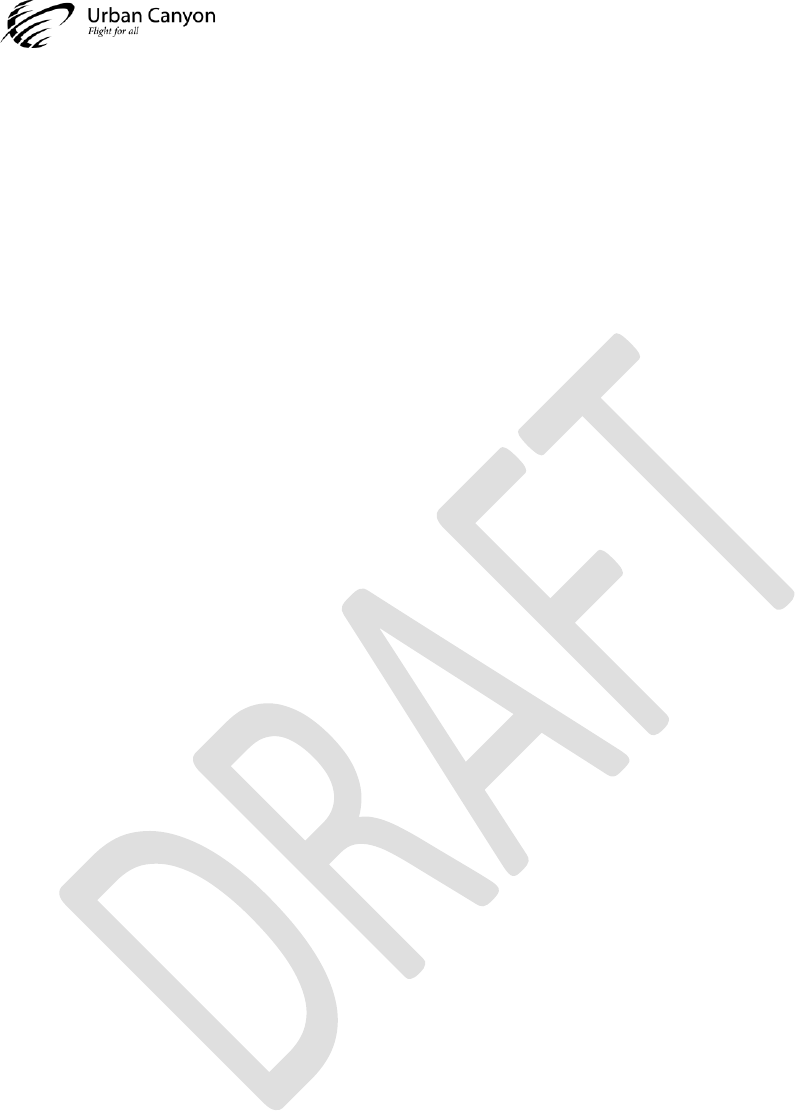
UC10x Installation Manual
URBAN CANYON FLIGHT INC UC10X-001-IM REV02
CONFIDENTIAL & PROPRIETARY PAGE 7 OF 69
This page intentionally left blank.
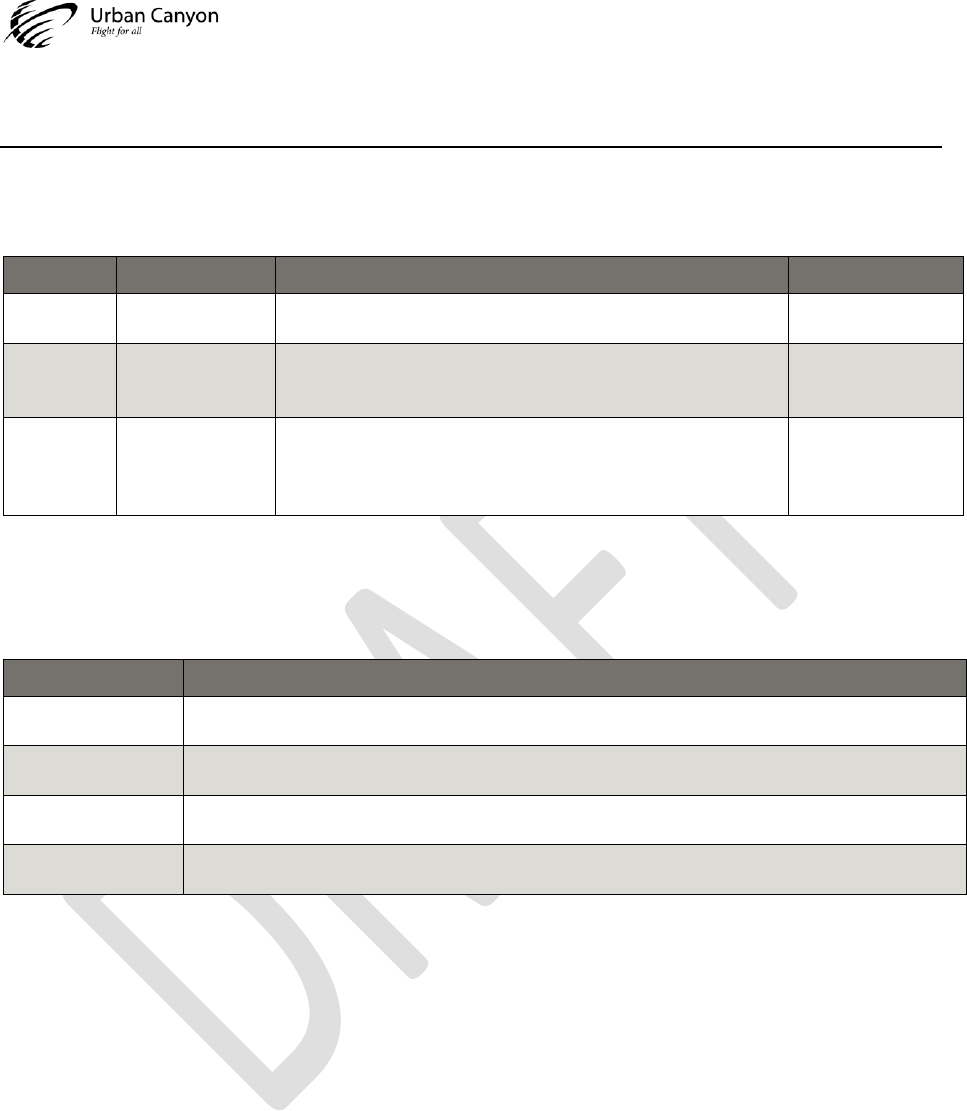
UC10x Installation Manual
URBAN CANYON FLIGHT INC UC10X-001-IM REV02
CONFIDENTIAL & PROPRIETARY PAGE 8 OF 69
1 Document
1.1 Revision History
Table 1. Document Revision History
Revision
Date
Description
Author
00
01 Oct 2016
Initial Draft
A. Hasegawa
01
08 Sep 2017
Updated part number, TSO disclaimer for draft release, FCC
information, basic interconnect diagram
C. Peckham
02
26 Sep 2017
Incorporated feedback from TCB: removed FCC logo from
labels, fixed MPE 20cm typo, changed “contains module”
to ”contains certified transmitter”
C. Peckham
1.2 Product Documents
Table 2. Documents Related to UC10x Products
Doc#
Title
UC10x-001-IM
UC10x Installation Manual
UC10x-001-DS
UC10x Datasheet
UC10x-001-ICD
UC10x Interface Control Document
UC10x-001-UG
UC10x User Guide
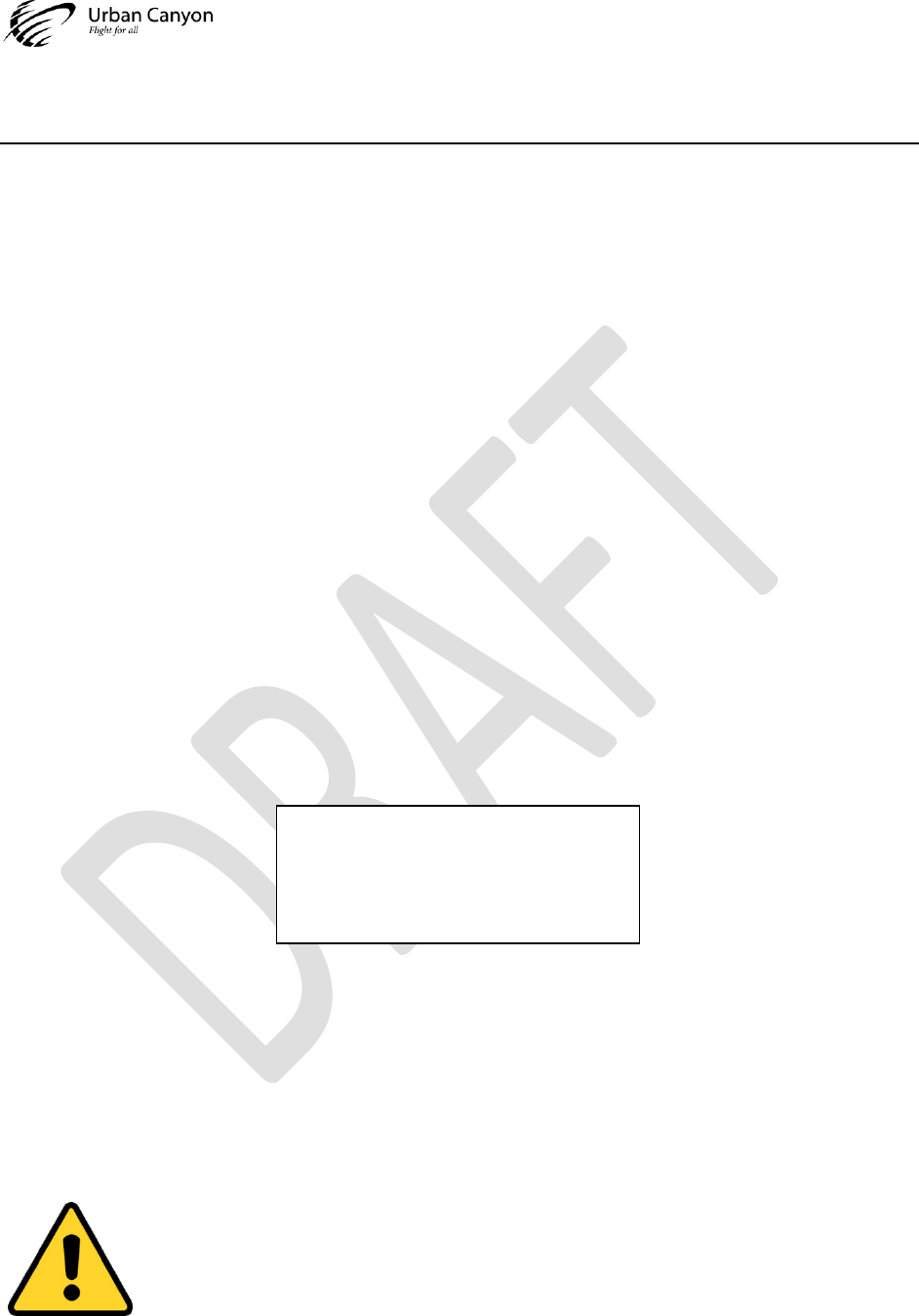
UC10x Installation Manual
URBAN CANYON FLIGHT INC UC10X-001-IM REV02
CONFIDENTIAL & PROPRIETARY PAGE 9 OF 69
2 Limited Warranty
This Urban Canyon Flight product is warranted to be free from defects in materials or workmanship for a period of
two (2) years from the date of purchase. Urban Canyon Flight will—at its sole option—refund, repair, or replace
any components that fail in normal use during the warranty period. Such repairs or replacement will be made at no
charge to the customer for parts or labor, provided that the customer shall be responsible for all costs related to
transportation. This warranty does not cover failures due to abuse, misuse, accident or unauthorized alteration or
repairs. To determine failure root cause, customer may be required to provide information regarding the interface,
including but not limited to electrical block diagrams/schematics, mounting drawings and fasteners, cable
drawings, and production and assembly techniques used. Providing this information will help to determine if
failure occurred under normal use, and will help with product improvement.
The warranties and remedies contained herein are exclusive and in lieu of all other warranties express or implied
or statutory, including any liability arising under any warranty of merchantability or fitness for a particular purpose,
statutory or otherwise. This warranty gives you specific legal rights, which may vary from state to state. In no event
shall Urban Canyon flight be liable for incidental, special, indirect or consequential damages, whether resulting
from the use, misuse, or inability to use this product or from defects in the product. Some states do not allow the
exclusion of incidental or consequential damages, so the above limitations may not apply to you.
Urban Canyon Flight retains the exclusive right to repair or replace the unit or software or offer a full refund of the
purchase price at its sole discretion. Such remedy shall be your sole and exclusive remedy for any breach of
warranty. To obtain warranty service, contact Urban Canyon Flight Authorized Service Center. For assistance in
locating a Service Center near you, call Urban Canyon Flight Customer Service at one of the numbers shown below.
2.1 Unpack and Inspect Before Use
Unpack the unit with caution. Before installation, visually inspect for transport damages. If the unit is damaged,
notify the shipping company to file a claim for the damage. To justify the claim, save the original packaging
materials and shipping container. Store packing material within shipping container for reshipment, if necessary.
2.2 Do not disassemble
This product is not intended to be disassembled. Do not attempt to open the enclosure.
WARNING: Any attempt to disassemble or open the enclosure will void the warranty and may
result in personal injury or permanent product damage.
Urban Canyon Flight
145 E Jewett Blvd STE 301
White Salmon, Washington 98672 U.S.A.
Phone: 509-493-XXXX
Fax: 509-493-XXXX
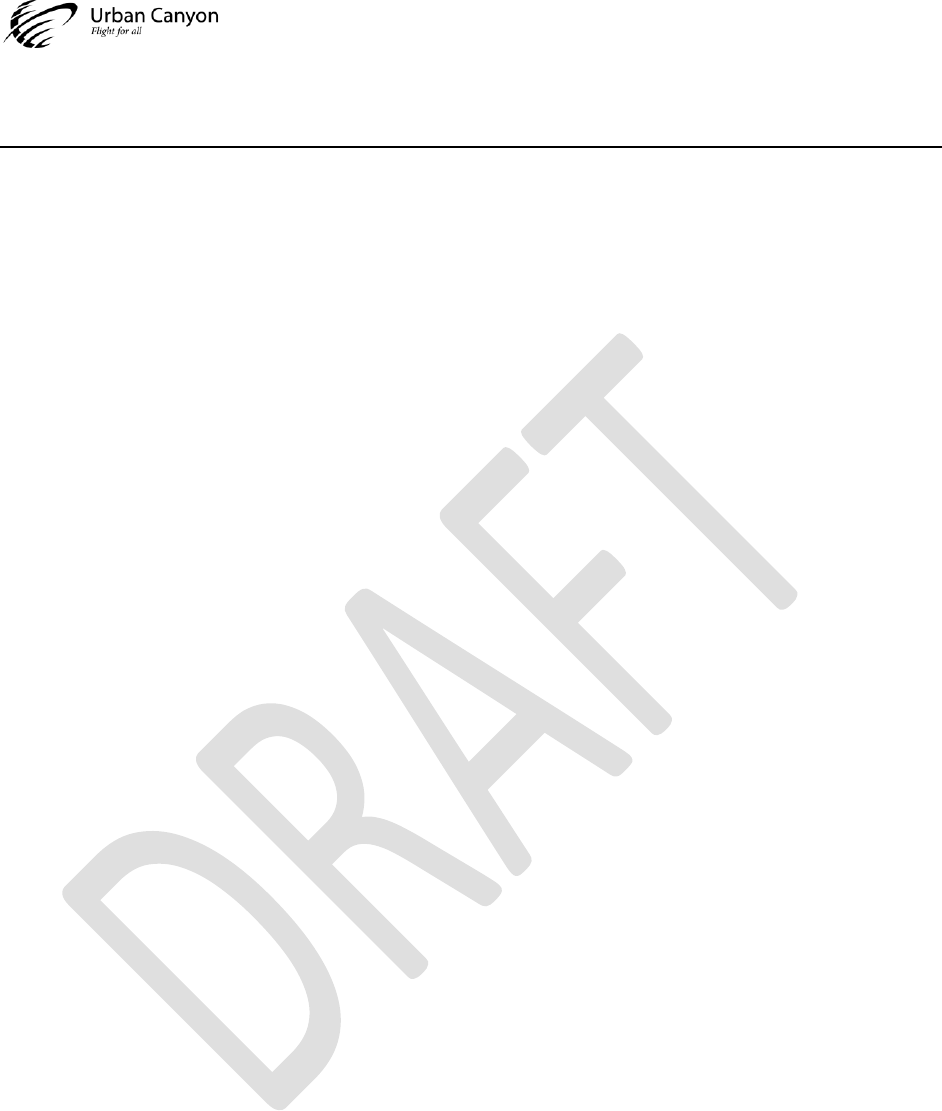
UC10x Installation Manual
URBAN CANYON FLIGHT INC UC10X-001-IM REV02
CONFIDENTIAL & PROPRIETARY PAGE 10 OF 69
3 Software License Agreement
By using an Urban Canyon Flight Transponder, you agree to be bound by the terms and conditions of the following
license agreement. Please read this carefully.
Urban Canyon Flight grants you a limited license to use the software embedded in this device (the “Software”) in
binary executable form in the normal operation of the product. Title, ownership rights and intellectual property
rights in and to the Software remain in Urban Canyon Flight.
You acknowledge that the Software is the property of Urban Canyon Flight and is protected under the United
States of America copyright laws and international copyright treaties. You further acknowledge that the structure,
organization and code of the Software are valuable trade secrets of Urban Canyon Flight and that the Software in
source code form remains a valuable trade secret of Urban Canyon Flight. You agree not to decompile,
disassemble, modify, reverse assemble, reverse engineer or reduce to human readable form the Software or any
part thereof or create any derivative works based on the Software. You agree not to export or re-export the
Software to any country in violation of the export control laws of the United States of America.
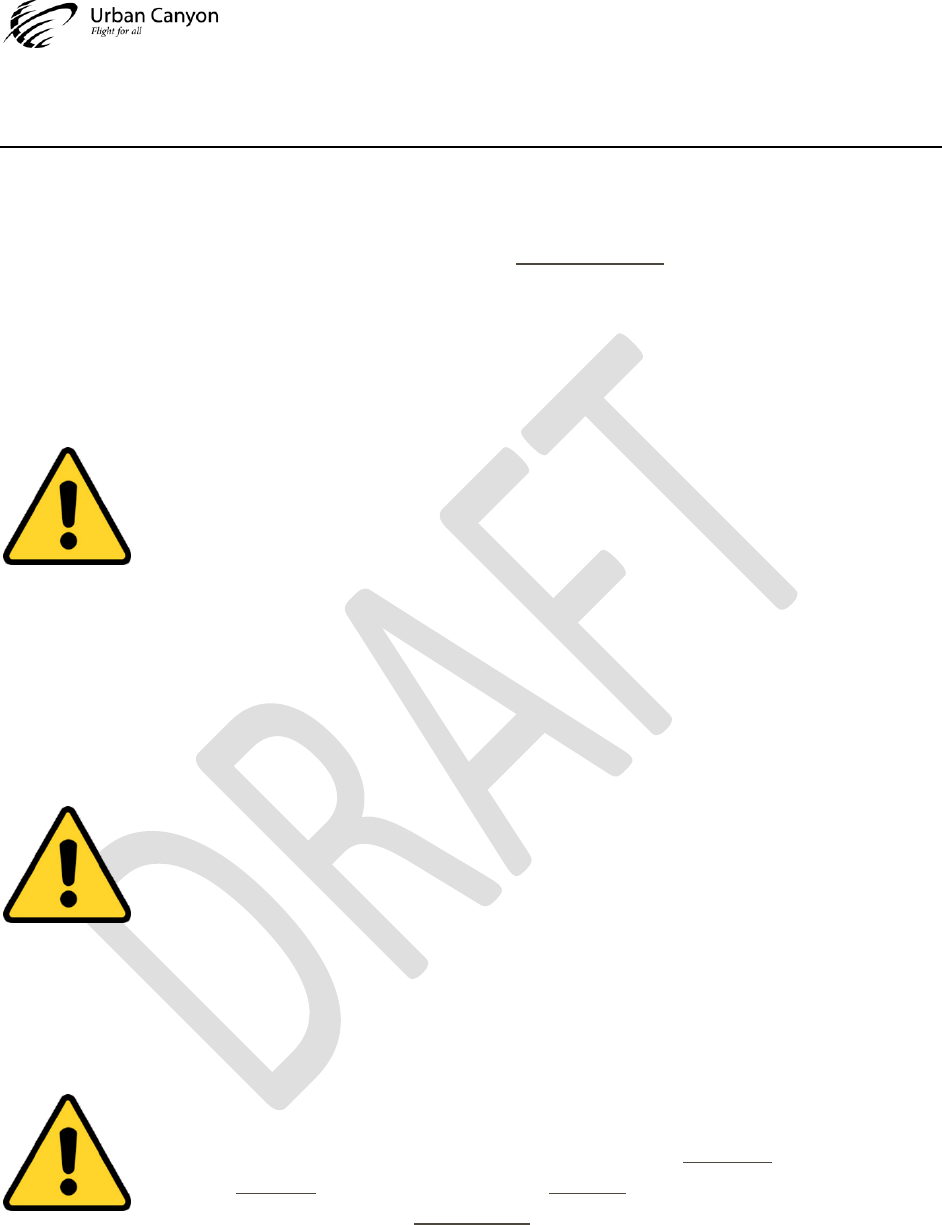
UC10x Installation Manual
URBAN CANYON FLIGHT INC UC10X-001-IM REV02
CONFIDENTIAL & PROPRIETARY PAGE 11 OF 69
4 Safety and Security
4.1 For your safety
To prevent damage to your product or injury to you or to others, please read the following safety precautions in
their entirety before using the product and visit our website at www.ucflight.com to obtain further / current safety
and security information.
4.2 Safe Exposure Limits
It is the responsibility of the UC10x owner to ensure the maximum radiofrequency (RF) radiation exposure limits
are not exceeded.
WARNING: A separation distance of 40 cm must be provided between the antenna and all
persons.
4.3 Use only provided and/or recommended cables & accessories
Only use cables, antennas, and power sources provided with the Product, or recommended herein, or as required
in appropriate regulatory documents such as applicable TSO(s) / MOPS.
4.4 Licensing
It is the responsibility of the UC10x owner to obtain proper licensing before using the transponder.
WARNING: This equipment has received an FAA transmit license for manned aircraft and a
license for unmanned aircraft operating above 500 ft. AGL.
4.5 Professional Installation Disclaimer
The purpose of this document is to assist OEMs in integrating the UC10x family into their equipment designs.
The UC10x family is intended to be professionally integrated by OEMs into their equipment designs.
WARNING: Changes or modifications not expressly approved by the manufacturer could void the
user’s authority to operate the equipment. The installer shall be responsible for ensuring that the
proper antenna is employed so that the antenna requirements of TSO-C112E (RTCA/DO-181E
§2.215) or TSO-C74d (RTCA/DO-144A §2.2.11) or TSO-C66c (RTCA/DO-189 §2.2.17), as
applicable, are met and limits of 47 CFR 87.131 are not exceeded.
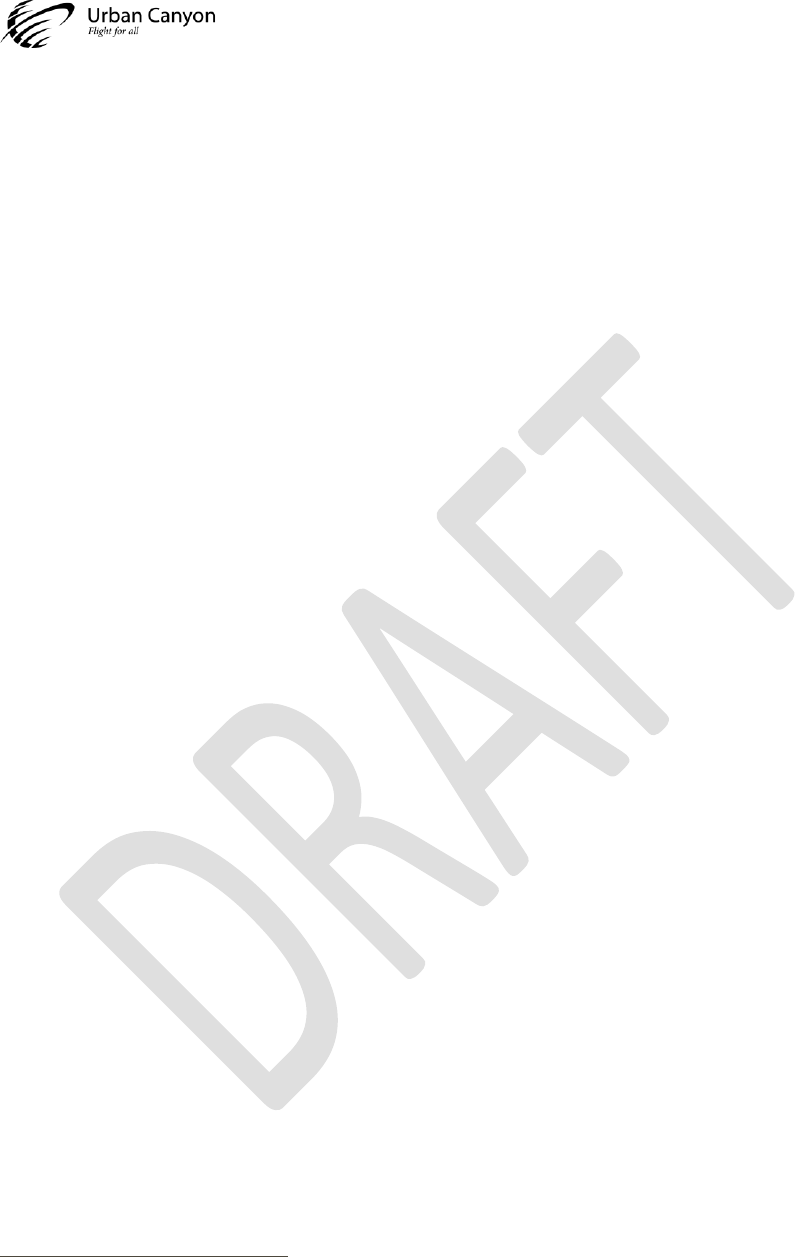
UC10x Installation Manual
URBAN CANYON FLIGHT INC UC10X-001-IM REV02
CONFIDENTIAL & PROPRIETARY PAGE 12 OF 69
4.6 Design Approval
The conditions and tests required for the TSO approval
1
of the UC10x (UC100, UC101, UC102 and UC103)
Transponders are minimum performance standards. The TSO identifies the minimum performance standards,
tests, and other conditions applicable for issuance of design and production approval of the article. TSO approval is
the responsibility of the aviation authority (FAA) and is in progress for UC10x
2
.
4.7 Installation Approval
The equipment should be installed in the aircraft in a manner consistent with acceptable workmanship and
engineering practices and in the accordance with the instructions set forth in this publication. To ensure that the
system has been properly and safely installed in the aircraft, the installer should make a thorough visual inspection
and conduct an overall operational check of the system on the ground prior to flight.
The TC or STC provides installation approval from the FAA. This installation manual (IM) is intended to assist with
installation and integration, but does not provide FAA-certified installation approval. This is a separate process.
1
FAA certifications in progress
2
TSO approval is for design and manufacturing. Thus, customers requiring TSO-approved units, will be required to
purchase new units. In other words, there is no way to “retrofit” a non-TSO unit into a TSO unit at a later date, it is
simply not practical.
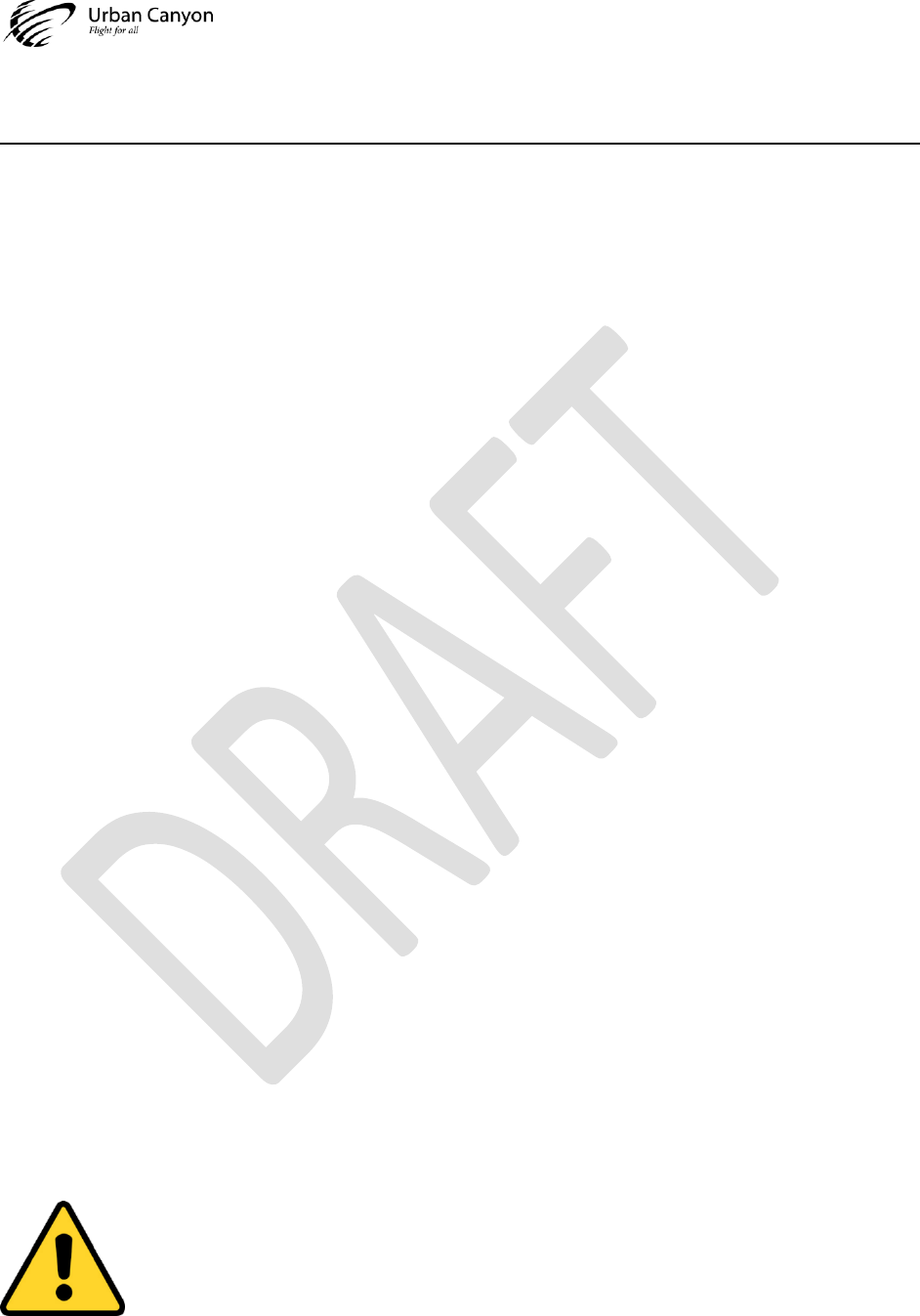
UC10x Installation Manual
URBAN CANYON FLIGHT INC UC10X-001-IM REV02
CONFIDENTIAL & PROPRIETARY PAGE 13 OF 69
5 FCC Certification and Compliance
This section provides warning statements/disclaimers required by the FCC. Additionally, this section provides
operating requirements and labeling requirements that comply with FCC requirements.
Compliance with this section does not guarantee authorization of use. Requirements of other regulatory bodies
(such as FAA and ICAO), discussed in part elsewhere in this document, will be required depending on the specific
use case. Understanding the regulations are the sole responsibility of the end user.
Changes or modifications not expressly approved by the manufacturer could void the user’s authority to operate
the equipment.
5.1 FCC ID
The UC10x family FCC ID is 2ANAE-UC10X
5.2 FCC Radiation Exposure Statements
This equipment complies with FCC radiation exposure limits set for an uncontrolled environment. This equipment
should be installed and operated with a minimum distance of 40 cm maintained between the radiator and any
persons when the transponder is powered on and the radio in an active mode.
The antenna(s) used for this transmitter must not be co-located (within 40 cm) or operating in conjunction with
any other antenna or transmitter.
5.3 FCC Interference Statements
This equipment has been tested and found to comply with the limits for a Class B digital device, pursuant to Part
15 of the FCC Rules. These limits are designed to provide reasonable protection against harmful interference in a
residential installation. This equipment generates uses and can radiate radio frequency energy and, if not installed
and used in accordance with the instructions, may cause harmful interference to radio communications. However,
there is no guarantee that interference will not occur in a particular installation. If this equipment does cause
harmful interference to radio or television reception, which can be determined by turning the equipment off and
on, the user is encouraged to try to correct the interference by one of the following measures:
• Reorient or relocate the receiving antenna.
• Increase the separation between the equipment and receiver.
• Connect the equipment into an outlet on a circuit different from that to which the receiver is connected.
• Consult the dealer or an experienced radio/TV technician for help.
This device complies with Part 15 of the FCC Rules [and with Industry Canada (IC) license-exempt RSS standard(s)].
Operation is subject to the following two conditions: (1) This device may not cause harmful interference, and (2)
this device must accept any interference received, including interference that may cause undesired operation.
FCC CAUTION: Any changes or modifications not expressly approved by the party responsible for
compliance could void the user's authority to operate this equipment.
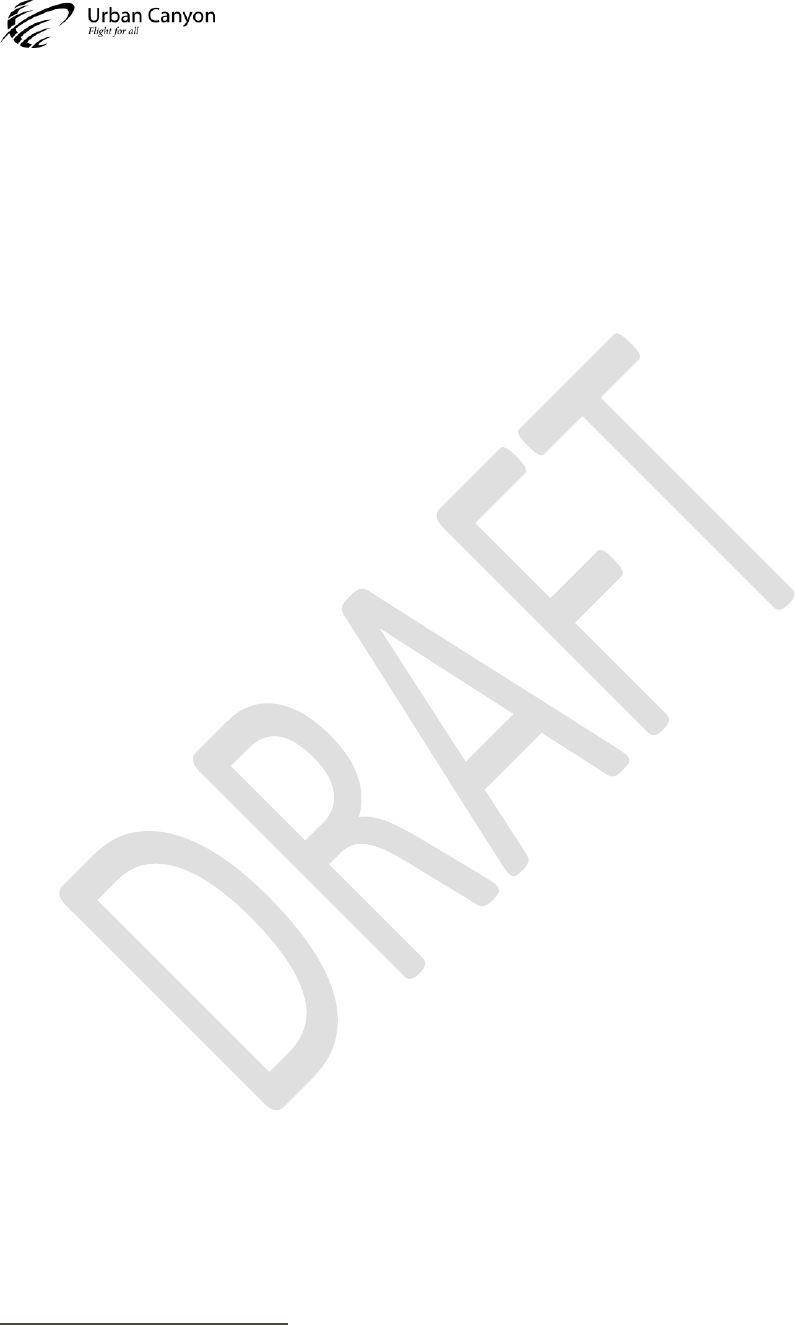
UC10x Installation Manual
URBAN CANYON FLIGHT INC UC10X-001-IM REV02
CONFIDENTIAL & PROPRIETARY PAGE 14 OF 69
5.4 FCC OEM Labeling Requirements for End-Product
The device is labeled with its own FCC ID Certification Number. In the event that the device is installed within
another device, and the FCC ID Certification Number is not visible, the end device into which the device is installed
must display a label referring to the enclosed certified transmitter. The final end product must be labeled in a
visible area with the following:
"Contains Certified Transmitter FCC ID: 2ANAE-UC10X"
or
"Contains FCC ID: 2ANAE-UC10X"
The OEM must only use approved antenna(s) listed above, which have been certified with the device.
5.5 FCC OEM End-Product User Manual Statements
The OEM integrator should not provide information to the end user regarding how to install or remove this RF
certified transmitter or change RF related parameters in the user manual of the end product.
Other user manual statements may apply.
Compliance statement only valid if used with certified/approved antenna or antenna types. See list of approved
antenna(s)/antenna characteristics.
Label must be placed on enclosure exterior and must be clearly visible.
5.6 FCC-Compliant Antenna & Cable
5.6.1 Minimum Cable Loss
The minimum cable loss is 0 dB (direct connection to antenna).
No external amplifier is allowed.
5.6.2 Maximum Cable Loss
The maximum cable loss is 1.5 dB.
5.6.3 Antenna Gain
Antenna Information: 1030-1090 MHz, linearly-polarized antenna, Gain: 5.2 dBi max
3
.
3
See section 11.4 Antenna for more information on antenna requirements.
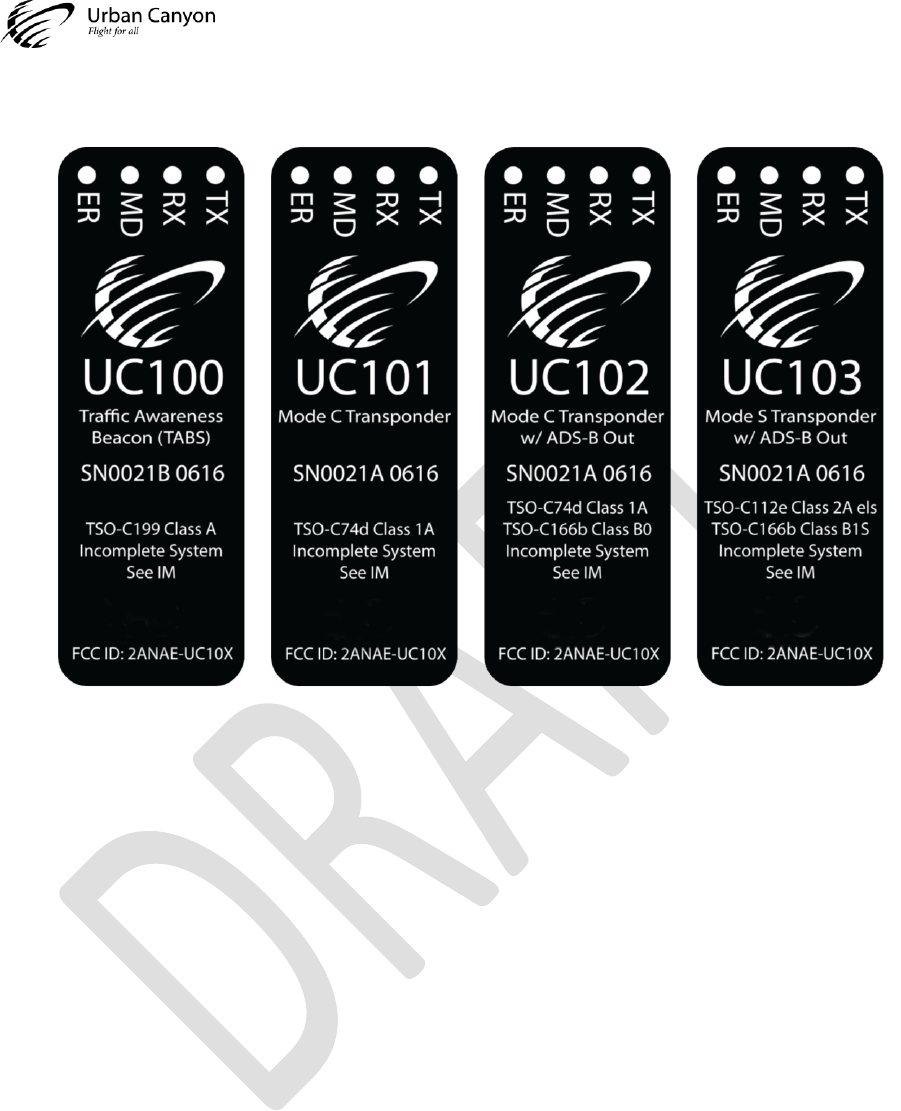
UC10x Installation Manual
URBAN CANYON FLIGHT INC UC10X-001-IM REV02
CONFIDENTIAL & PROPRIETARY PAGE 15 OF 69
5.7 Product Label
Figure 1. UC10x Product Labels (SCALE 2:1)
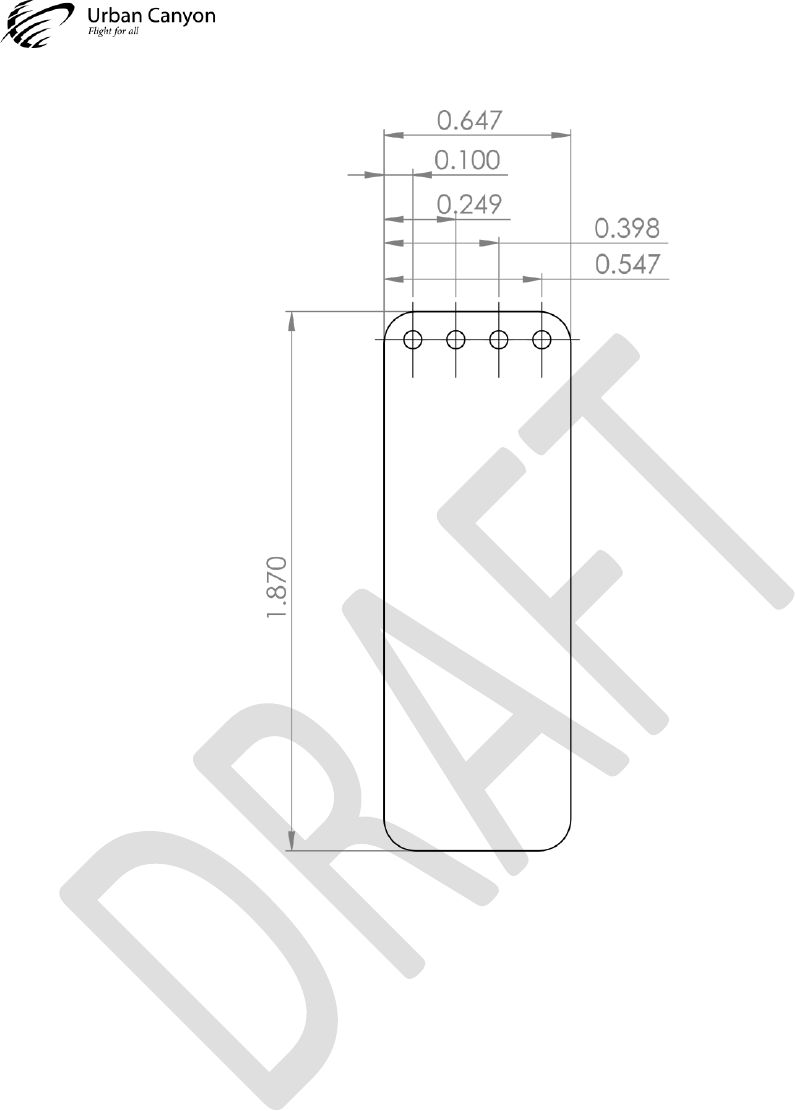
UC10x Installation Manual
URBAN CANYON FLIGHT INC UC10X-001-IM REV02
CONFIDENTIAL & PROPRIETARY PAGE 16 OF 69
Figure 2. UC10x Product Label Mechanical Drawing (SCALE 2:1)
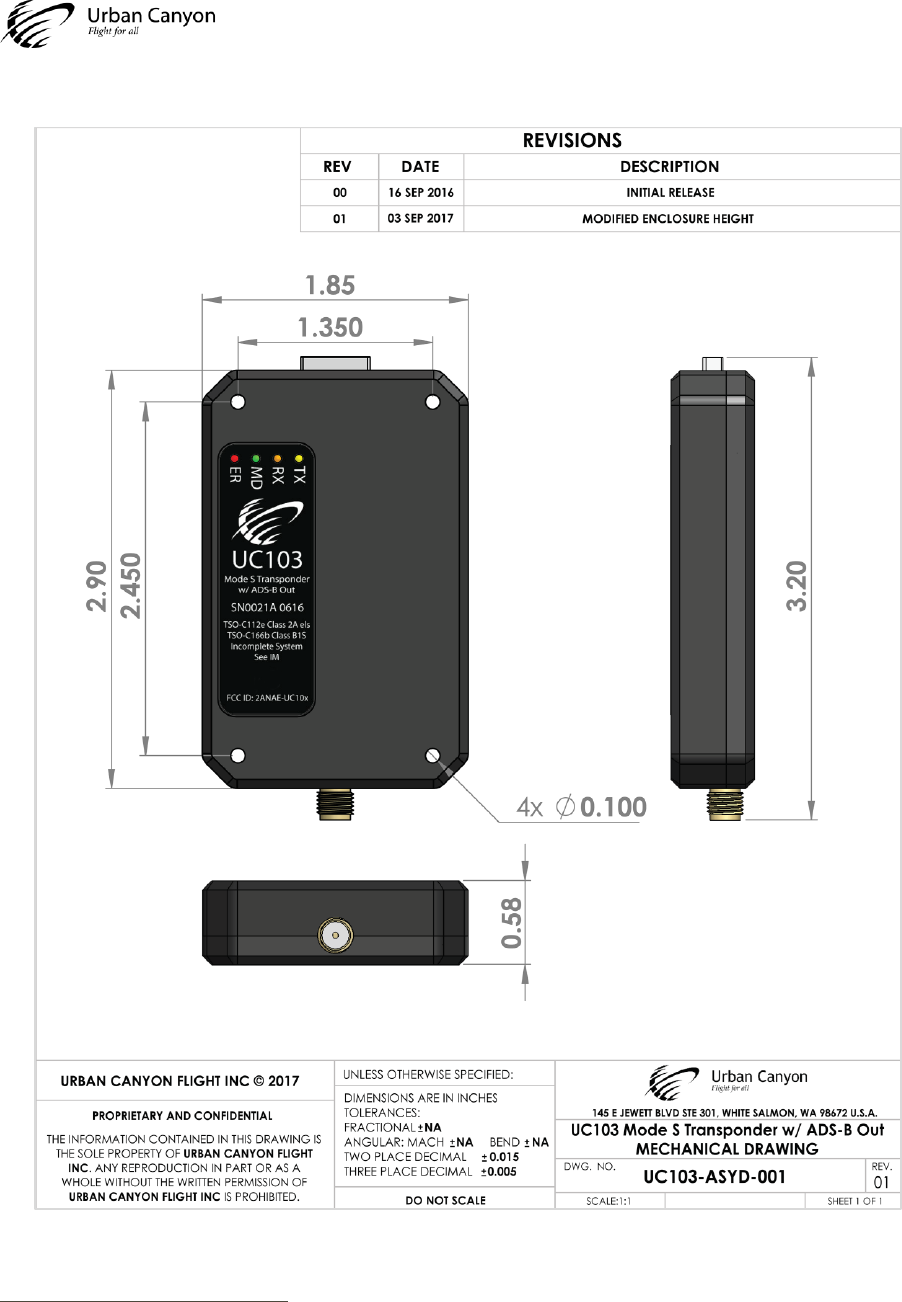
UC10x Installation Manual
URBAN CANYON FLIGHT INC UC10X-001-IM REV02
CONFIDENTIAL & PROPRIETARY PAGE 17 OF 69
5.7.1 Product Label Location
Figure 3. UC10x Mechanical Drawing with Label Location (SCALE 1:1)
4
4
NOTE: this is a simplified drawing. Contact us for ASME Y14.5 / ISO 16792 fully-specified drawing appropriate for
ISO9001/AS9100 Quality Management Systems (QMS) (in progress).
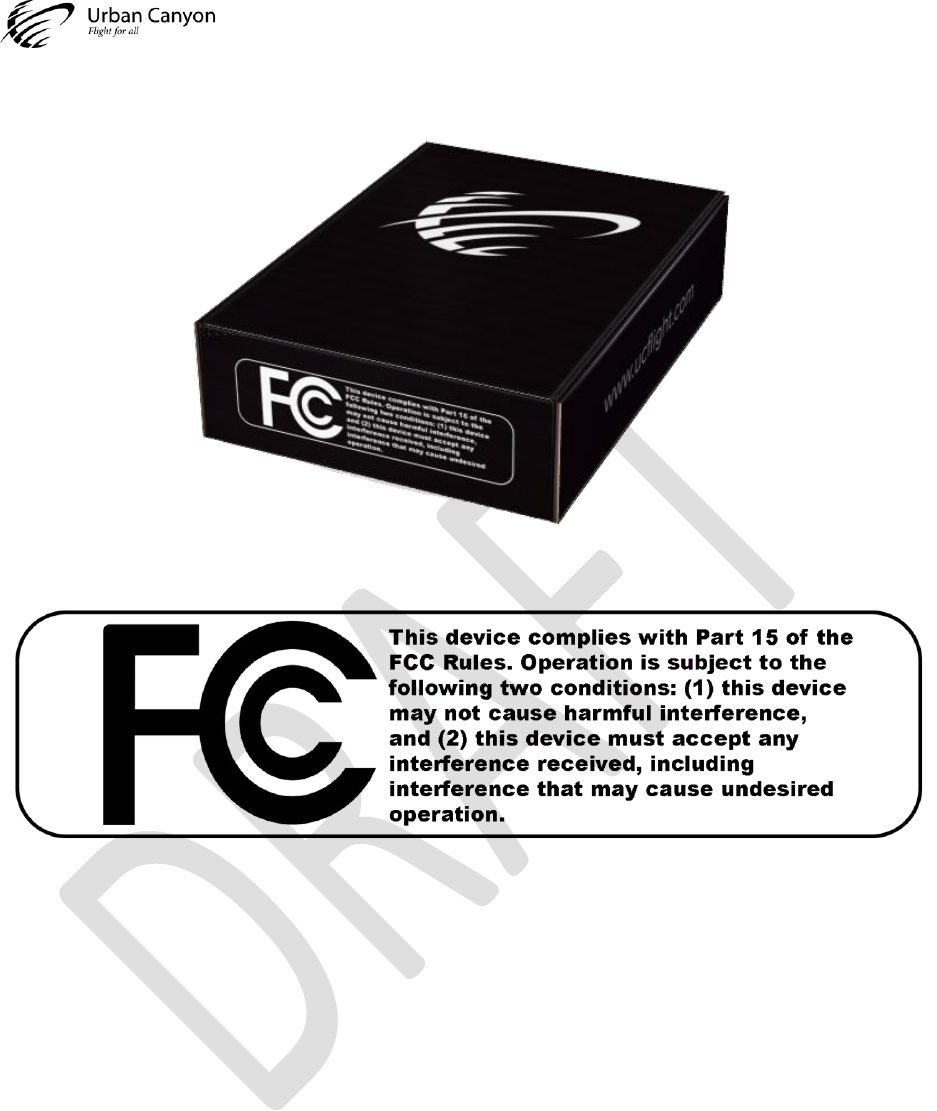
UC10x Installation Manual
URBAN CANYON FLIGHT INC UC10X-001-IM REV02
CONFIDENTIAL & PROPRIETARY PAGE 18 OF 69
5.7.2 Product Box Label
Figure 4. FCC Part 15 Declaration of Conformity – Location on 4 x 3 x 1” Product Box
Figure 5. FCC Part 15 Declaration of Conformity – Language on Product Box
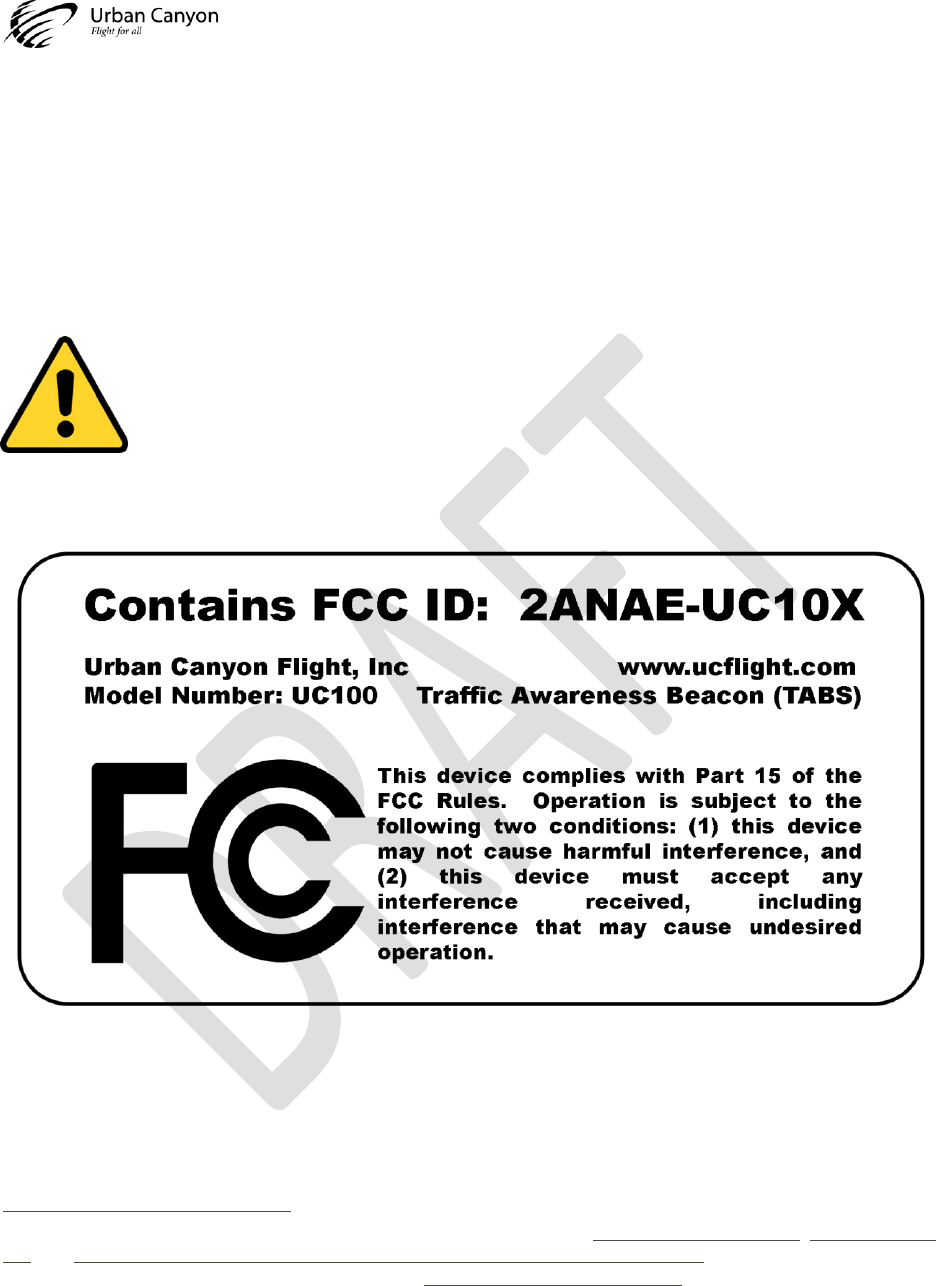
UC10x Installation Manual
URBAN CANYON FLIGHT INC UC10X-001-IM REV02
CONFIDENTIAL & PROPRIETARY PAGE 19 OF 69
5.8 Electronic Labeling (E-Label)
The E-LABEL Act of 2014
5
allows manufacturers to display labeling electronically, using a display.
The UC10x is an incomplete system, and does not include a physical display.
OEMs integrating the UC10x into their equipment designs are required to provide a human interface to the pilot /
remote pilot, and must provide an electronic label consistent with FCC requirements
6
7
. Figure 6, Figure 7, Figure 8,
and Figure 9 below provide example electronic label for UC100, UC101, UC102, and UC103, respectively.
FCC CAUTION: It is the responsibility of the installer to confirm this label meets all requirements
for their application and local regulatory requirements
5.8.1.1 Example UC100 E-Label
Figure 6. Example Electronic Label for Model Number UC100
5
For more background information on this relatively recent legislation, see H.R.5161 – E-LABEL Act, Public Law 113-
197, and FCC 15-92 NOTICE OF PROPOSED RULEMAKING, Adopted July 17, 2015.
6
See FCC Electronic Labeling Guidance contained in KDB 784748 D02 e labelling v01
7
This section focuses on human interface requirements for compliance with FCC regulations. Additional human
interface requirements can be found in the TSO(s) and MOPS, and other locations, depending on product and use case.
This is not intended to be a comprehensive list of requirements pertaining to the UC10x human interface.
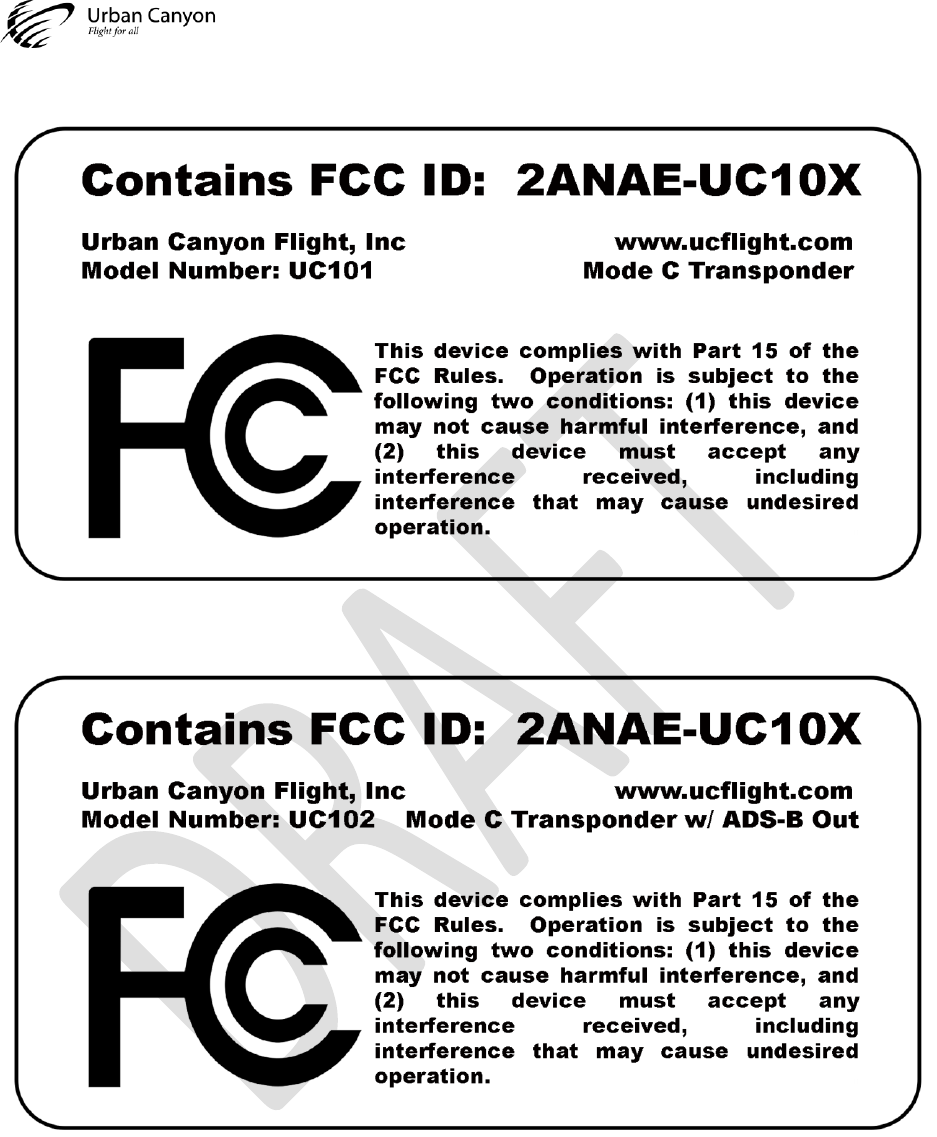
UC10x Installation Manual
URBAN CANYON FLIGHT INC UC10X-001-IM REV02
CONFIDENTIAL & PROPRIETARY PAGE 20 OF 69
5.8.1.2 Example UC101 E-Label
Figure 7. Example Electronic Label for Model Number UC101
5.8.1.3 Example UC102 E-Label
Figure 8. Example Electronic Label for Model Number UC102
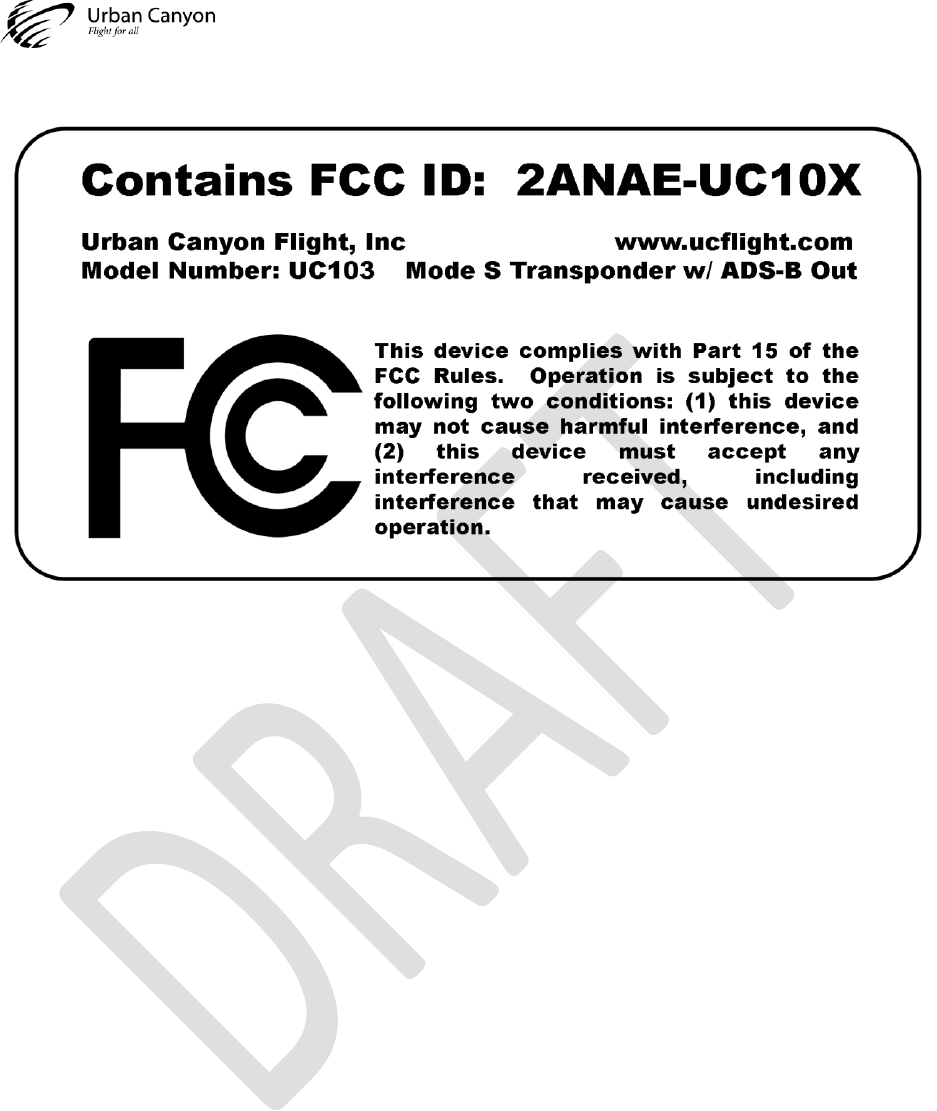
UC10x Installation Manual
URBAN CANYON FLIGHT INC UC10X-001-IM REV02
CONFIDENTIAL & PROPRIETARY PAGE 21 OF 69
5.8.1.4 Example UC103 E-Label
Figure 9. Example Electronic Label for Model Number UC103
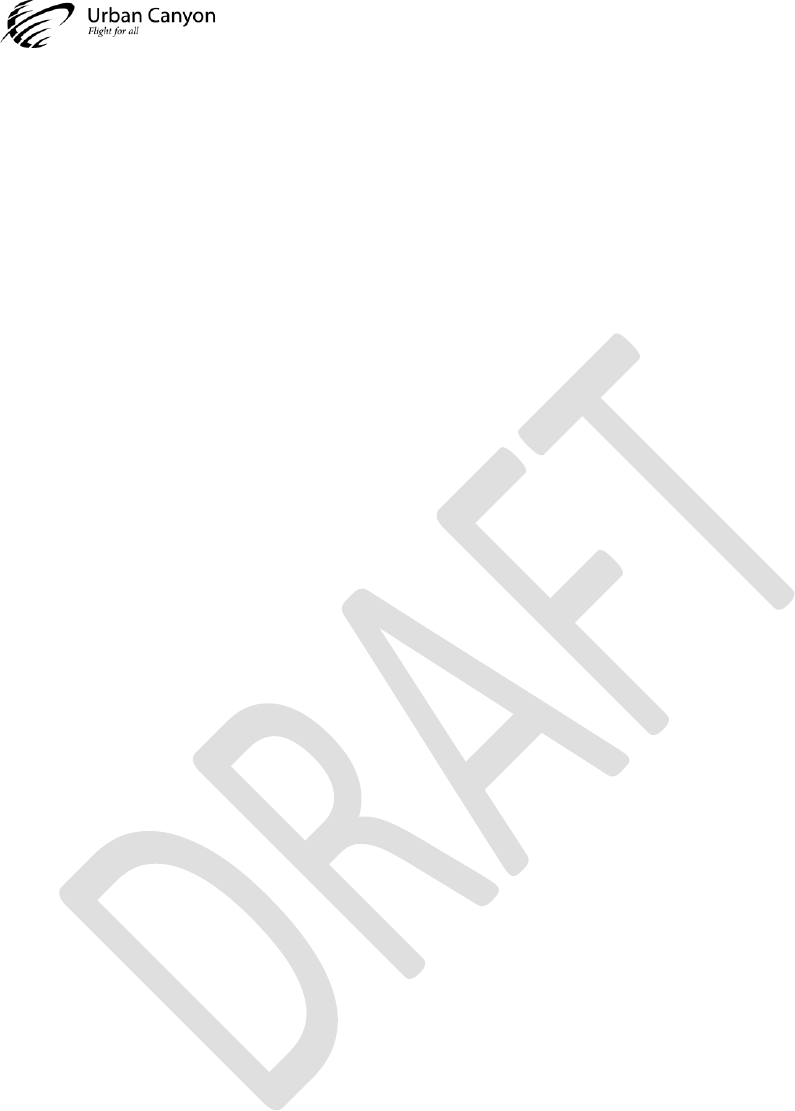
UC10x Installation Manual
URBAN CANYON FLIGHT INC UC10X-001-IM REV02
CONFIDENTIAL & PROPRIETARY PAGE 22 OF 69
This page intentionally left blank.
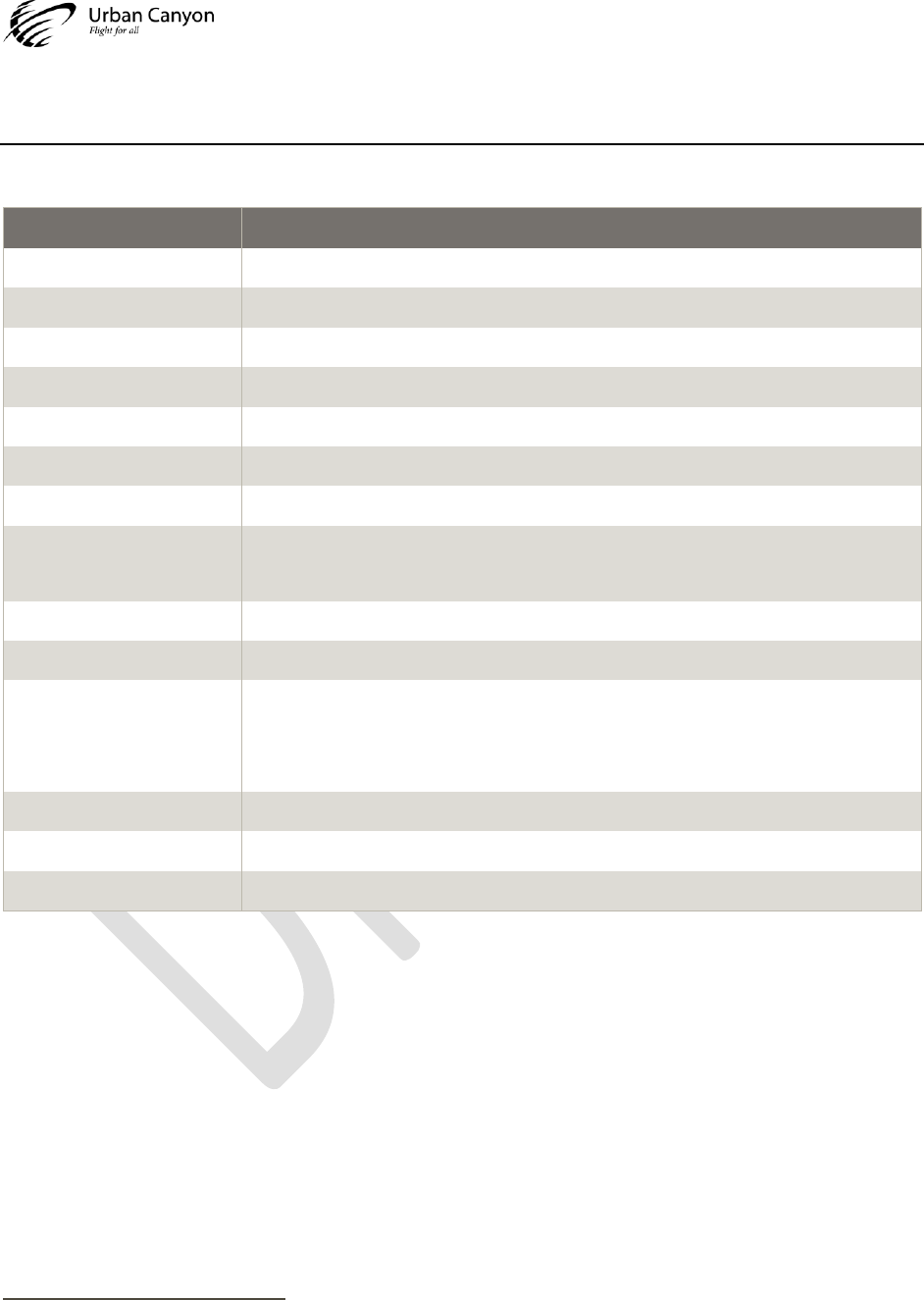
UC10x Installation Manual
URBAN CANYON FLIGHT INC UC10X-001-IM REV02
CONFIDENTIAL & PROPRIETARY PAGE 23 OF 69
6 Regulatory & Technical Overview
6.1 UC100 Traffic Awareness Beacon System (TABS)
8
Specification
Characteristics
Compliance
TSO-C199 Class A
FCC ID
2ANAE-UC10X
Applicable Documents
RTCA/DO-181E, RTCA/DO-260B (requirements modified directly in TSO-C199)
Software
RTCA/DO-178C Level C
Hardware
RTCA/DO-254 Level C
Power Requirements
10-38 VDC. Typical 0.5 watt @ 28V (
Altitude
100,000 ft.
Humidity
95% @ 50°C for 6 hours; 85% @ +38°C for 16 hours
Tested to RTCA/DO-160G §6.0 Category A
Operating Temperature
-20°C to +70°C (DO-160G Categories A2, C1)
Transmit Frequency
1090 MHz ± 1 MHz
Transmitter
53 dBm (200W) nominal at RF connector (SMA)
51 dBm (125W) minimum at antenna
Provides for 1.5 dB loss in cable + connectors
Transmitter Modulation
5M65M1D
Receiver Frequency
1030 MHz
Receiver Sensitivity
-74 dBm ± 3 dB (TCAS Replies), -71 dBm ±3 dB (Ground Replies)
8
FAA certifications in progress
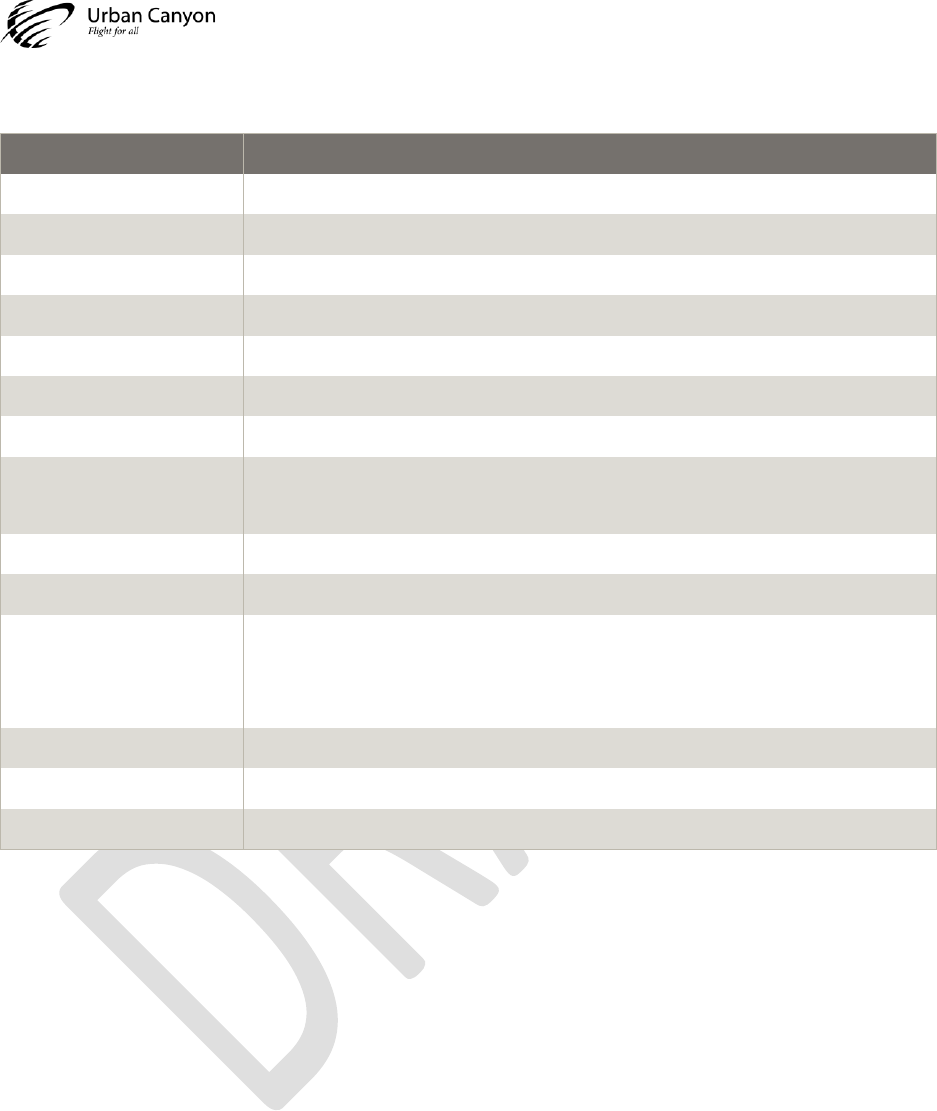
UC10x Installation Manual
URBAN CANYON FLIGHT INC UC10X-001-IM REV02
CONFIDENTIAL & PROPRIETARY PAGE 24 OF 69
6.2 UC101 Mode C Transponder8
Specification
Characteristics
Compliance
TSO-C74d Class 1A
FCC ID
2ANAE-UC10X
Applicable Documents
RTCA/DO-144A
Software
RTCA/DO-178C Level C
Hardware
RTCA/DO-254 Level C
Power Requirements
10-38 VDC. Typical 0.8 watt @ 28V
Altitude
100,000 ft.
Humidity
95% @ 50°C for 6 hours; 85% @ +38°C for 16 hours
Tested to RTCA/DO-160G §6.0 Category A
Operating Temperature
-20°C to +70°C (DO-160G Categories A2, C1)
Transmit Frequency
1090 MHz ± 1 MHz
Transmitter
53 dBm (200W) nominal at RF connector (SMA)
51 dBm (125W) minimum at antenna
Provides for 1.5 dB loss in cable + connectors
Transmitter Modulation
5M65M1D
Receiver Frequency
1030 MHz
Receiver Sensitivity
-74 dBm ± 3 dB
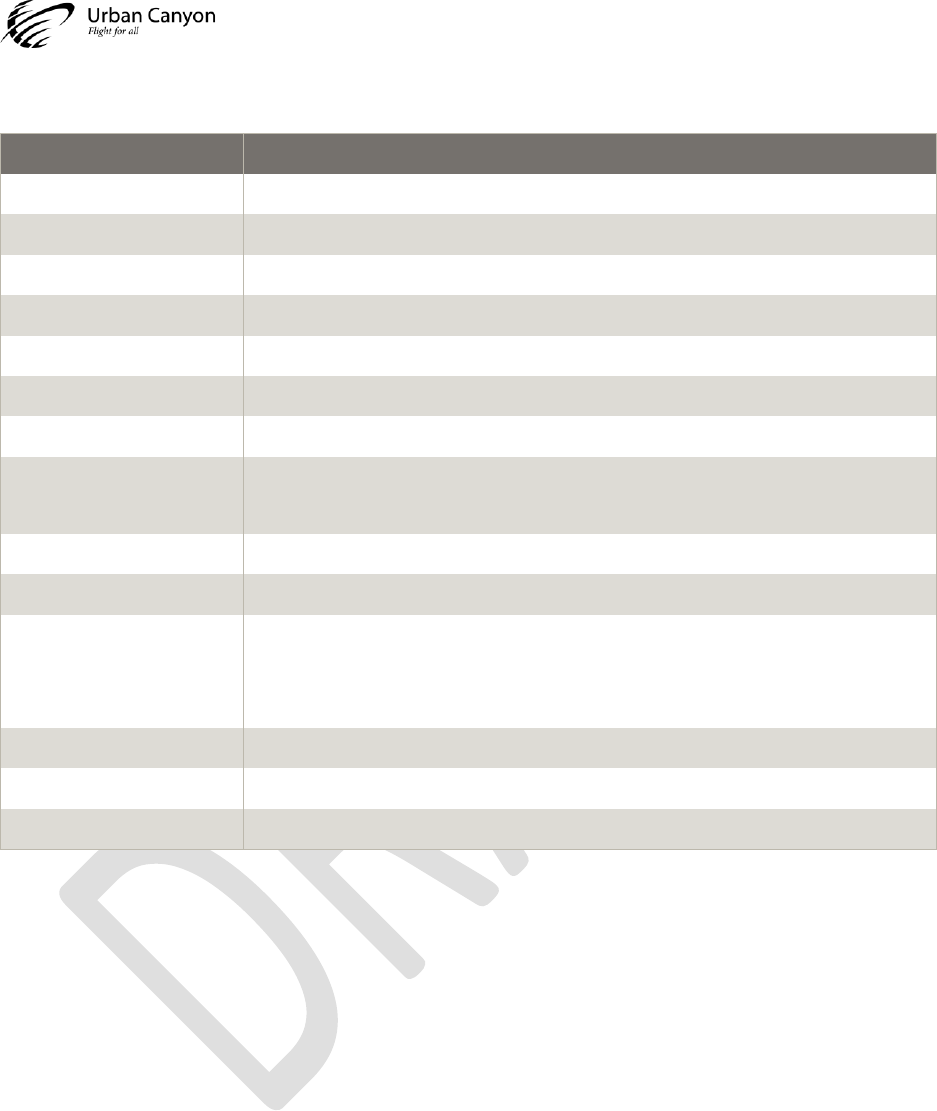
UC10x Installation Manual
URBAN CANYON FLIGHT INC UC10X-001-IM REV02
CONFIDENTIAL & PROPRIETARY PAGE 25 OF 69
6.3 UC102 Mode C Transponder with ADS-B Out8
Specification
Characteristics
Compliance
TSO-C74d Class 1A, TSO-C166b Class B0
FCC ID
2ANAE-UC10X
Applicable Documents
RTCA/DO-144A, RTCA/DO-260B w/ Corrigendum 1
Software
RTCA/DO-178C Level C
Hardware
RTCA/DO-254 Level C
Power Requirements
10-38 VDC. Typical 1.0 watt @ 28V
Altitude
100,000 ft.
Humidity
95% @ 50°C for 6 hours; 85% @ +38°C for 16 hours
Tested to RTCA/DO-160G §6.0 Category A
Operating Temperature
-20°C to +70°C (DO-160G Categories A2, C1)
Transmit Frequency
1090 MHz ± 1 MHz
Transmitter
53 dBm (200W) nominal at RF connector (SMA)
51 dBm (125W) minimum at antenna
Provides for 1.5 dB loss in cable + connectors
Transmitter Modulation
5M65M1D
Receiver Frequency
1030 MHz
Receiver Sensitivity
-74 dBm ± 3 dB
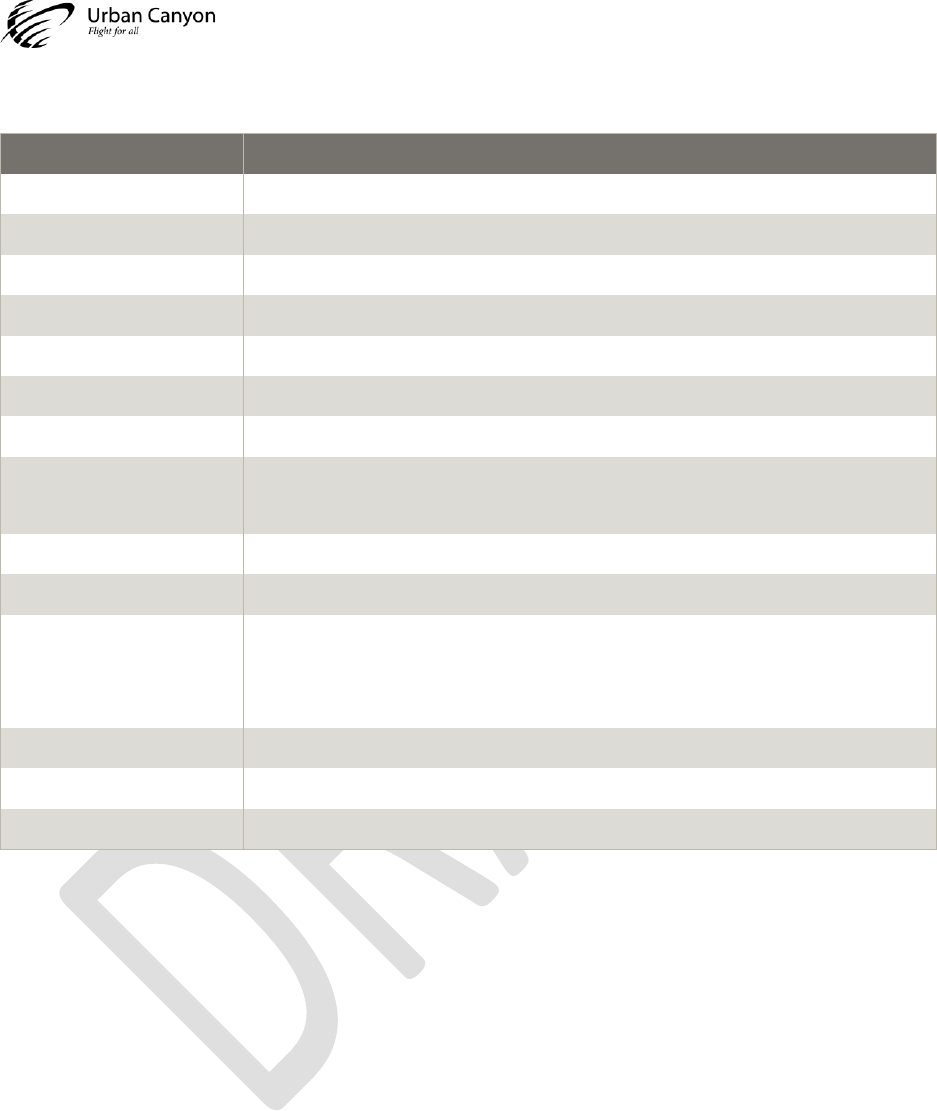
UC10x Installation Manual
URBAN CANYON FLIGHT INC UC10X-001-IM REV02
CONFIDENTIAL & PROPRIETARY PAGE 26 OF 69
6.4 UC103 Mode S Transponder with ADS-B Out8
Specification
Characteristics
Compliance
TSO-C112e Class 2A els, TSO-C166b Class B1S
FCC ID
2ANAE-UC10X
Applicable Documents
RTCA/DO-181E, RTCA/DO-260B w/ Corrigendum 1
Software
RTCA/DO-178C Level C
Hardware
RTCA/DO-254 Level C
Power Requirements
10-38 VDC. Typical 1.3 watt @ 28V
Altitude
100,000 ft.
Humidity
95% @ 50°C for 6 hours; 85% @ +38°C for 16 hours
Tested to RTCA/DO-160G §6.0 Category A
Operating Temperature
-20°C to +70°C (DO-160G Categories A2, C1)
Transmit Frequency
1090 MHz ± 1 MHz
Transmitter
53 dBm (200W) nominal at RF connector (SMA)
51 dBm (125W) minimum at antenna
Provides for 1.5 dB loss in cable + connectors
Transmitter Modulation
5M65M1D
Receiver Frequency
1030 MHz
Receiver Sensitivity
-74 dBm ± 3 dB
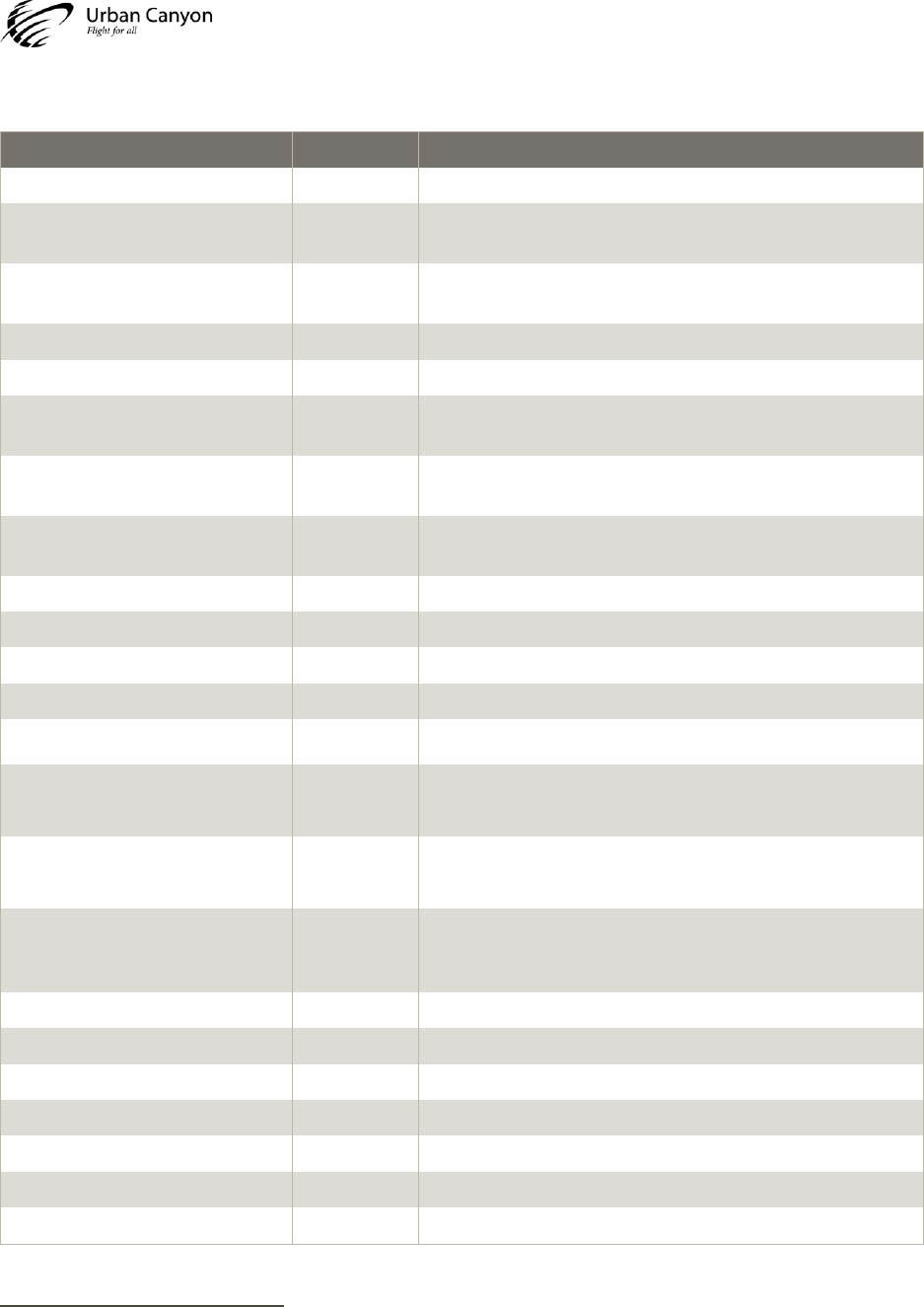
UC10x Installation Manual
URBAN CANYON FLIGHT INC UC10X-001-IM REV02
CONFIDENTIAL & PROPRIETARY PAGE 27 OF 69
6.5 Environmental Qualification Form
Test Conditions
DO-160G
Test Description9
Temperature and Altitude
4.0
Equipment tested to Categories A2, C1
Low Temperature Ground
Survival
4.5.1
-55°C (Category A2 and C1)
Low Temperature Short-Time
Operating
4.5.1
-40°C (Category A2 and C1)
Low Temperature Operating
4.5.2
-20°C (Category C1)
High Temperature Operating
4.5.4
+70°C (Category A2 and C1)
High Temperature Short-Time
Operating
4.5.3
+70°C (Category A2 and C1)
High Temperature Ground
Survival
4.5.3
+85°C (Category A2 and C1)
Loss of Cooling
4.5.5
Testing not required (unit does not require cooling, +70°C
operating without cooling air) (Category A2 and C1)
Altitude
4.6.1
100,000 feet (Category C1)
Decompression
4.6.2
8,000 to 100,000 feet in 15 seconds (Category A2)
Overpressure
4.6.3
-15,000 feet (Category A2)
Temperature Variation
5.0
Equipment tested to Category B
Humidity
6.0
Equipment tested to Category A
Operational Shocks
7.2
Equipment tested to Category B
Three 6g, 11ms shock in each orthogonal direction
Crash Safety
7.3
Equipment tested to Category B
One 20g, 11ms shock in each orthogonal direction
Vibration
8.0
Aircraft zones 1 (including 1a and 1b) and 2; aircraft type 3,
4, 5 to Category S Level L; aircraft type 1 (Helicopters) to
Category U2 Level F1
Explosion
9.0
Equipment identified as Category X – no test required
Waterproofness
10.0
Equipment identified as Category X – no test required
Fluids Susceptibility
11.0
Equipment identified as Category X – no test required
Sand and Dust
12.0
Equipment identified as Category X – no test required
Fungus
13.0
Equipment identified as Category X – no test required
Salt Spray
14.0
Equipment identified as Category X – no test required
Magnetic Effect
15.0
Equipment tested to Category Z
9
Planned tests
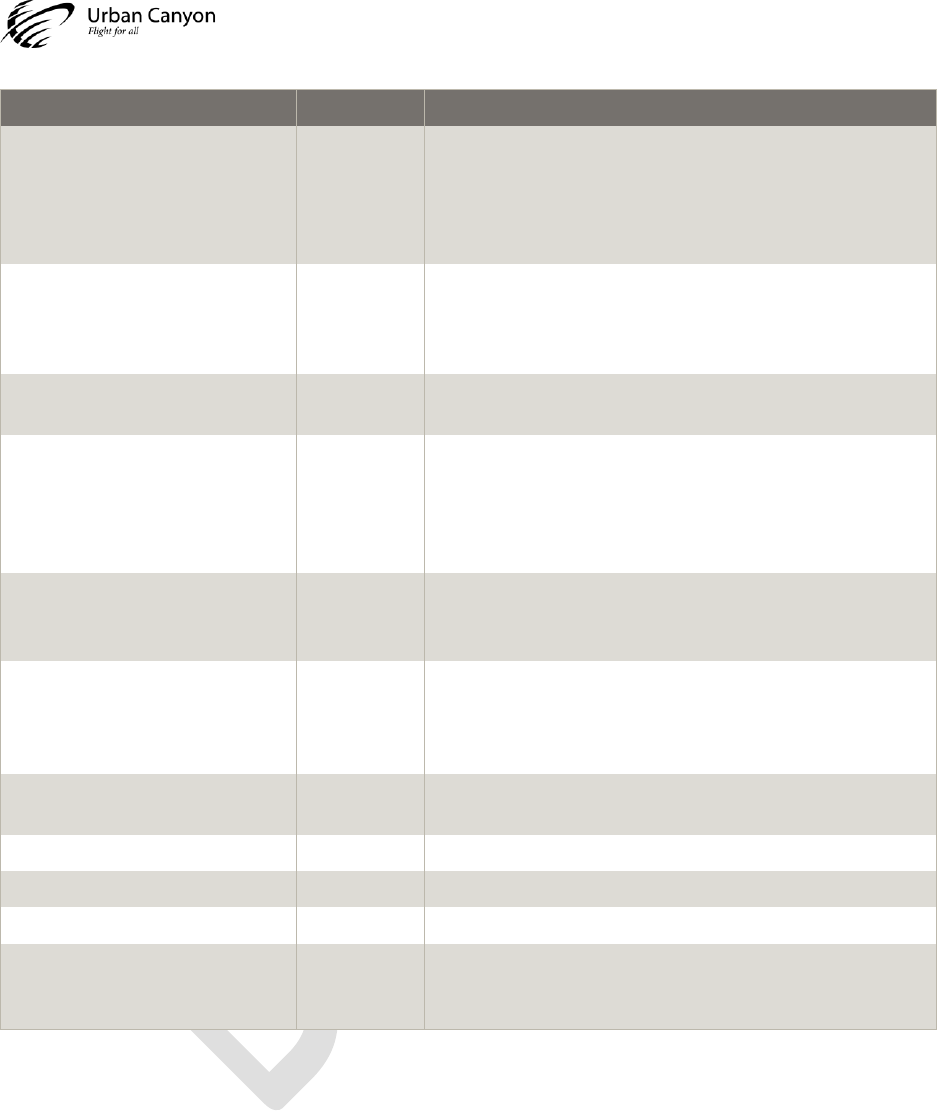
UC10x Installation Manual
URBAN CANYON FLIGHT INC UC10X-001-IM REV02
CONFIDENTIAL & PROPRIETARY PAGE 28 OF 69
Test Conditions
DO-160G
Test Description9
Power Input
16.0
Equipment tested to Category BXX for 28 V
• Normal Operation: 18.0 to 32.2 V
• Surge (high): 60 VDC for 100 ms + 40 VDC for 1
second
• Surge (low): 17 VDC for 30 ms
Voltage Spike
17.0
Equipment tested to Category B
• Voltage spike with 56 V peak for 10 microseconds
(approx. trapezoidal shape). Test source output
impedance 50 ohm (see DO-160F Figure 17-1)
Audio frequency conducted
susceptibility
18.0
Equipment tested to Category B
Induced signal susceptibility
19.0
Equipment tested to Category AC
• Magnetic Fields Induced in the UUT
• Magnetic Fields Induced into interconnect cables
• Electrical Fields Induced into interconnect cables
• Induced Voltage Spikes into interconnect cables
Radio frequency susceptibility
20.0
Equipment tested to Category T
• Conducted: between 10 kHz to 400 MHz
• Radiated: 100 MHz to upper limit (10 GHz?)
Radio frequency emission
21.0
Equipment tested to Category B
• Conducted: 150 kHz to 152 MHz
• Radiated: 100 MHz to 6 GHz
• Measurement Bandwidth: 150kHz to 6GHz
Lightning induced transient
susceptibility
22.0
Equipment identified as Category XXXXX – no test required
Lightning direct effects
23.0
Equipment identified as Category X – no test required
Icing
24.0
Equipment identified as Category X – no test required
Electrostatic Discharge
25.0
Equipment identified as Category X – no test required
Fire, Flammability
26.0
Per AC 25-16F Paragraph 7(h), we shall conduct these tests
in accordance with Appendix F of 14 CFR Part 25 (FAA does
not accept DO-160F for this section of testing)
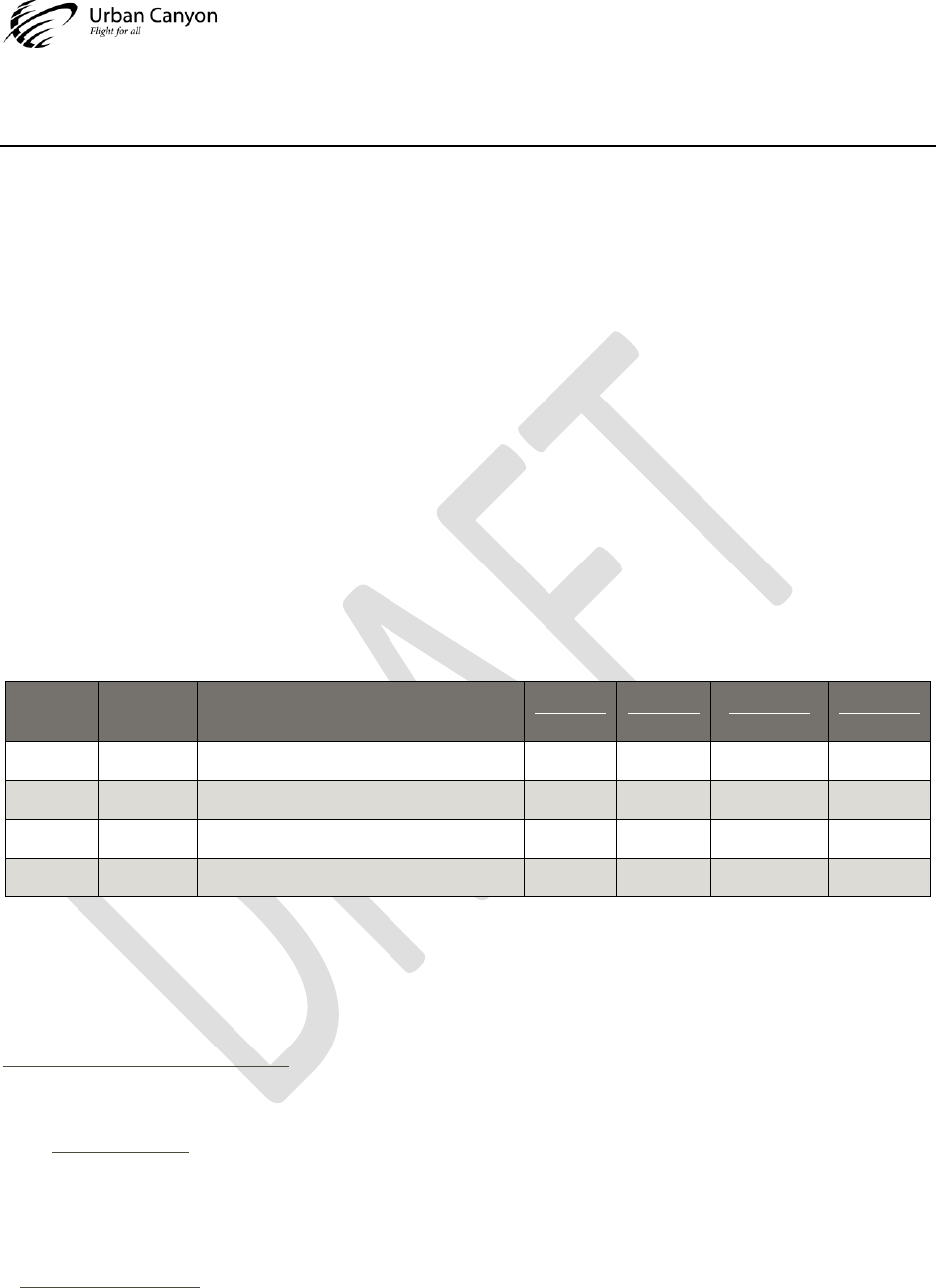
UC10x Installation Manual
URBAN CANYON FLIGHT INC UC10X-001-IM REV02
CONFIDENTIAL & PROPRIETARY PAGE 29 OF 69
7 General Information
7.1 Introduction
This manual contains information relative to the physical, mechanical and electrical characteristics and installation
requirements for the Urban Canyon Flight Series of Transponders.
7.2 General Description
Urban Canyon Flight Series of Transponders are remote mounted transponders. The transponder is a radio
transmitter and receiver that operates on radar frequencies. Functionality includes replying to ATCRBS, Mode A, C
and S interrogations. The Urban Canyon Flight Series of transponders are also capable of Automatic Dependent
Surveillance – Broadcast (ADS-B) operations which allows an aircraft or surface vehicle to transmit position,
altitude, vector and other information for use by other aircraft, surface vehicle or ground facilities. The family also
includes a Traffic Awareness Beacon System (TABS) device, which is similar in function to a Mode S Transponder w/
ADS-B Out, but with significant reduction in functionality (and thus airspace availability).
7.3 Technical Standard Order (TSO) Approvals
10
The table below show the following TSO manufacturing authorizations for the UC10x family10.
Table 3. UC10x TSO Authorizations by Product10
Part No.11
Model No.
Nomenclature
TSO-C199
TABS
TSO-C74d
Mode C
TSO-C112e
Mode S
TSO-C166b
ADS-B
10-000-()
UC100
UC100 Traffic Awareness Beacon (TABS)
Class A
10-010-()
UC101
UC101 Mode C Transponder
Class 1A
10-020-()
UC102
UC102 Mode C Transponder w/ADS-B Out
Class 1A
Class B012
10-030-()
UC103
UC103 Mode S Transponder w/ADS-B Out
Class 2A els13
Class B1S14
10
FAA certifications in progress. Units without TSO, but with FCC and FAA approval, are available. TSO and non-
TSO units are intended to be form, fit, and function equivalent.
11
Per 14 CFR 21.603(b), we anticipate a series of minor changes, which will be denoted in suffix change numbers shown
in open brackets after the part number. When ordering, omit the suffix to receive the latest product version
12
Stand-alone 1090ES transmitters. Also known as a non-transponder-device (NTD) when not integrated with a
Mode S transponder. RTCA/DO-260B §2.2.2.2 only allows Class A0 and B0 NTD devices. Uses Extended Squitter
Downlink Format 18 (DF=18).
13
14 CFR 43 Appendix F allows abbreviated marking Class 2A as equivalent to RTCA/DO-181E Class 1 Level 2 els
14
1090ES transmitters integrated with a Mode S transmitter. Uses Extended Squitter Downlink Format 17
(DF=17).
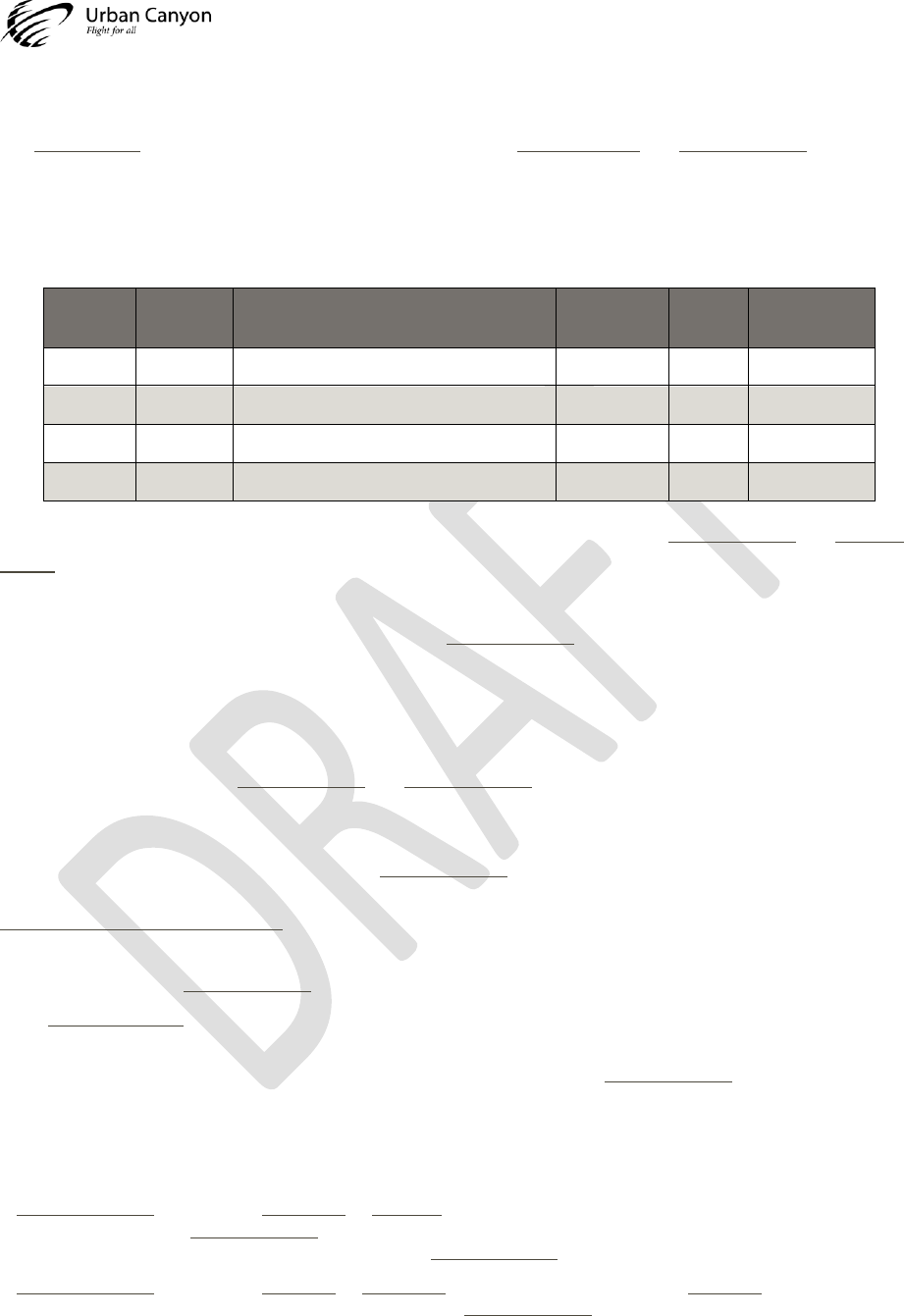
UC10x Installation Manual
URBAN CANYON FLIGHT INC UC10X-001-IM REV02
CONFIDENTIAL & PROPRIETARY PAGE 30 OF 69
7.4 FAA NextGen / 2020 Mandate
The FAA NextGen 2020
15
mandate / ADS-B Out Rule, specified in 14 CFR §91.225 and 14 CFR § 91.227, applies to
General Aviation (GA) aircraft flying in the NAS
16
. Put simply, all GA aircraft are required to equip with ADS-B Out.
Table 4 below summarizes the UC10x product line compliance with the FAA 2020 mandate.
Table 4. FAA NextGen / 2020 Mandate Compliance by Product
Part No.17
Model No.
Nomenclature
Transponder
ADS-B
2020 Mandate
10-000-()
UC100
UC100 Traffic Awareness Beacon (TABS)
Partial18
Partial19
-
10-010-()
UC101
UC101 Mode C Transponder
YES
-
-
10-020-()
UC102
UC102 Mode C Transponder w/ADS-B Out
YES
YES
-
10-030-()
UC103
UC103 Mode S Transponder w/ADS-B Out
YES
YES
YES
UC103 will fully comply with the FAA 2020 Mandate / ADS-B Out Rule (contained in 14 CFR § 91.225 and 14 CFR §
91.227), when paired with appropriate GPS/GNSS position
20
and barometric altitude
21
sources.
UC102 will not meet the 2020 Mandate. Despite being ADS-B Out, and meeting the requirements of DO-166b, the
UC102 is a Class B0 device, which does not comply with 14 CFR § 91.227. Put simply, the 2020 Mandate requires
Mode S. However, the UC102 will be displayed on ADS-B-In systems compliant to TSO-C195a.
UC101 is not an ADS-B device, and will not meet the FAA’s 2020 mandate.
UC100 is a TABS device, intended for intercompatibility with ADS-B systems, but does not comply with the FAA
ADS-B Out Rule (contained in 14 CFR § 91.225 and 14 CFR § 91.227) and thus IS NOT compliant with FAA NextGen /
2020 Mandate. Furthermore, per DO-317A (TSO-C195a), a TABS device is a non-performing emitter (NPE), and not
displayed on ADS-B-In systems compliant to TSO-C195a, and thus IS NOT an ADS-B device. Lastly, TABS does not
meet the definition of an ATC transponder (per 47 CFR § 91.215), and NOT appropriate to call it a “transponder”.
15
Officially takes effect January 1, 2020.
16
Airspace identified in 14 CFR § 91.225
17
Per 14 CFR 21.603(b), we anticipate a series of minor changes, which will be denoted in suffix change numbers shown
in open brackets after the part number.
18
UC101, UC102, and UC103 meet the definition for an ATC transponder per 47 CFR § 91.215. UC100 does not meet
the definition, and thus is not a “transponder”.
19
Per DO-317A (TSO-C195a), any ADS-B emitter broadcasting SDA=0, NACv=0, or NACp<5 will not be displayed
on TSO-compliant ADS-B-In systems. TABS is a non-performing emitter (NPE) with SDA=0, SIL=0, NIC<5,
NACv=0 or NACp<5, and will not display on a TSO-C195a compliant systems.
20
FAA AC 20-165B recommends TSO-C145 or TSO-146 position sources to maximize availability and ensure access to
the airspace identified in 14 CFR § 91.225. However, TSO-C129 and TSO-C196 are also acceptable, as are non-TSO’d
GPS that comply with the performance requirements of 14 CFR § 91.225.
21
FAA AC 20-165B recommends TSO-C10 or TSO-C106 barometric altitude sources (or TSO-C88 with a digitizer),
with pilot and ADS-B data correspondence of ±125 feet per 14 CFR § 91.217.
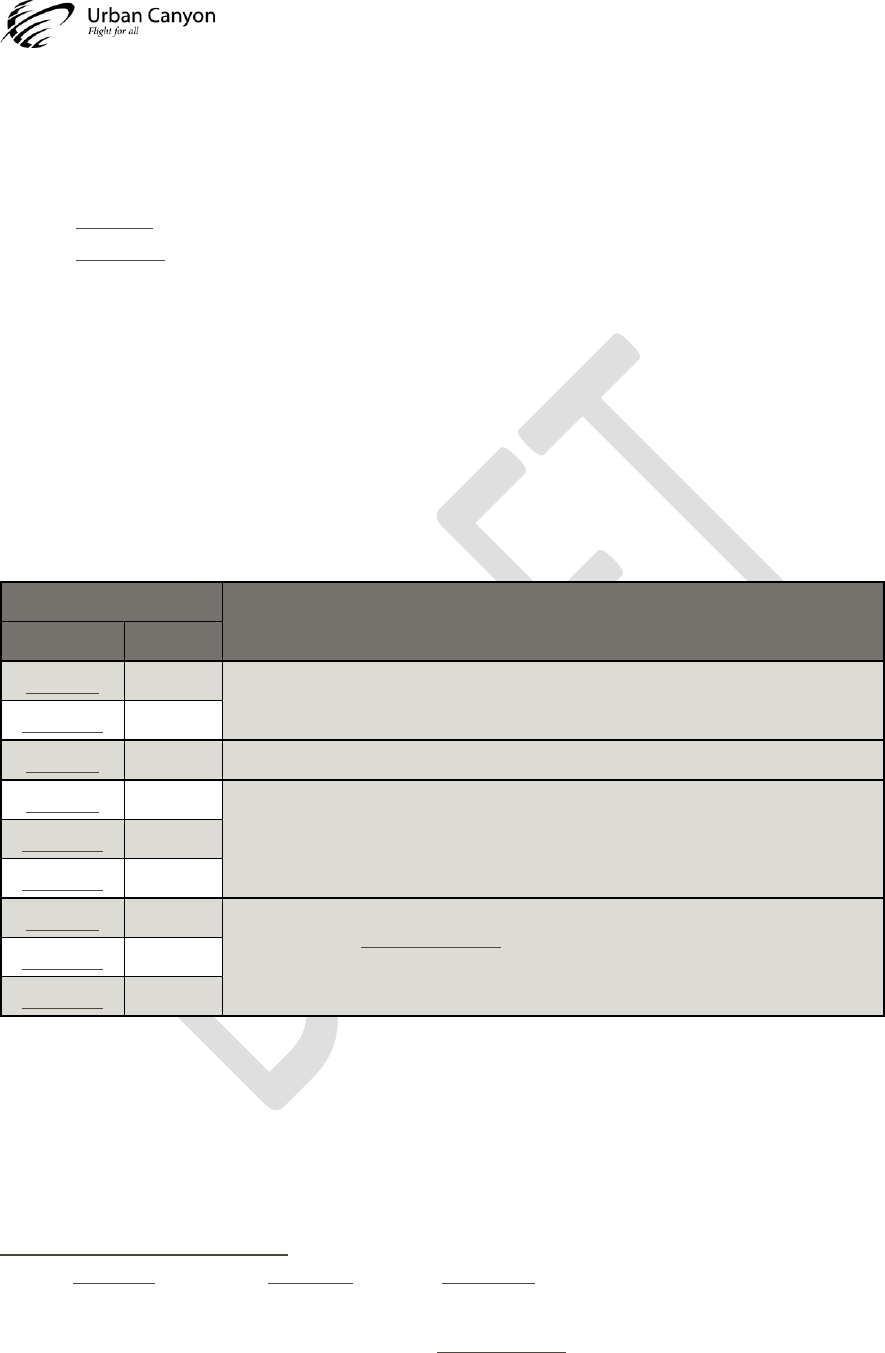
UC10x Installation Manual
URBAN CANYON FLIGHT INC UC10X-001-IM REV02
CONFIDENTIAL & PROPRIETARY PAGE 31 OF 69
7.5 Incomplete System
The UC10x is a remote system, and thus an incomplete system, as it does not include the items required for a fully-
functioning system.
• Antenna. UC10x does not include an antenna or antenna cable.
• Head Unit. UC10x does not include a display (head unit), and thus does not comply with the human
interface aspects.
7.6 Non-TSO Functions
The UC10x series do not have any Non-TSO functions.
7.6.1 TSO Deviations
Table 5 below lists the deviations for each TSO by section, and provides a justification for the deviation. Note that
all of these deviations are commonplace and are mostly due old regulatory documents. Once the TSOs are
renewed, most deviations below will not be necessary.
Table 5. TSO Deviations
TSO
Deviation
Number
Section
TSO-C74d
4.c
Electronic part marking is used for hardware and software identification, which is
stored in non-volatile memory22
TSO-C166b
4.d
TSO-C74d
3.d
TSO requires DO-160F; DO-160G will be used instead23
TSO-C74d
3.e
TSO requires DO-178B; DO-178C will be used instead
TSO-C112e
3.e
TSO-C166b
3.e
TSO-C74d
4.a
Per guidance in FAA Order 8150.1C, the appliances are marked with the primary TSO
along with a reference to the Installation Manual for the other TSO information (other
applicable TSOAs, deviations, etc.)24.
TSO-C112e
4.a
TSO-C166b
4.a
Table 5 above lists all deviations, all of which are commonplace in the industry, and do not affect form, fit, or
function of the device.
The deviations in Table 5 above are typically automatically accepted, many IM would list “No TSO Deviations”,
though we’ve decided to include these minor deviations for completeness.
22
Unlike TSO-166b (ADS-B) and TSO-C74d (Mode C), TSO-C112e (Mode S) explicitly allows electronic part marking.
23
Latest revision DO-160G used in all cases
24
Basic requirement is to mark each article according to 14 CFR 45.15(b), and as specified in the TSO
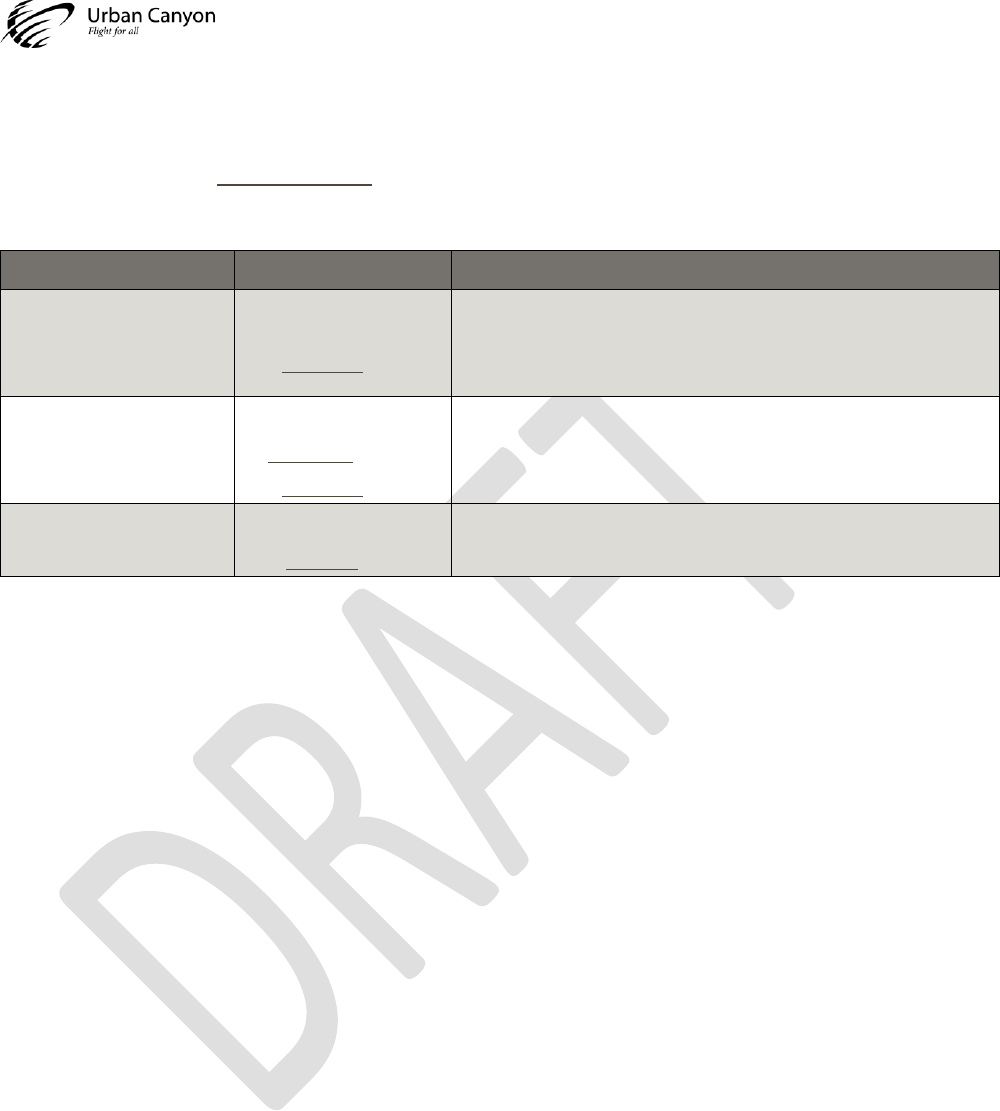
UC10x Installation Manual
URBAN CANYON FLIGHT INC UC10X-001-IM REV02
CONFIDENTIAL & PROPRIETARY PAGE 32 OF 69
7.6.2 Failure Condition Classifications
Table 6 summarizes the potential hazards associated with the UC10x functions and the associated failure condition
severity classifications per FAA AC 23.1309-1E.
Table 6. Failure Condition Classifications
Functional Description
Hazard Classification
Failure Condition
Mode S Transponder
Response to SSR and
TCAS Interrogations
MAJOR
TSO-C112e § 3.b
Incorrect reply to an SSR or TCAS interrogation.
Significant reduction in safety margins or functional capabilities
ADS-B Output
MAJOR
AC 20-165B § A.2.29
TSO-C166b § 3.b
Incorrect position or velocity data reported to ground surveillance
system providing aircraft separation services.
Significant reduction in safety margins.
Mode C Transponder
Failure of function
MINOR
TSO-C74d § 3.b
Loss of function
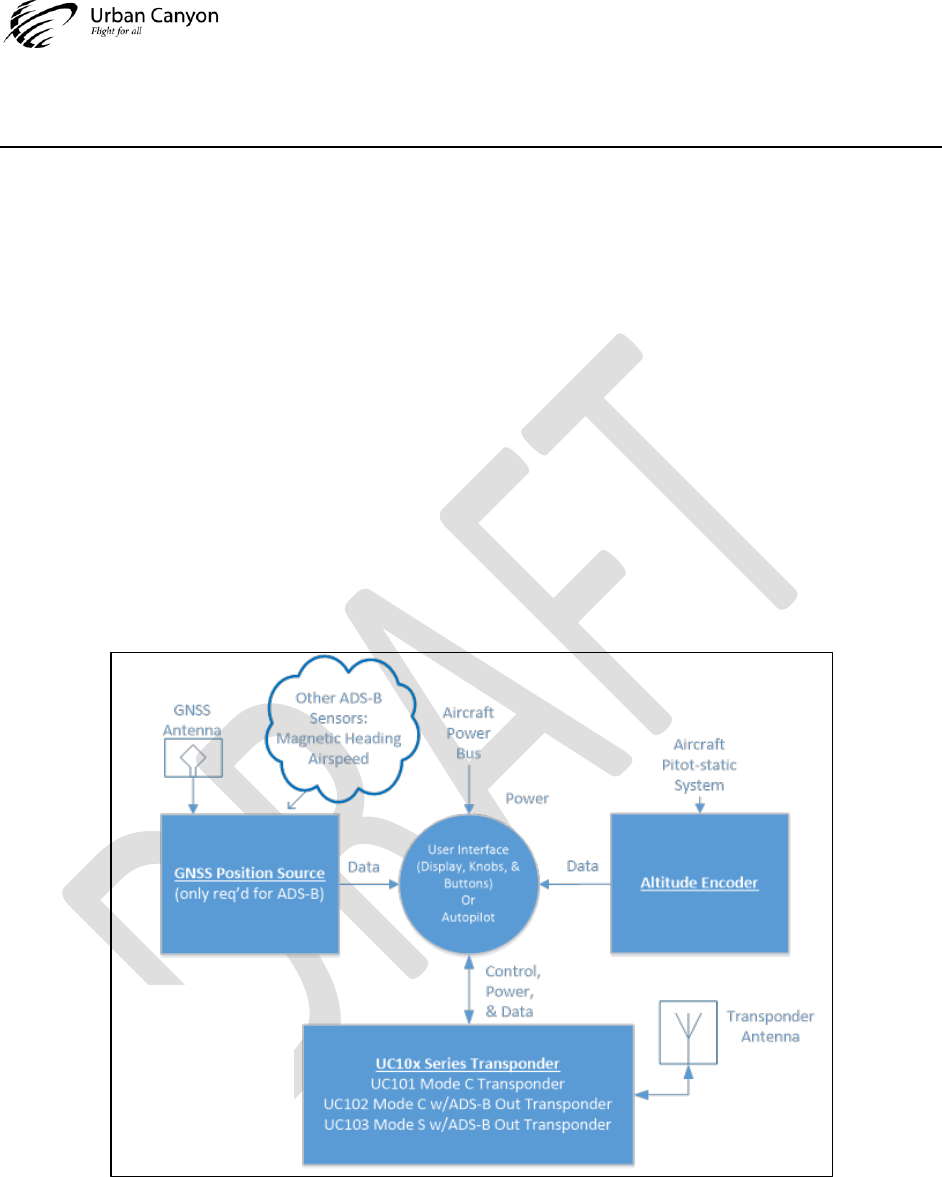
UC10x Installation Manual
URBAN CANYON FLIGHT INC UC10X-001-IM REV02
CONFIDENTIAL & PROPRIETARY PAGE 33 OF 69
8 Equipment Description
The Urban Canyon Flight Series of Transponders are the best-in-world size (3 in3) weight (50 grams) and power
consumption (1 W average). UCF Transponders feature an all solid-state transmitter. Mode and code selection are
controlled remotely. Functions including flight level, 4096 code, and aircraft address are presented on remote
graphic user interface. The transponders series uses data and power from various external devices. These external
devices include GPS/GNSS sensor, direction instrumentation (magnetic and non-magnetic), airspeed sensors,
barometric altimeters and altitude encoders, external power, antenna, and antenna cabling, through the user
interface or autopilot/flight computer. Note that not all sensors are required for all installations, and that there
may be additional sensors capable of providing equivalent data
8.1 Systems Overview and Planning
The transponder requires connection of multiple external devices. The UC10x family only includes the radio itself
(transponder, ADS-B, and/or TABS). UC10x does not include the antenna, antenna cable, sensors (GPS/altitude
encoder), or human interface aspects (i.e. no display/controller/autopilot/flight computer).
Figure 10 below provides an example installation configuration with the sensor data multiplexed through a single
interface with the display or autopilot.
Figure 10. System-Level Block Diagram
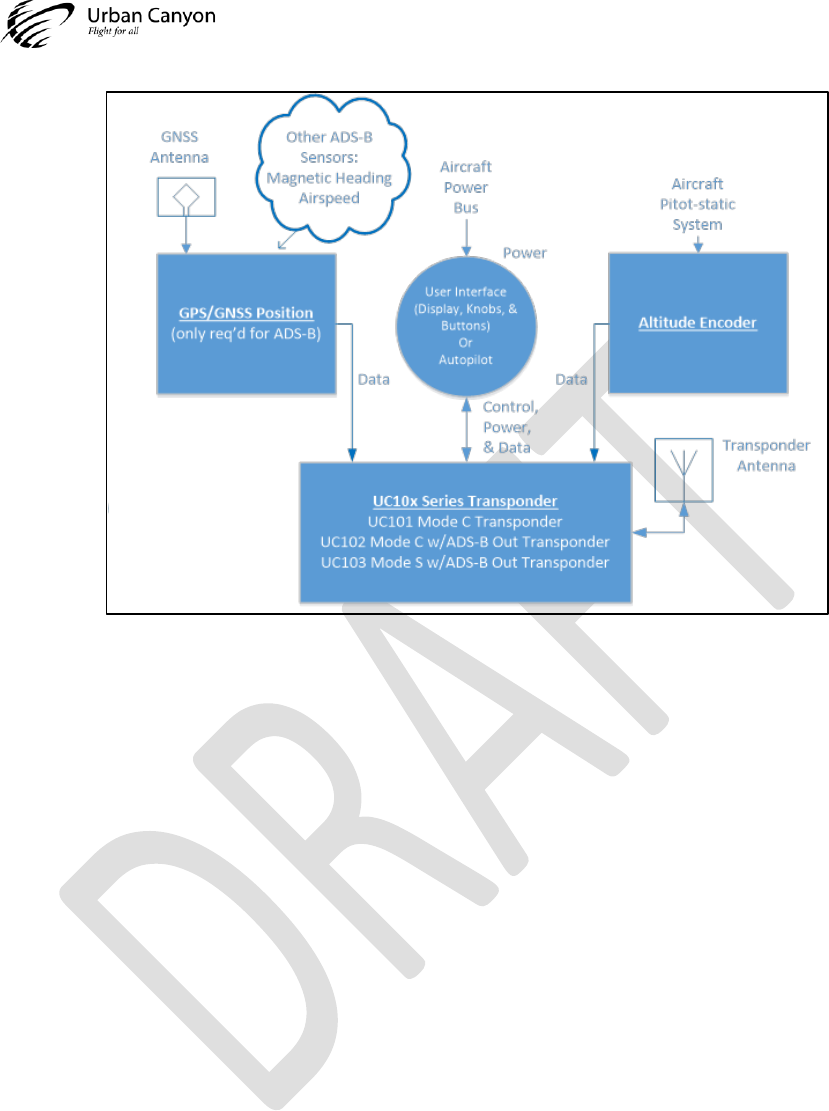
UC10x Installation Manual
URBAN CANYON FLIGHT INC UC10X-001-IM REV02
CONFIDENTIAL & PROPRIETARY PAGE 34 OF 69
Figure 11. Alternate System-Level Block Diagram
Figure 11 above shows an alternate connection of data flow, with sensor data going directly to the transponder
(e.g. through RS-232 Port 1) and control data separate (e.g. on RS-232 Port 0). The physical sensors would be
identical to sensors shown in Figure 10, the difference of note is that Figure 11 shows the sensors connected
directly to the transponder, instead of through the flight computer.
8.2 Input and Output Interfaces
8.2.1 Input Power
The unit is designed to operate from 10V to 38V, without requiring any change to the configuration. Thus, it can be
operated from standard aircraft 14V or 28V DC power bus. The unit is most efficient at 28V.
The unit has two positive power input pins, both of which must be connected. Additionally, both grounds must be
connected for power.
The input power interface includes common- and differential-mode filtering for EMC (conducted emissions and
conducted susceptibility). Additionally, ESD and transient voltage suppression (TVS) diodes, suitable for aircraft
electrical systems supplied by engine-driven alternators/rectifiers, or DC generators where a battery of significant
capacity is floating on the DC bus at all times. The input power interface also includes reverse polarity protection to
-60V max (non-conducting) and under voltage lockout for power input voltages below 9V. Lastly, the power input
interface is short duration operational for voltages between 38V to 63V typical, consistent with a Category B
device as defined in DO-160G § 16.0 Power Input.
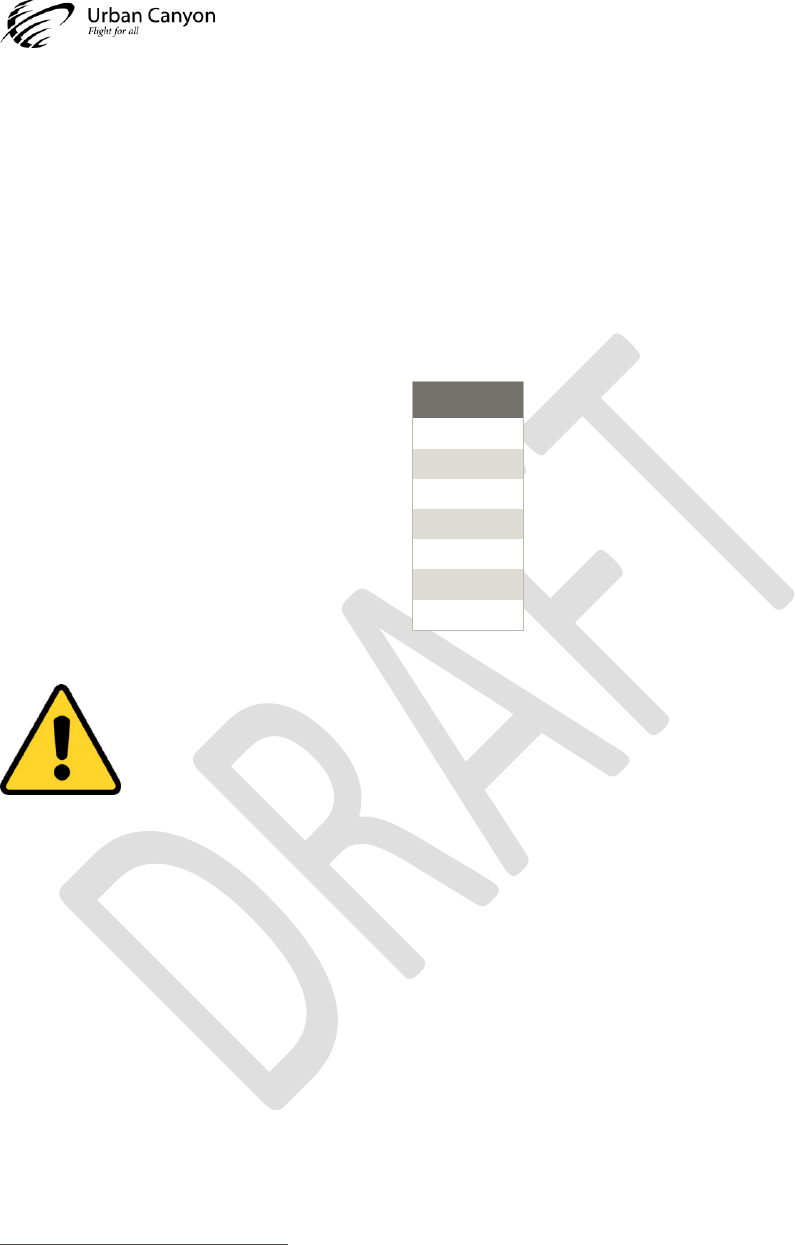
UC10x Installation Manual
URBAN CANYON FLIGHT INC UC10X-001-IM REV02
CONFIDENTIAL & PROPRIETARY PAGE 35 OF 69
The maximum power consumption is 6 W
25
(worst-case condition for Mode S w/ ADS-B out). The typical power
consumption is 0.5 W (STBY), and 1 W (ALT mode, 235 PRF, 1090ES enabled). On average, the UC10x consumes
one-fifth as much power as competitive devices.
8.2.2 RS-232 Serial Communication
The unit has two bi-directional RS-232 ports. Both ports are fully compliant with the industry standard
26
physical
layer implementation. Both RS-232 ports operate at 57.6 kbps 8N1 default, though they are easily reconfigurable
for other standard baud rates summarized in Table 7 below.
Table 7. Supported Baud Rates for RS-232 Communication
Baud
2.4 kbps
4.8 kbps
9.6 kbps
19.2 kbps
38.4 kbps
57.6 kbps
115.2 kbps
ADS-B UNCOMPENSATED LATENCY WARNING: Modifying default baud rate for sensor data
requires re-evaluation of uncompensated and total system latency, and—depending on the
sensor data format and other factors—may result in data transfer that is too slow to meet ADS-B
data latency requirement. See Section 9.2.4 Uncompensated Latency for more details.
The two RS-232 ports (Port 0 and Port 1) are completely redundant with each other, and allow for all sensor and
control data to come from either port.
25
This is the maximum average power consumed by the device. The instantaneous (short-term) power consumption will
be more.
26
Industry standard defined by ANSI Electronic Industries Association/Telecommunication Industry Association
TIA/EIA-232-F and ITU V.28
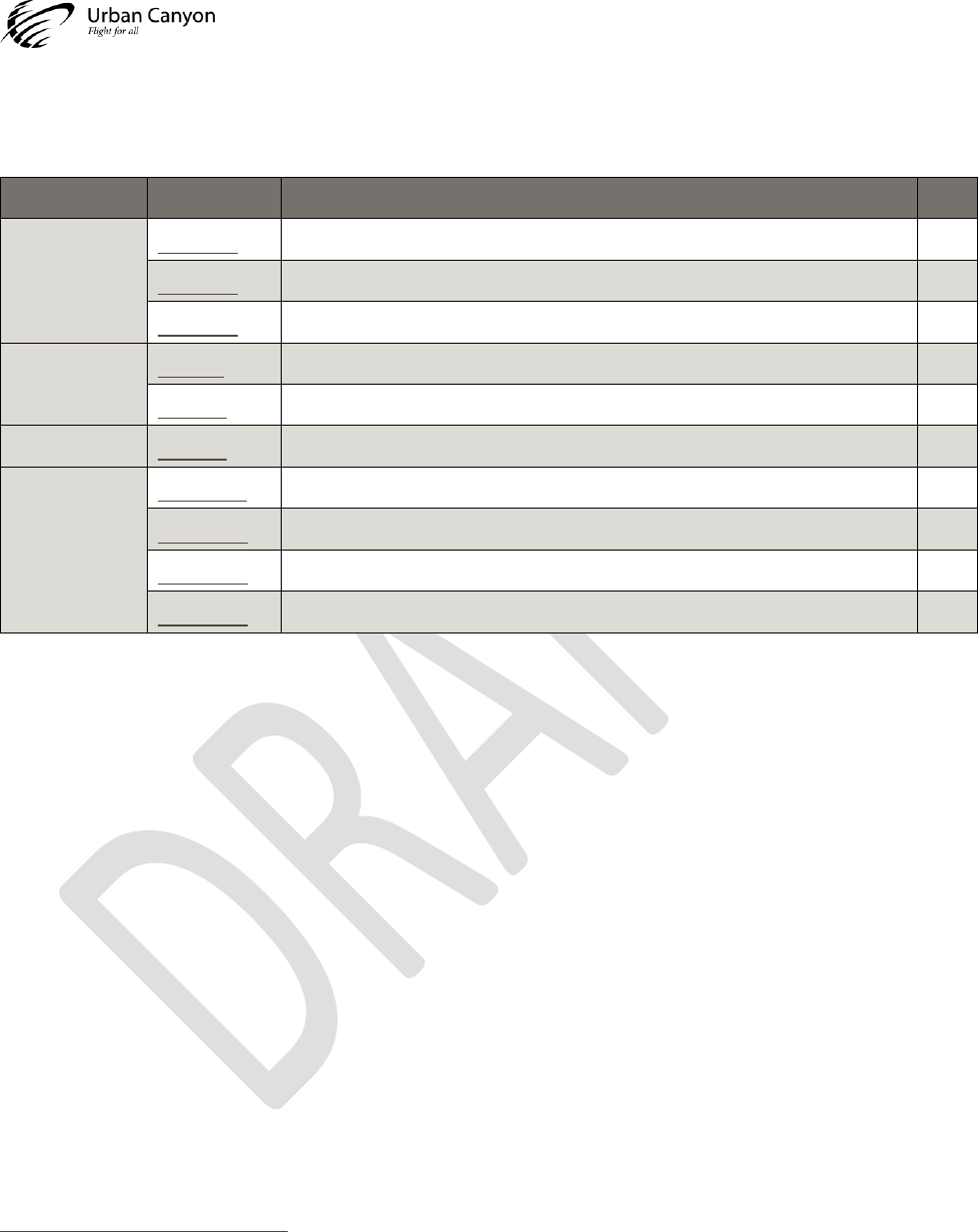
UC10x Installation Manual
URBAN CANYON FLIGHT INC UC10X-001-IM REV02
CONFIDENTIAL & PROPRIETARY PAGE 36 OF 69
8.2.3 Acceptable FAA-Certified Data Sources
Table 8. Summary of acceptable data sources
Sensor Type
TSO27
Description
Rev
Baro
TSO-C10b
Altimeter, Pressure Actuated, Sensitive Type
Any
TSO-C106
Air Data Computer
Any
TSO-C88b
Automatic Pressure Altitude Reporting Code-Generating Equipment
Any
Heading
TSO-C5f
Direction Instrument, Non-Magnetic (Gyroscopically Stabilized)
Any
TSO-C6e
Direction Instrument, Magnetic (Gyroscopically Stabilized)
Any
Vertical Rate
TSO-C8e
Vertical Velocity Instruments
Any
GPS
TSO-C129a28
Supplemental GPS
Any
TSO-C145d
(FAA Recommended) GPS with WAAS
Any
TSO-C146d
(FAA Recommended) GPS with WAAS, Stand-Alone
Any
TSO-C196b
Supplemental GPS Augmented by Aircraft
Any
8.3 GPS/GNSS Input
UC102 and UC103 support Extended Squitter ADS-B out, and both are DO-260B (ADS-B “Version 2”) compliant
broadcast participant. UC100 supports a TABS-compliant broadcast. In all cases, to function properly, a GPS/GNSS
sensor must be connected.
8.3.1 Certification Level
To support an SDA of “2”, the UC10x must be connected to GPS/GNSS with DAL of C or higher for both DO-178()
and DO-254.
8.3.2 Protocols
The GNSS input format is compliant with NMEA 0183. However, NMEA 0183 does not provide all data necessary
for ADS-B “out”, most notably the integrity data. Additional proprietary messages fill the gap.
27
Current TSO revision level shown in this table, as of the writing of this document. However, any revision of the TSO
from the table above is acceptable.
28
TSO-C129 is cancelled. ADS-B “out” equipment that us this as the position source may need to conduct a position
and velocity latent analysis
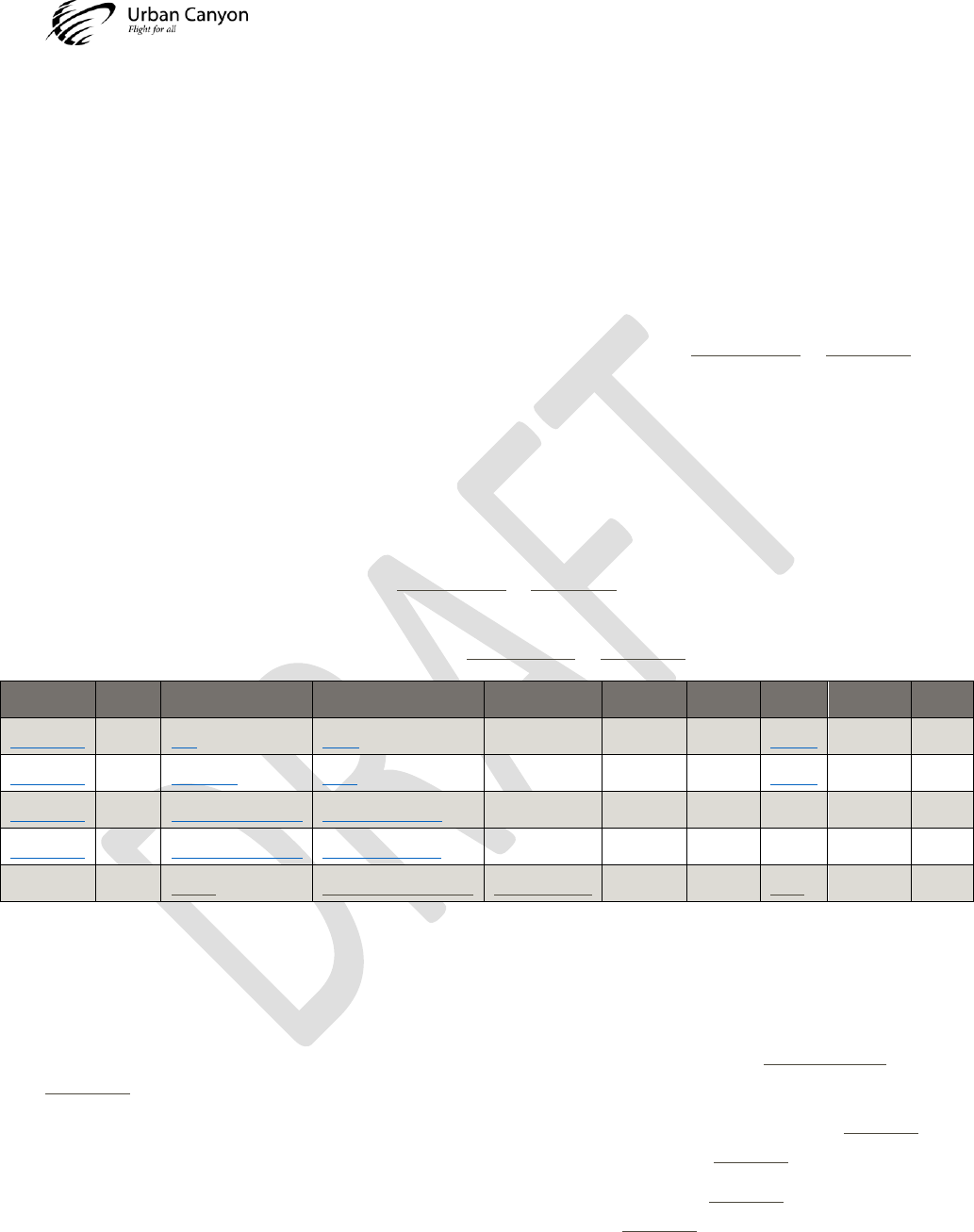
UC10x Installation Manual
URBAN CANYON FLIGHT INC UC10X-001-IM REV02
CONFIDENTIAL & PROPRIETARY PAGE 37 OF 69
NMEA 0183 and the Freeflight / Accord NexNav GPS are the only standard protocol implemented. The following
protocols are also in progress.
• Industry standard “Aviation” protocol
• Freeflight and Accord NexNav GPS proprietary protocols
• Urban Canyon Flight ADS-B protocol, including ADS-B plus
• Trig ADS-B protocol
• C199 TABS compliant GPS using NMEA protocol
8.3.3 GPS for FAA NextGen / 2020 Mandate
The UC103 can be connected to the following GPS/GNSS units to form the basis of a 14 CFR 91.227 or AMC 20-24
compliant ADS-B installation:
• Trig TN70 GPS Sensors
• Freeflight 1201 & 1204 WAAS/GPS Sensors
• NexNav MINI & NexNav MAX WAAS/GPS Sensors
• Garmin GNS 400W/500W series navigators
• Garmin GTN 600/700 series navigators
The bulleted list above represents long-term compatibility plan. Of the list above, we will down select to one or
two units, in order to provide the lowest-cost 14 CFR 91.227 or AMC 20-24 solution possible. Table 9 below is the
“short list” of products we are considering.
Table 9. GPS products for 2020 Mandate (14 CFR 91.227 or AMC 20-24 compliant system)
TSO
Class
Manfr
Manfr PN
MOPS
DO-178()
DO-254
Price
Interface
Rate
TSO-C145c
Beta-1
Trig
TN70
DO-229D
Level C
Level C
$3,250
RS-232
5 Hz
TSO-C145c
Beta-1
Freeflight
1201
DO-229C
Level C
N/A
$2,989
RS-232
???
TSO-C145c
Beta-1
Accord Technology
NexNav mini CCA
DO-229D
Level C
Level C
???
RS-232
5 Hz
TSO-C145c
Beta-1
Accord Technology
NexNav mini LRU
DO-229D
Level C
Level C
???
RS-232
5 Hz
NOT TSO’d
N/A
Dynon
SkyView SV-GPS-2020
14 CFR 91.225
N/A
N/A
$579
RS-232
4 Hz
The plan is to finalize the decision on which GPS unit(s) to support prior to finalizing our requirements.
8.3.4 GPS for TSO-C199 TABS Compliance
The Traffic Awareness Beacon System (TABS) is intended for voluntary equipage on aircraft exempted from
carrying Automatic Dependent Surveillance - Broadcast (ADS-B) equipment, such as gliders, balloons and aircraft
without electrical systems. TABS GPS devices do not meet the ADS-B requirements defined in 14 CFR § 91.227 or
AMC 20-24.
UC103 is a TSO-C166b and TSO-C112e compliant ADS-B transmitter. When connected to an appropriate TSO-C199
Class B GPS position source, all transmitted ADS-B data complies with section A1.2.5 of TSO-C199.
UC100 is a TABS device, compliant with TSO-C199. When connected to an appropriate TSO-C199 Class B GPS
position source, all transmitted ADS-B data complies with section A1.2.5 of TSO-C199.
Table 10 below is a list of compatible TABS-compliant GPS source.
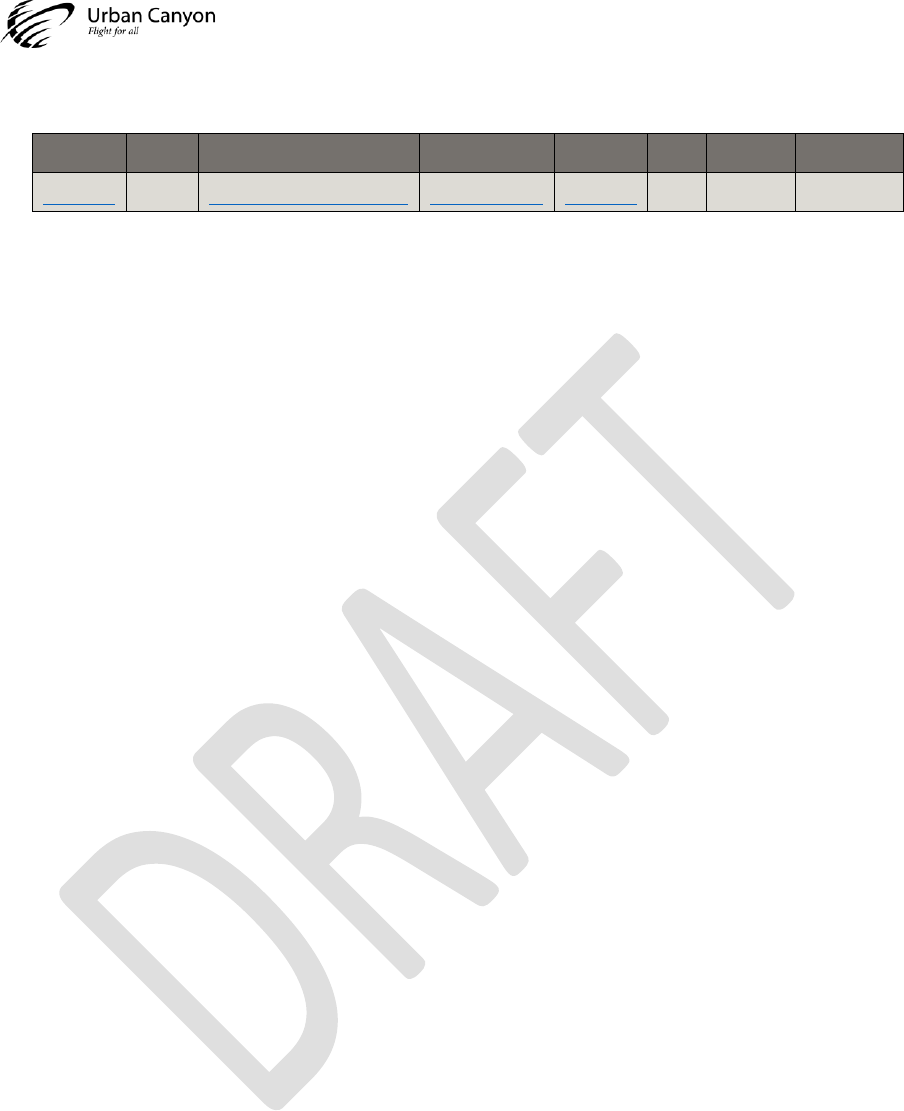
UC10x Installation Manual
URBAN CANYON FLIGHT INC UC10X-001-IM REV02
CONFIDENTIAL & PROPRIETARY PAGE 38 OF 69
Table 10. GPS products for TABS (TSO-C199) compliant system
TSO
Class
Manfr
Manfr PN
MOPS
Price
Interface
Rate
TSO-C199
Class B
Accord Technology / Aspen
NexNav Micro-i
TSO-C199
$800
??
1 Hz or 4 Hz
8.4 Altitude Input
The unit does not support a Gillham (gray code) input.
Barometric altitude must be provided via one of the RS-232 serial ports.
8.5 RF Suppression Bi-Directional Bus
The mutual suppression input/output is used to provide suppression of L-band equipment on the aircraft.
The transponder uses the signal as an input to inhibit all transmission activities and decoding of receiver signals
when other equipment on the aircraft is transmitting. When the transponder transmits, it asserts the output to
provide the suppression to other systems on the airplane.
The duration of the asserted output is variable (20 µs min / 130 µs max), depending if the transmission is Mode
A/C (28 µs typical), Mode S short (67 µs typical), or Mode S long / 1090ES (123 µs typical). Per DO-181E § 2.2.11(b),
the suppression output signal shall precede the transponder RF transmission by no more than 10 µs, and return to
the inactive state no later than 10 µs after transmission. Furthermore, per DO-181E § 2.2.11(a), the UC10x will
regain sensitivity, within 3dB, not later than 15 µs after the end of the applied mutual suppression pulse.
The physical implementation (the “PHY” layer) of the RF suppression bus is proprietary (e.g. does not conform with
standards such as ARINC 735B Attachment 8).
The RF suppression output is open drain, driven by an N-channel MOSFET with an internal 1kΩ pullup to 3.3V.
When used as an input, the RF suppression bus is designed to operate directly with external devices capable of
driving 3.3V TTL and CMOS logic standards. Alternatively, the interface also works with devices capable of an open
collector output drive. In all cases, the external interface must be capable of sinking up to 5 mA.
Regardless of input/output state, the RF suppression connection is ESD and transient voltage protected, tolerant to
operate with voltages up to 5V max. The latency of the RF suppression bus, both input/output, is maximum 1 µs.
8.6 Automatic Air/Ground Determination
The unit is designed to interface with an automatic weight-on-wheels (WOW) sensor, also known as a squat
switch, which is a device that automatically provides On Ground / In Air status, through this single pin. Connection
of a WOW switch is optional, for aircraft that do not have a WOW sensor, squat switch detection can be disabled
via either serial port.
8.7 Antenna Port
UC10x has an SMA female antenna connector. UC10x system does not include an antenna or antenna cable. See
11.4 Antenna for antenna and antenna cable guidance.
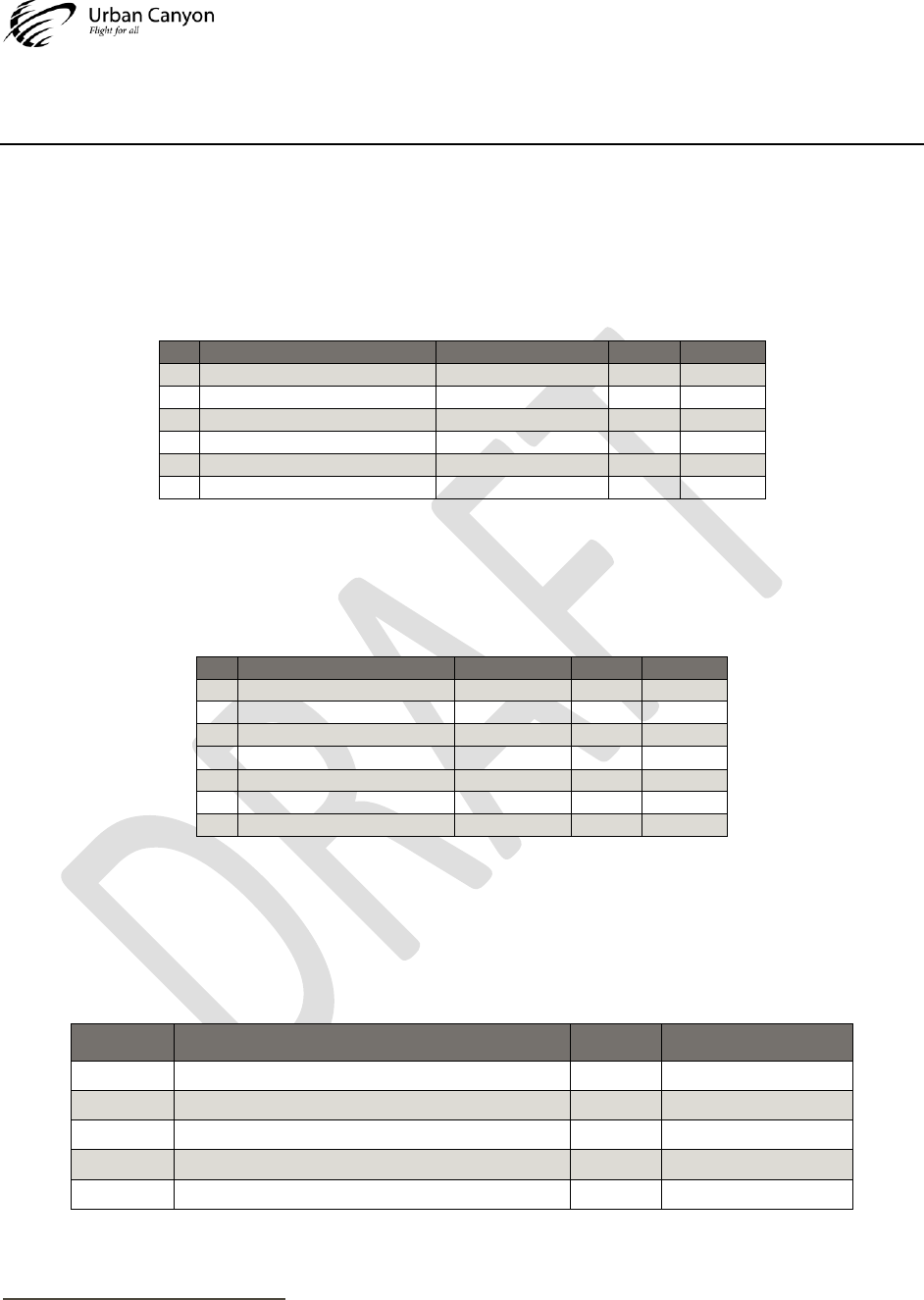
UC10x Installation Manual
URBAN CANYON FLIGHT INC UC10X-001-IM REV02
CONFIDENTIAL & PROPRIETARY PAGE 39 OF 69
9 Supported Registers and Parameters
9.1 Mode S
9.1.1 Uplink Formats (UF)
Table 11 below summarizes UF (interrogations), that the Mode S transponder can receive wirelessly.
Table 11. Mode S Uplink Formats (UF) Supported
UF
Description
Interrogation Length
Level
DO-181E
0
Short Special Surveillance
56 bits
Level 1
§ 2.2.18
4
Surveillance, Altitude Request
56 bits
Level 1
§ 2.2.18
5
Surveillance, Identity Request
56 bits
Level 1
§ 2.2.18
11
Mode S-Only All-Call
56 bits
Level 1
§ 2.2.18
20
Comm-A, Altitude Request
112 bits
Level 2
§ 2.2.19
21
Comm-A, Identity Request
112 bits
Level 2
§ 2.2.19
9.1.2 Downlink Formats (DF)
Table 12 below summarizes the Downlink Formats (DF) that the Mode S transponder can transmit wirelessly.
Table 12. Mode S Downlink Formats (DF) Supported
DF
Description
Reply Length
Level
DO-181E
0
Short Special Surveillance
56 bits
Level 1
§ 2.2.18
4
Surveillance, Altitude Reply
56 bits
Level 1
§ 2.2.18
5
Surveillance, Identity Reply
56 bits
Level 1
§ 2.2.18
11
All-Call Reply
56 bits
Level 1
§ 2.2.18
17
Extended Squitter
112 bits
Level 2
§ 2.2.19
20
Comm-B, Altitude
112 bits
Level 2
§ 2.2.19
21
Comm-B, Identity
112 bits
Level 2
§ 2.2.19
All the messages in Table 12 are transmitted in response to an interrogation defined in Table 11, except for
Extended Squitter (DF=17), which is transmitted unsolicited.
9.1.3 BDS Registers
Table 13. Mode S BDS Registers Supported
Register
Assignment
Category
Max Update Interval29
1016
Data Link Capability Report
Level 1
4.0 s
1716
Common Usage GICB Capability Report
Level 1
5.0 s
1816 – 1C16
Mode S Specific Services GICB Capability Report
Level 1
5.0 s
2016
Flight ID
Level 2
5.0 s
2116
Aircraft Registration
Level 2
15.0 s
29
Maximum update interval per RTCA/DO-181E Table B-2-1
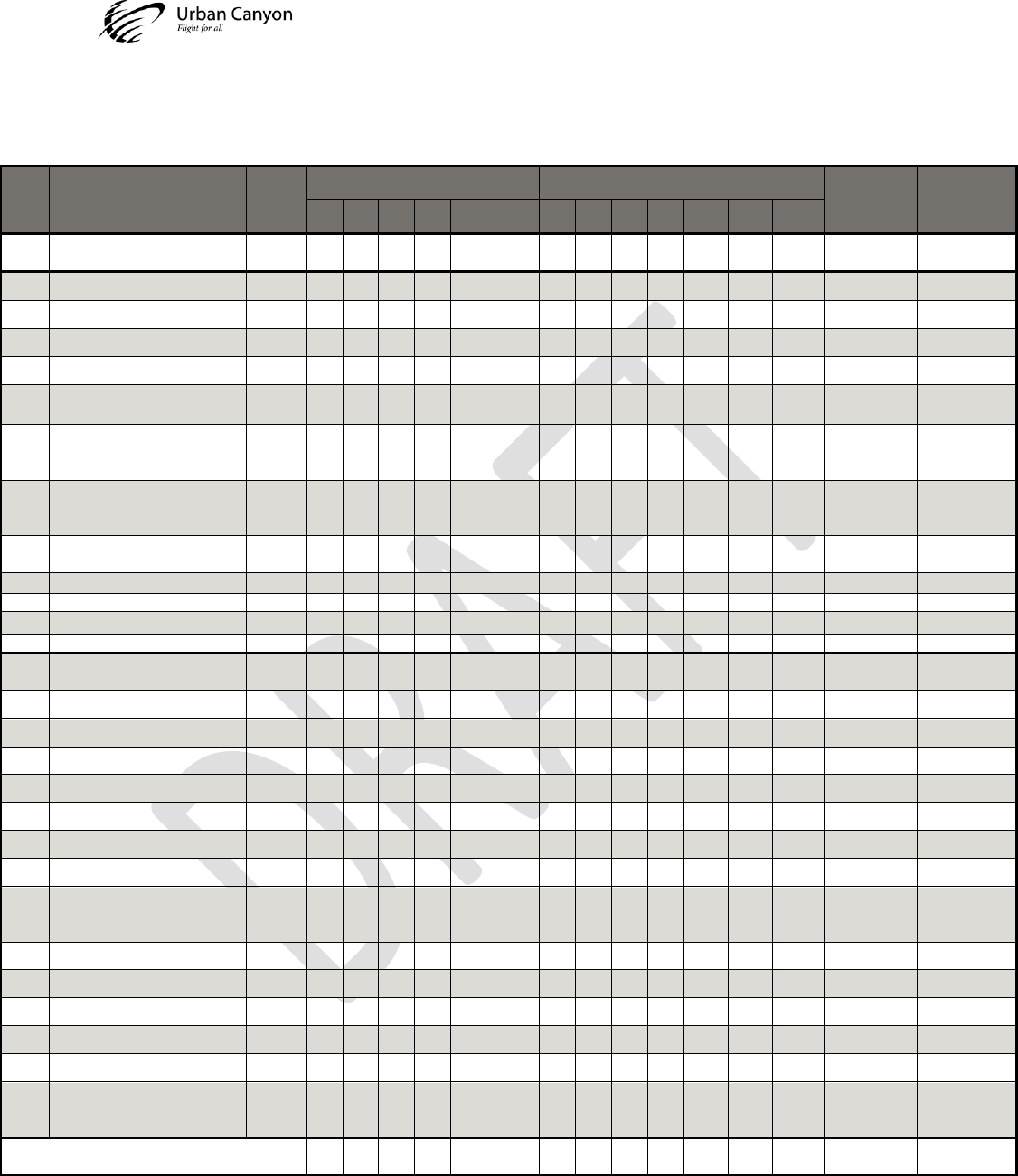
UC10x Installation Manual
URBAN CANYON FLIGHT INC UC10X-001-IM REV02
CONFIDENTIAL & PROPRIETARY PAGE 40 OF 69
9.1.4 Parameters
Table 14. Mode S Fields/Parameters Supported
Field
Description
Length
(bits)
UF
DF
Content
Protocol
0
4
5
11
20
21
0
4
5
11
17
20
21
AP
Address/Parity
24
X
X
X
X
X
X
X
X
X
X
X
2.2.14.4.4
2.2.18.2.1
2.2.18.2.2
UF
Uplink Format
5
X
X
X
X
X
X
2.2.14.4.40
N/A
RL
Reply Length
1
X
2.2.14.4.34
2.2.19.1.4
AQ
Acquisition Special
1
X
2.2.14.4.5
2.2.18.2.6
DS
Comm-B Data Selector
8
X
2.2.14.4.14
2.2.19.1.18
PC
Protocol
3
X
X
X
X
2.2.14.4.29
2.2.18.2.4
2.2.19.1.12
RR
Reply Request
5
X
X
X
X
2.2.14.4.35
2.2.19.1.12.2
2.2.19.1.12.4
2.2.19.1.13
DI
Designator Identification
3
X
X
X
X
2.2.14.4.11
2.2.18.2.5
2.2.19.2.1.1
2.2.19.1.12
SD
Special Designator (SD),
and IIS Subfield in SD30
16
X
X
X
X
2.2.14.4.36
2.2.19.1.12.2
2.2.19.2
PR
Probability of Reply
4
X
2.2.14.4.31
2.2.18.2.2.i
IC
Interrogator Code
4
X
2.2.14.4.16
2.2.14.4.16
CL
Code Label
3
X
2.2.14.4.9
2.2.14.4.9
MA
Message, Comm-A
56
X
X
2.2.14.4.20
2.2.19.1.10
DF
Downlink Format
5
X
X
X
X
X
X
X
2.2.14.4.10
2.2.18.2.3
2.2.19.1.4
PI
Parity/Interrogator Identity
24
X
X
2.2.14.4.30
2.2.18.2.1
VS
Vertical Status
1
X
2.2.14.4.42
2.2.18.2.10
CC
Crosslink Capability
1
X
2.2.14.4.7
2.2.14.4.7
SL
TCAS Sensitivity Level Report
3
X
2.2.14.4.40
N/A
RI
Reply Information, Air-To-Air
4
X
2.2.14.4.33
2.2.18.2.10
AC
Altitude Code
13
X
X
X
2.2.14.4.2
2.2.18.2.10
FS
Flight Status
3
X
X
X
X
2.2.14.4.15
2.2.18.2.7
DR
Downlink Request
5
X
X
X
X
2.2.14.4.13
2.2.20.2.1.1.1
2.2.19.1.12.4
UM
Utility Message30
6
X
X
X
X
2.2.14.4.40
None given
ID
Identification (4096 code)
13
X
X
2.2.14.4.17
2.2.18.2.10
CA
Transponder Capability
3
X
X
2.2.14.4.6
2.2.18.2.8
AA
Address, Announced
24
X
X
2.2.14.4.1
2.2.18.2.10
ME
Message, Extended Squitter30
56
X
2.2.14.4.24
2.2.14.4.24
MB
Comm-B and BDS B-
Definition Subfield30
56
X
X
2.2.14.4.21
2.2.19.1.12
2.2.22.1.2.3
TOTAL BITS
56
56
56
56
112
112
56
56
56
56
112
112
112
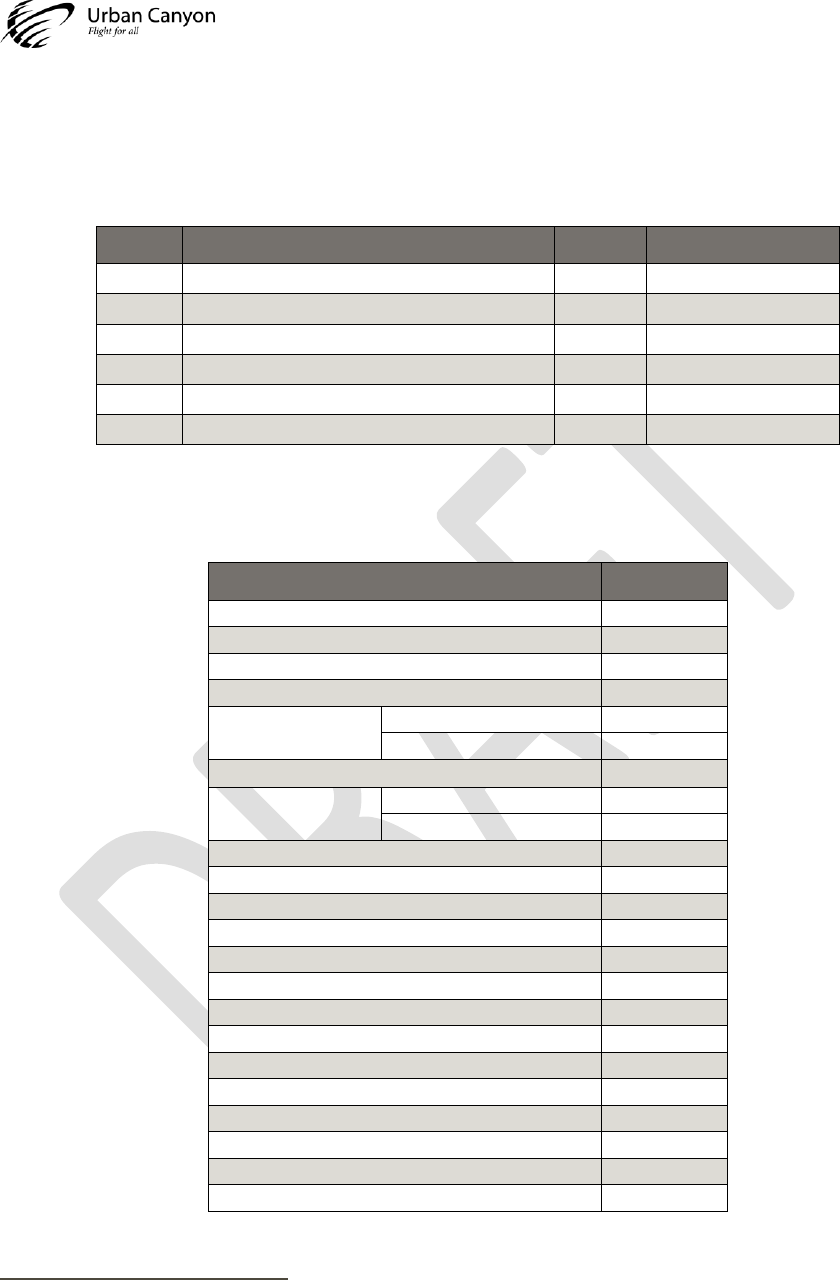
UC10x Installation Manual
URBAN CANYON FLIGHT INC UC10X-001-IM REV02
CONFIDENTIAL & PROPRIETARY PAGE 41 OF 69
9.2 ADS-B
9.2.1 BDS Registers
Table 15. ADS-B BDS Registers Supported
31
Register
Assignment
Category
Max Update Interval29
0516
Extended Squitter Airborne Position
ADS-B
0.2 s
0616
Extended Squitter Surface Position
ADS-B
0.2 s
0816
Extended Squitter Identification & Category
ADS-B
15.0 s
0916
Extended Squitter Airborne Velocity
ADS-B
1.3 s
6116
Emergency / Priority Status
ADS-B
1.0 s
6516
Aircraft Operational Status
ADS-B
2.5 s
9.2.2 Parameters
Table 16. ADS-B Parameters Supported
32
31
Parameter
BDS Register
SPI
0516
Emergency Indicator
0516
Barometric Altitude
0516
Quality Indicator (NIC)
0516
Airborne Position
Latitude
0516
Longitude
0516
Quality Indicator (NIC)
0616
Surface Position
Latitude
0616
Longitude
0616
Surface Ground Speed
0616
Surface Ground Track
0616
Aircraft Identification
0816
Airborne Ground Velocity
0916
Geometric to Barometric Altitude Difference
0916
Geometric Vertical Rate
0916
Squawk Code
6116
Emergency Status
6116
Quality Indicator (NACP)
6516
Quality Indicator (NACV)
6516
Quality Indicator (SIL)
6516
Version Indicator
6516
Surface Length/Width
6516
Surface Antenna Offset
6516
30
Subfield(s) omitted for brevity. See DO-181E Figure 2-7 for additional information on subfields.
31
UC100 & UC103 use DF=17 and UC102 uses DF=18 for this same ADS-B data
32
When connected to appropriate GPS/GNSS receiver
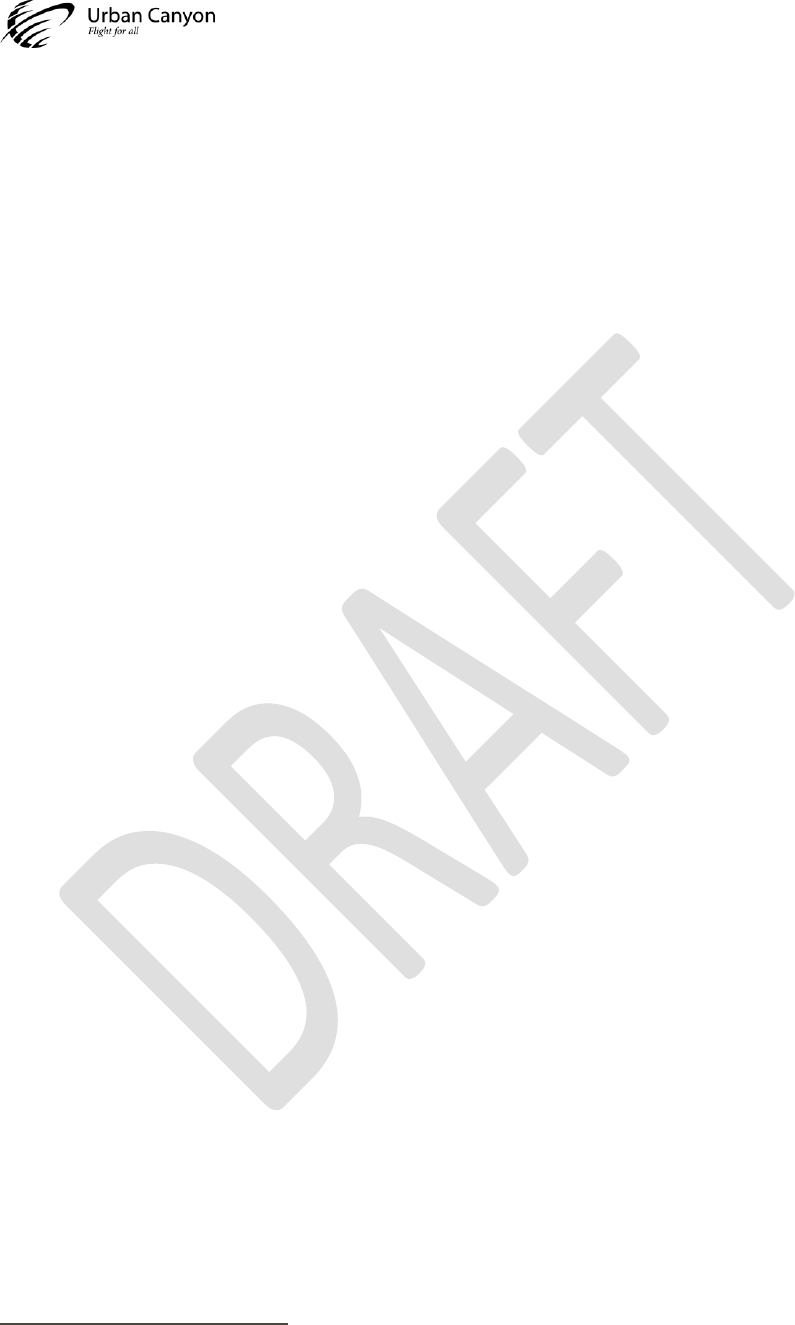
UC10x Installation Manual
URBAN CANYON FLIGHT INC UC10X-001-IM REV02
CONFIDENTIAL & PROPRIETARY PAGE 42 OF 69
9.2.3 Time Mark
UC10x does not accept the Time Mark
33
from the GPS/GNSS, thus the “Time” (T) subfield is always set to “0”.
9.2.4 Uncompensated Latency
Uncompensated latency due to the transponder is less than 10 milliseconds. Analysis of the system latency should
add this to the latency of the GPS system and the transmission time of the position data from the GPS to the
transponder to determine overall latency.
RTCA/DO-260B Appendix U provides a great description of the total and uncompensated latency in 1090ES ADS-B.
33
Time Mark refers to the 0.2 second UTC epochs

UC10x Installation Manual
URBAN CANYON FLIGHT INC UC10X-001-IM REV02
CONFIDENTIAL & PROPRIETARY PAGE 43 OF 69
10 Electrical Connections
UC10x have two electrical connectors: an SMA connector for the antenna connection, and a low-profile 17-
position interface connector for power and communication. Power connections, voltage requirements and circuit
breakers requirements are shown on the interconnect diagrams. (Figure 12, Figure 13 and Table 17)
When cables are installed in the aircraft, they must be supported firmly enough to prevent movement and should
be carefully protected against chaffing. Additional protection should also be provided in all locations where the
cable may be subjected to abuse. In wire bundles, the cabling should not be tied tightly together as this tends to
increase the possibility of noise pickup and similar interference. When routing cables through the aircraft the
cables should cross other RF lines at right angles.
Prior to installing any equipment, make a continuity check of all wires and cables associated with the system. Then
apply power and check for proper voltages at system connectors, and then remove power before completing the
installation.
1. The installing facility will supply and fabricate all external cables. The required connectors are supplied as
part of the installation kit
2. The length and routing of the external cables must be carefully planned before attempting the actual
installation. Avoid sharp bends or locating the cable near aircraft control cables. When possible, the
cables should be of a length to allow for a “maintenance loop”. That is, the length should be adequate to
access and extend the connectors aft of the panel for future maintenance purposes. Excess cabling should
be secured and stowed by tie-wrapping until such maintenance is required.
3. The cables should be supported firmly enough to prevent movement. They should be carefully protected
wherever one may chafe against another or against some other object. Extra protection should be
provided in all locations where the cables may be subject to abuse. Shields on shielded wires should be
grounded as shown on the system interconnection diagrams.
4. Shields should be carried through any obstruction via a thru-bulkhead connector. If shielding cannot be
carried through by use of a bulkhead/connector pin, precautions should be taken to ensure each segment
of the shielded lead be grounded at only one point. A ground connection of not more than two inches in
length should be used. The preceding discussion does not apply to coaxial cable.
5. Avoid cabling near high noise and high-power sources.
Note:
The total losses in the coaxial cable run and interconnects between the antenna and the
transponder must not be less than 0 dB and must not be more than 1.5 dB over the range
of 1030-1090 MHz
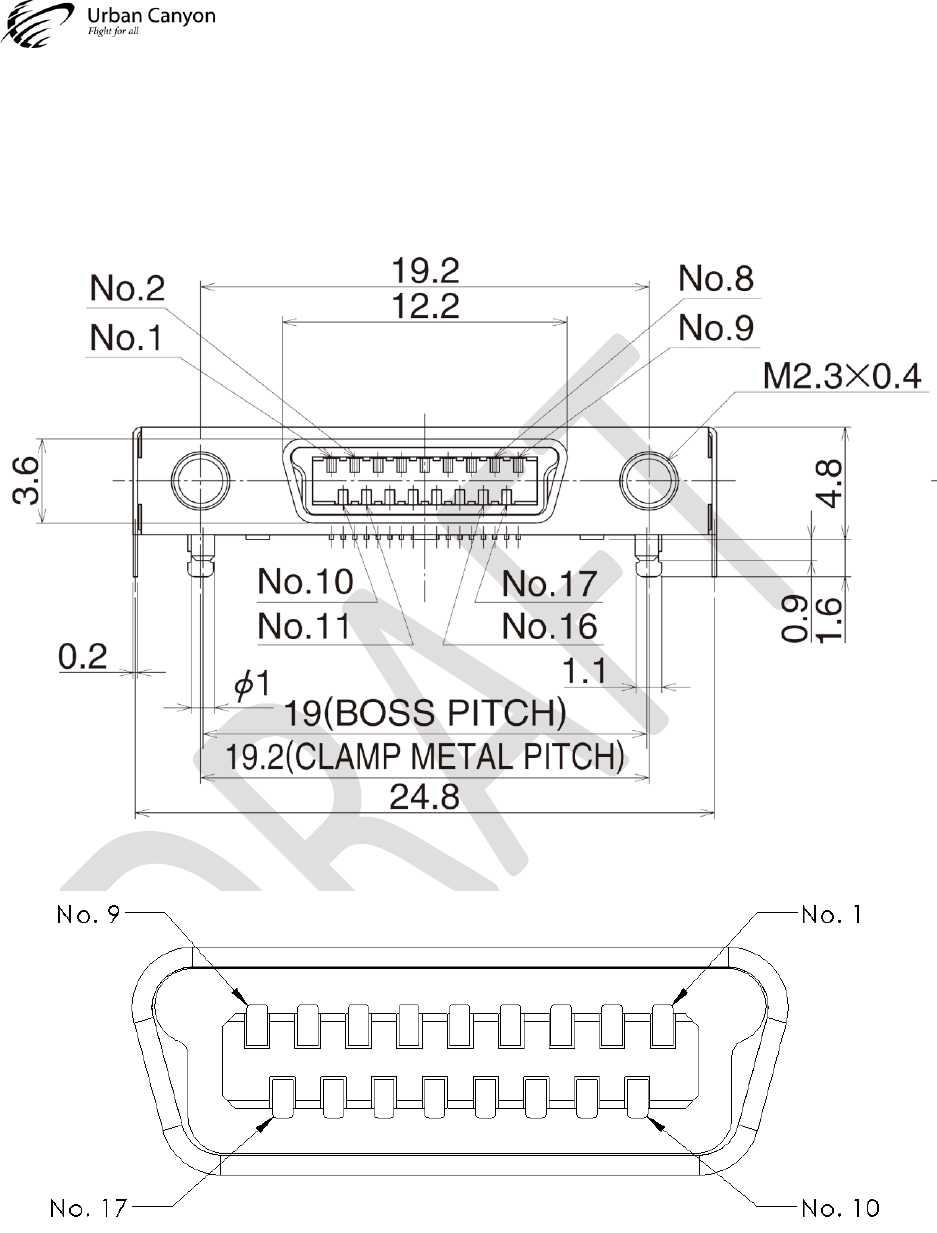
UC10x Installation Manual
URBAN CANYON FLIGHT INC UC10X-001-IM REV02
CONFIDENTIAL & PROPRIETARY PAGE 44 OF 69
10.1 Power / Data Connector Pinout & Descriptions
The right-angle PCB-mount connector on the transponder is Hirose DH60-17P. The mating connector for the cable
is DH30B-17S (IDC crimp) or DH40-17S (solder cup). Figure 12 shows the connector pinout as viewed looking into
the transponder, and Figure 13 shows the pinout as viewed into the cable.
Figure 12. Connector Pinout (as viewed into transponder)
Figure 13. Connector Pinout (as viewed into the cable)
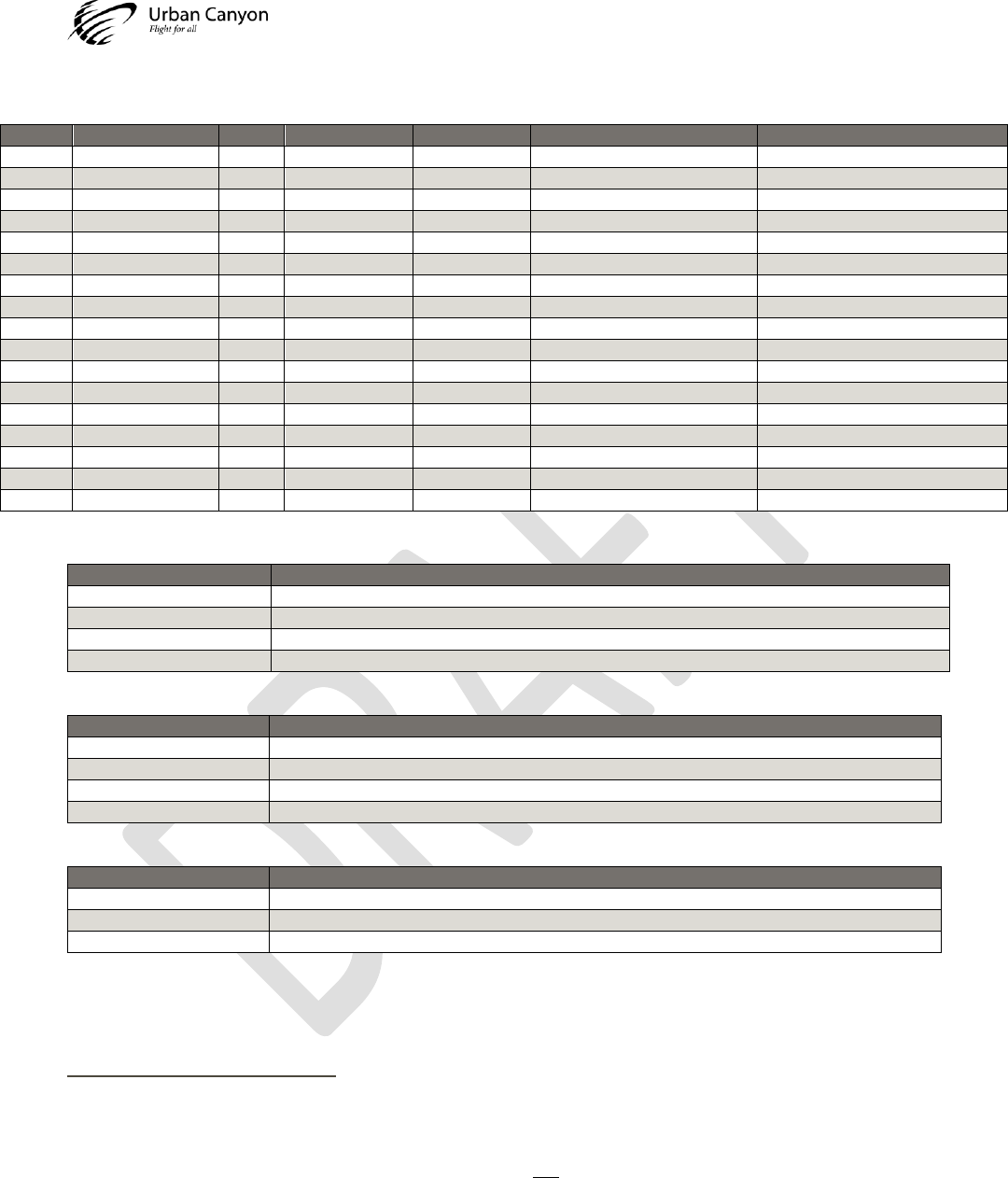
UC10x Installation Manual
URBAN CANYON FLIGHT INC UC10X-001-IM REV02
CONFIDENTIAL & PROPRIETARY PAGE 45 OF 69
Table 17. Interface Pinout
Pin#
Description
Dir
Type
Level
Notes
If Not Used
1
VIN
I
PWR
10 - 38 VDC
Power Input
Must be implemented
2
GND
I
GND
0 VDC
Power Return
Must be implemented
3
RSVD
DNC
-
-
Reserved for future use
No connection
4
RSVD
DNC
-
-
Reserved for future use
No connection
5
SUPPRESS
I/O
Open Drain36
LVTTL
Drive with open drain
No connection
6
RSVD
DNC
-
-
Reserved for future use
No connection
7
RSVD
DNC
-
-
Reserved for future use
No connection
8
TXD1
O
RS-232
TIA-232-F34
57.6 kbps 8N1
Must be implemented35
9
TXD0
O
RS-232
TIA-232-F34
57.6 kbps 8N1
Must be implemented35
10
VIN
I
PWR
10 - 38 VDC
Power Input
Must be implemented
11
GND
I
GND
0 VDC
Power Return
Must be implemented
12
RSVD
DNC
-
-
Reserved for future use
No connection
13
RSVD
DNC
-
-
Reserved for future use
No connection
14
SQUAT
I
Open Drain36
LVTTL
Drive with open drain
No connection
15
PWR_DOWN
I
Open Drain37
TTL
0: normal; 1: power down
No connection
16
RXD1
I
RS-232
TIA-232-F34
57.6 kbps 8N1
Must be implemented35
17
RXD0
I
RS-232
TIA-232-F34
57.6 kbps 8N1
Must be implemented35
Table 18. Key for Pinout Table
Dir
Explanation
I
Input to transponder
O
Output from transponder
I/O
Logical bi-directional input/output
DNC
Do not connect
Type
Explanation
PWR
Input power to device
GND
Ground
Open Drain
Drive with open drain/collector
RS-232
Communications to/from device
Level
Explanation
LVTTL
Low-voltage (3.3V) transistor-transistor logic
TTL
5V Transistor-transistor logic (compatible with LVTTL)
TIA-232-F
Telecommunications Industry Association (TIA) defining RS-232
34
Designed to meet EIA/TIA-232 and V.28/V.24 Specifications. Note that if a given output is unused, the RS232
Converter IC will automatically disable, and read 0V (instead of the RS-232 idle line negative voltage). THIS IS
NORMAL. The RS-232 output will automatically re-enable once its input is connected.
35
At least one set of RS-232 must be connected (TXD0/RXD0 OR TXD1/RXD1), the other should be left floating if
unused to minimize power consumption. Port 0 and Port 1 are identical and can be used interchangeably.
36
Pullup resistor to 3.3V
37
Pulldown resistor to GND
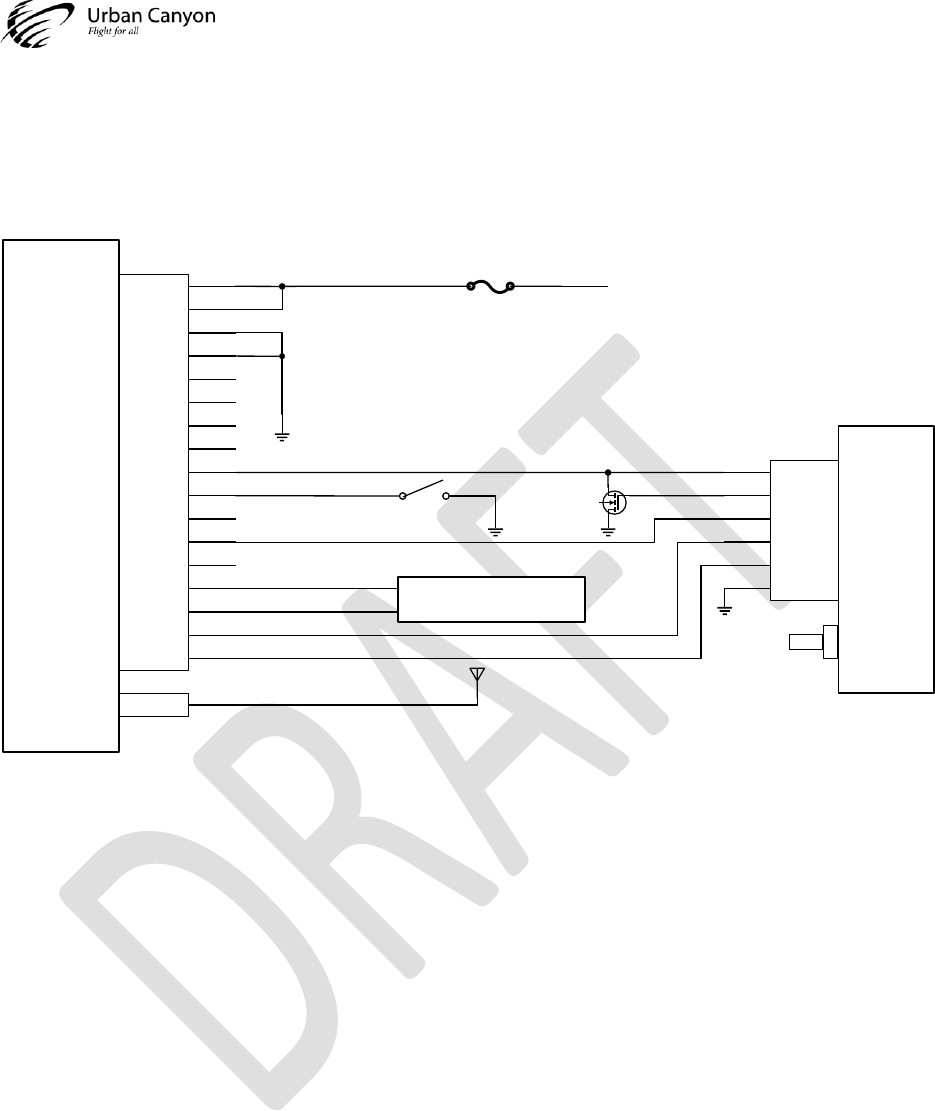
UC10x Installation Manual
URBAN CANYON FLIGHT INC UC10X-001-IM REV02
CONFIDENTIAL & PROPRIETARY PAGE 46 OF 69
10.2 Basic Interconnect Diagram – With Options
Figure 14 below provides an example installation with all options shown.
VIN
VIN
GND
GND
RSVD
RSVD
RSVD
RSVD
SUPPRESS
SQUAT
RSVD
PWR_DOWN
RSVD
RXD1
TXD1
RXD0
TXD0
RF-SMA(F)
10
1
2
11
3
12
4
13
5
14
6
15
7
16
8
17
9
COAX
UC101, UC102
or UC103
Transponder or
UC100 TABS Device
CIRCUIT BREAKER
1A Slow-Blow
X
X
X
X
X
X
ANTENNA
WOW Switch
(Optional)
GPS/GNSS RS-232 Position Source
for ADS-B
(Optional)
10-38V DC
SUPPR_IN
SUPPR_OUT
PWR_DOWN
TXD_232
RXD_232
GND
Autopilot /
Controller
(Head Unit)
Static Pressure Line
N-Channel
MOSFET
(Optional)
Figure 14. UC10x Basic System-Level Interconnect Diagram (with options)
Notes on Figure 14:
• Port 0 (RXD0/TXD0) and Port 1 (RXD1/TXD1) are interchangeable
• 1A circuit breaker is appropriate over the entire operating voltage range. For operation at higher voltages
(e.g. 28V), 500mA slow-blow may be preferred.
• Functions /external hardware provided in customer circuit: controller, GPS, antenna, antenna cable,
altitude encoder, Weight-on-Wheels (WOW) switch, suppress interface, circuit breaker
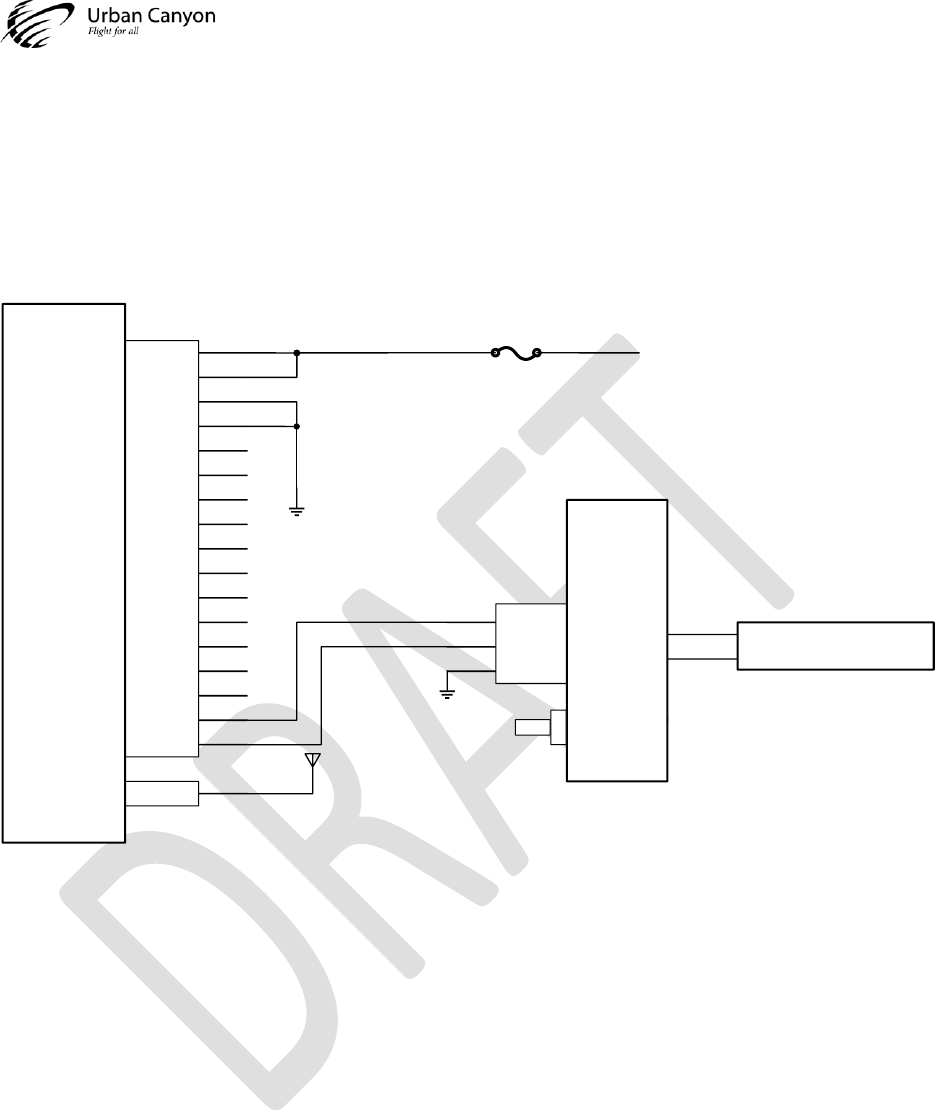
UC10x Installation Manual
URBAN CANYON FLIGHT INC UC10X-001-IM REV02
CONFIDENTIAL & PROPRIETARY PAGE 47 OF 69
10.3 Basic Interconnect Diagram – Minimum Connections
The minimum connections are the antenna, power, ground, and one set of RS-232 communication lines. Be sure to
connect two pins for power, and two for ground. An example of the minimum connections shown in Figure 15
below.
VIN
VIN
GND
GND
RSVD
RSVD
RSVD
RSVD
SUPPRESS
SQUAT
RSVD
PWR_DOWN
RSVD
RXD1
TXD1
RXD0
TXD0
RF-SMA(F)
10
1
2
11
3
12
4
13
5
14
6
15
7
16
8
17
9
COAX
UC101, UC102
or UC103
Transponder or
UC100 TABS Device
CIRCUIT BREAKER
1A Slow-Blow
X
X
X
X
X
X
ANTENNA
GPS/GNSS RS-232 Position Source
for ADS-B
(Optional)
10-38V DC
TXD_232
RXD_232
GND
Autopilot /
Controller
(Head Unit)
Static Pressure Line
Figure 15. UC10x Basic System-Level Interconnect Diagram (minimum connections)
Notes on Figure 15:
➢ Port 0 (RXD0/TXD0) and Port 1 (RXD1/TXD1) are interchangeable
➢ 1A circuit breaker is appropriate over the entire operating voltage range. For operation at higher voltages
(e.g. 28V), 500mA slow-blow may be preferred.
➢ Functions /external hardware provided in customer circuit: controller, GPS, antenna, antenna cable,
altitude encoder, circuit breaker
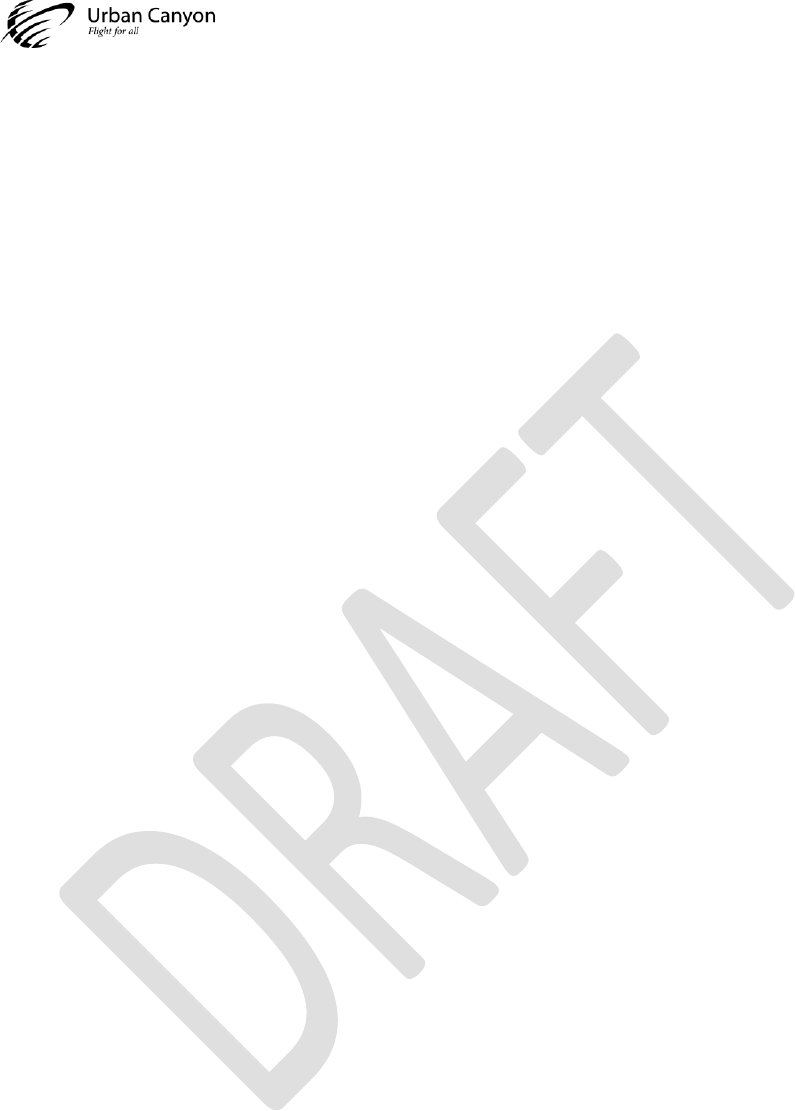
UC10x Installation Manual
URBAN CANYON FLIGHT INC UC10X-001-IM REV02
CONFIDENTIAL & PROPRIETARY PAGE 48 OF 69
This page intentionally left blank.

UC10x Installation Manual
URBAN CANYON FLIGHT INC UC10X-001-IM REV02
CONFIDENTIAL & PROPRIETARY PAGE 49 OF 69
11 Equipment Installation
11.1 General
The equipment should be installed in the aircraft in a manner consistent with acceptable workmanship and
engineering practices and in accordance with the instruction set forth in this publication. To ensure that the
system has been properly and safely installed in the aircraft, the installer should make a through visual inspection
and conduct an overall operation check of the system on the ground prior to flight.
The TSO identifies the minimum performance standards, tests, and other conditions applicable for issuance of
design and production approval of the article. The TSO applicant is responsible for documenting all limitations and
conditions suitable for installation of the article. An applicant requesting approval for installation of the article
within a specific type or class of product is responsible for determining environmental and functional compatibility.
Caution:
After installation of cabling and before installation of the equipment, a check should be
made with the aircraft primary power supplied to the mounting connector to ensure
that power is applied only to the pins specified in the interconnection drawings.
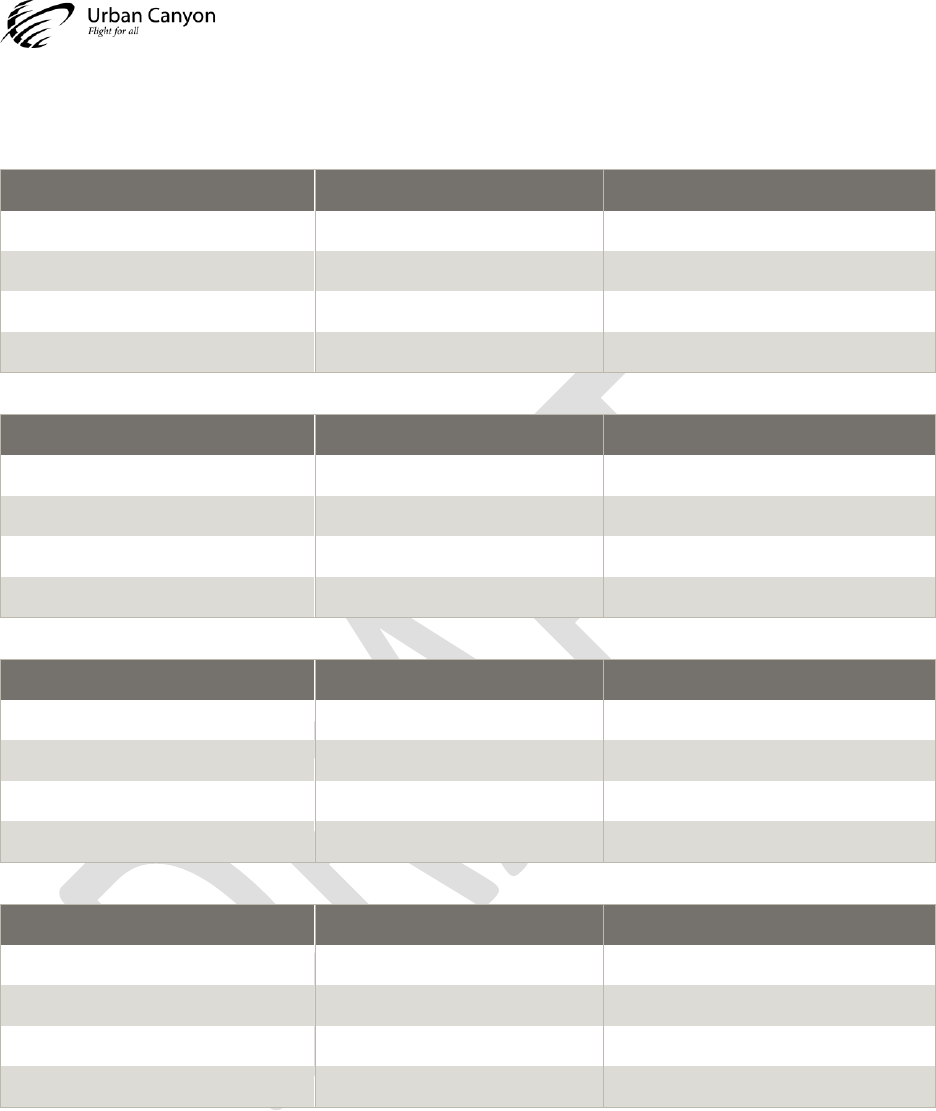
UC10x Installation Manual
URBAN CANYON FLIGHT INC UC10X-001-IM REV02
CONFIDENTIAL & PROPRIETARY PAGE 50 OF 69
11.2 Unit and Accessories Supplied
11.2.1 UC100 Traffic Awareness Beacon System (TABS)
Unit Description
Qty.
Model Number
Traffic Awareness Beacon (TABS)
1
UC100
Interface Cable
1
UC10x-CBL-XXX
RF Cable
1
UC10x-CBL-XXX
Mounting Kit
1
UC10x-HDW-XXX
11.2.2 UC101 Mode C Transponder
Unit Description
Qty.
Model Number
Mode C Transponder
1
UC101
Interface Cable
1
UC10x-CBL-XXX
RF Cable
1
UC10x-CBL-XXX
Mounting Kit
1
UC10x-HDW-XXX
11.2.3 UC102 Mode C Transponder with ADS-B Out
Unit Description
Qty.
Model Number
Mode C Transponder w/ ADS-B Out
1
UC102
Interface Cable
1
UC10x-CBL-XXX
RF Cable
1
UC10x-CBL-XXX
Mounting Kit
1
UC10x-HDW-XXX
11.2.4 UC103 Mode S Transponder with ADS-B Out
Unit Description
Qty.
Model Number
Mode S Transponder w/ ADS-B Out
1
UC103
Interface Cable
1
UC10x-CBL-XXX
RF Cable
1
UC10x-CBL-XXX
Mounting Kit
1
UC10x-HDW-XXX
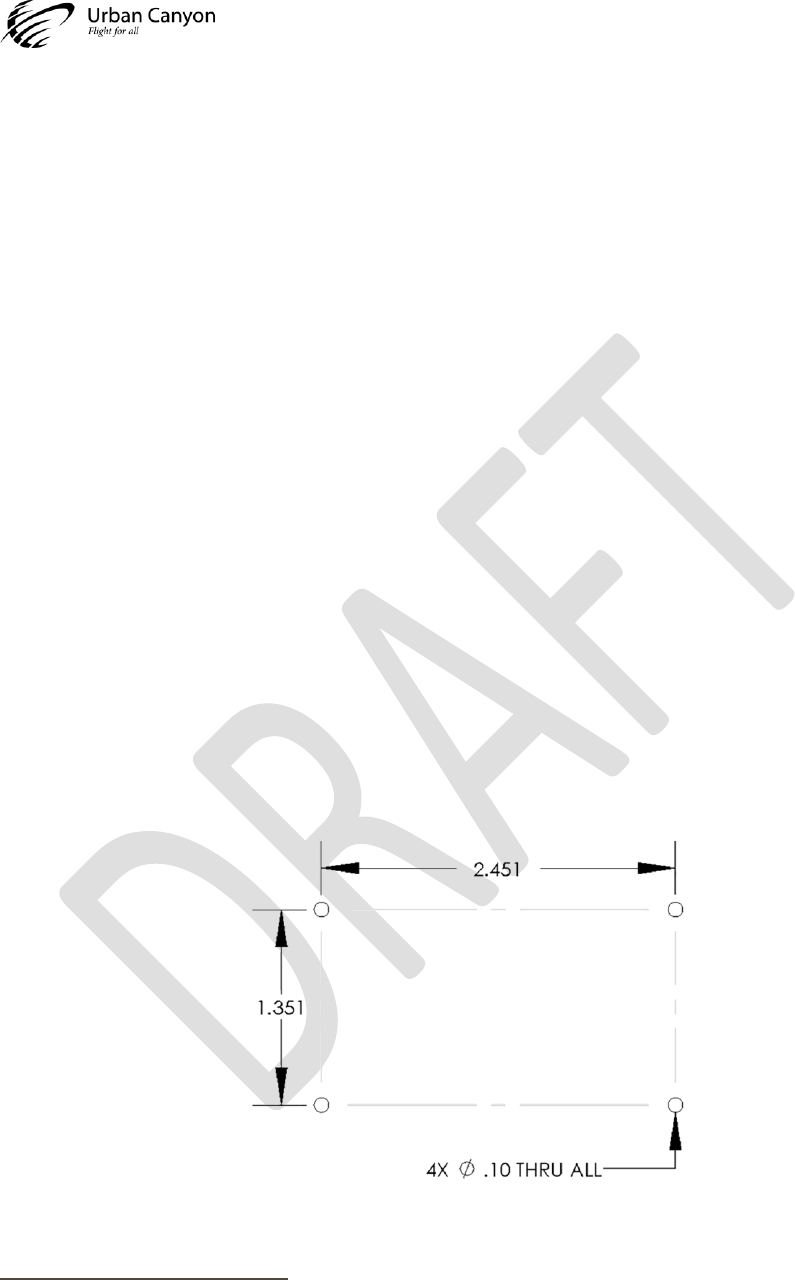
UC10x Installation Manual
URBAN CANYON FLIGHT INC UC10X-001-IM REV02
CONFIDENTIAL & PROPRIETARY PAGE 51 OF 69
11.3 UC10x Installation
11.3.1 Avionics Cooling Requirements
The greatest single contributor to increased reliability of all modern-day avionics is to limit the maximum operating
temperature. While modern day individual circuit designs consume much less electrical energy, the watts per cubic
inch dissipated within avionics units remains much the same because of high density packaging techniques utilized.
Consequently, the importance of providing avionics stack cooling is essential to the life span of the equipment.
11.3.2 Installation Location
The transponder is to be fitted in a suitable place on the aircraft. This is usually the avionics compartment. The
mounting place shall be at least 30 cm from the magnetic aircraft compass, to avoid any interference to the
magnetic compass by the transponder. For installation in a more severe electromagnetic environment use shielded
cable connectors and a common shielding for the transponder wiring. Select a position that is not too close to any
high external heat source. The transponder itself is not a significant heat source and does not need to be kept
away from other devices for this reason.
11.3.3 Mounting Hole Pattern
Mounting fasteners (when provided) are included for convenience and may not be suitable for all installations. You
should reference individual equipment chapters for information regarding installation instructions.
The appropriate mounting pattern hole size and spacing will vary depending upon mounting plate/surface material
and method of drill (machine or hand). The pattern below will be appropriate for most installations, which uses a
0.101” hole (ANSI drill size 38)
38
. Some customers may need to increase the hole size to 0.104” (ANSI drill size 37)
39
or 0.110” (ANSI drill size 35)
40
, depending on the tolerance of the machine (or person) performing the drill
operation.
Figure 16. Mounting Hole Pattern Drawing (SCALE 1:1)
38
Approximate metric equivalent for ANSI drill size 38 (0.101”) is ISO 2.6mm drill size
39
Approximate metric equivalent for ANSI drill size 37 (0.104”) is ISO 2.7mm drill size
40
Approximate metric equivalent for ANSI drill size 35 (0.110”) is ISO 2.8mm drill size
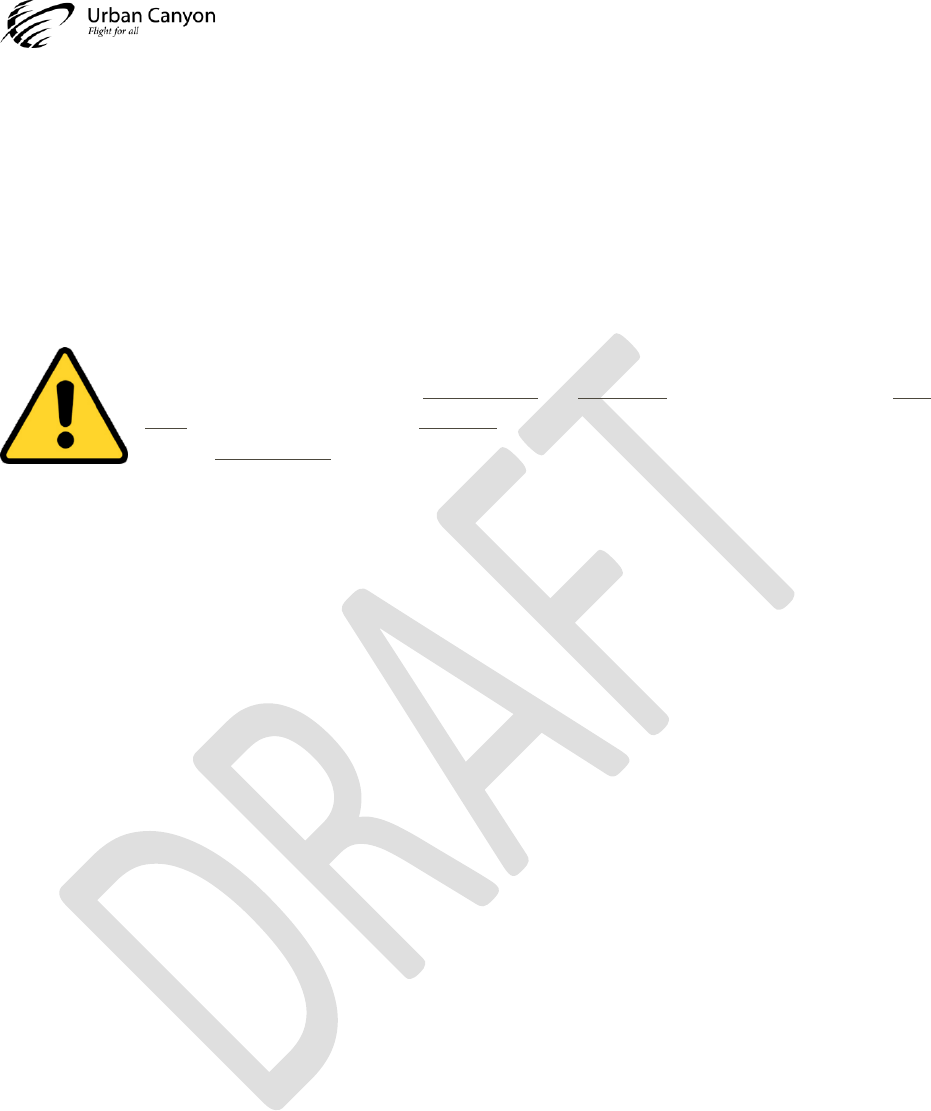
UC10x Installation Manual
URBAN CANYON FLIGHT INC UC10X-001-IM REV02
CONFIDENTIAL & PROPRIETARY PAGE 52 OF 69
11.4 Antenna & Antenna Cable Installation
11.4.1 Disclaimer
This subsection contains guidance on antenna and antenna cable requirements, advice on product selection,
troubleshooting, and recommended best practices for installation. UCF does not sell antennas or antenna cables.
This section provides general guidance on the antenna and cable. If this information conflicts with the
antenna/cable manufacturer’s instructions, the antenna/cable manufacturer’s instructions should supersede
information contained herein.
WARNING: The installer shall be responsible for ensuring that the proper antenna is employed so
that the antenna requirements of 47 CFR 15.203 and TSO-C112E (RTCA/DO-181E §2.215) or TSO-
C74d (RTCA/DO-144A §2.2.11) or TSO-C66c (RTCA/DO-189 §2.2.17), as applicable, are met and
limits of 47 CFR 87.131 are not exceeded.

UC10x Installation Manual
URBAN CANYON FLIGHT INC UC10X-001-IM REV02
CONFIDENTIAL & PROPRIETARY PAGE 53 OF 69
11.4.2 Antenna Requirements (Simplified)
A transponder antenna approved to TSO-C112e , TSO-C74d, or TSO-C66c
41
(or previous versions), that has been
installed to meet the requirements of the installation manual may be approved for use with the UC10x.
For specific technical requirements for the antenna can be found in TSO-C74d (RTCA/DO-181E §2.2.15) (UC100,
UC103) or TSO-C112e (RTCA/DO-144A §2.2.11) (UC101, UC102) or TSO-C66c (RTCA/DO-189 §2.2.17). The antenna
requirements contained in the TSO and associated MOPS are equivalent for all intents and purposes, and can be
used interchangeably. Table 19 provides a simplified summary of antenna requirements.
Table 19. Simplified Interpretation of MOPS Antenna Requirements
Description
Type
Min Gain
Max Gain
Freq
Z0
VSWR
Ground
TSO Antenna
λ/4 Monopole42
2.19 dBi
5.19 dBi
1030-1090MHz
50Ω
1.5 max
4’ dia.
WARNING: It is the responsibility of the end user to know the regulatory requirements for
their application / use case. This is an oversimplified interpretation intended to facilitate
understanding of the antenna requirements. There are other antenna types that could meet
all requirements. There may also be antennas that fall within the description above that do
not meet all requirements. See regulations pertinent to your use case (MOPS, TSO, etc.) for
details and to make your own determination.
41
TSO-C66c is the TSO for distance measuring equipment (DME), which uses the same frequency band, and thus the
same antenna, as transponders
42
Transponder MOPS do not explicitly state monopole, but extrapolating from the required minimum vertical
beamwidth (25°), horizontal beamwidth (360°), and ground plane size (4’ Ø), is an ideal monopole.
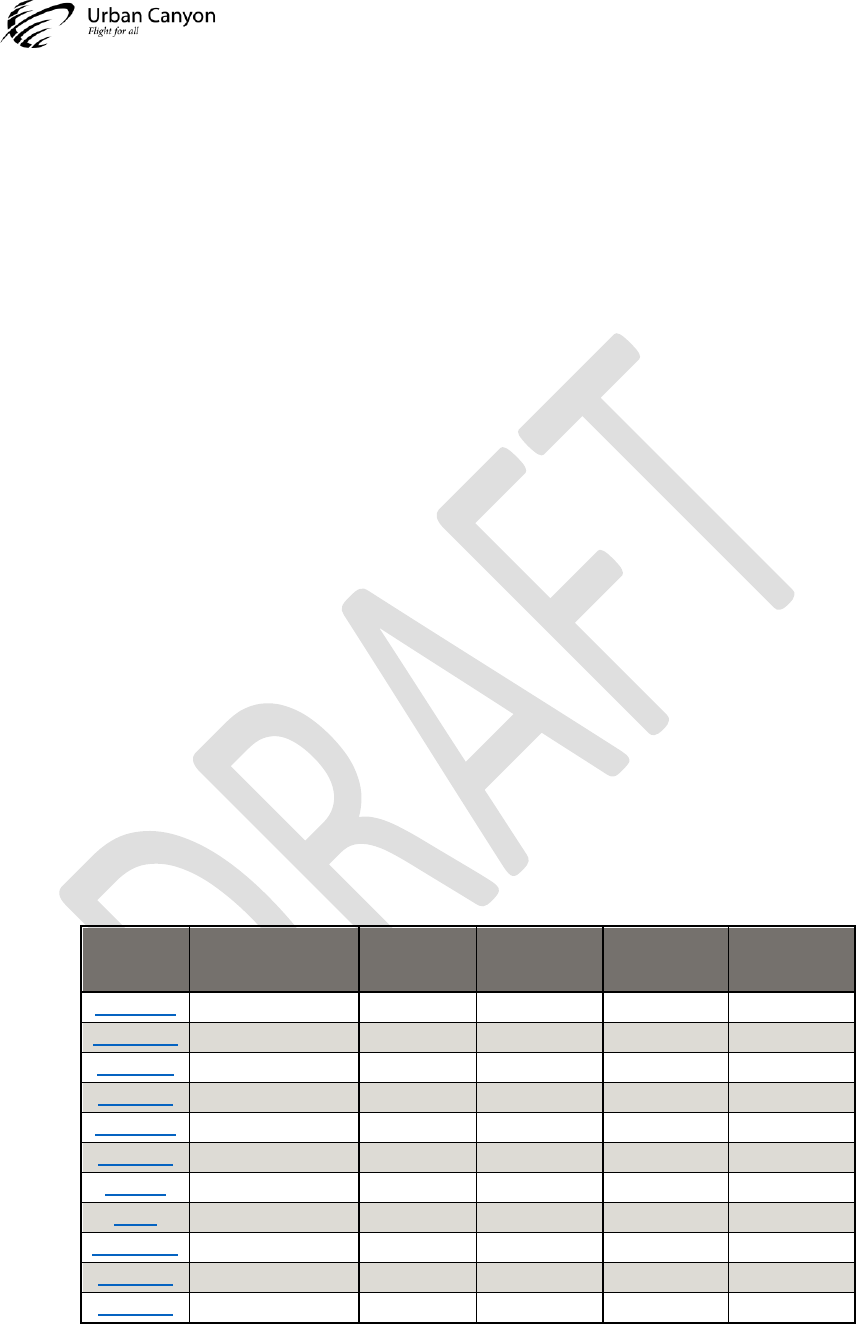
UC10x Installation Manual
URBAN CANYON FLIGHT INC UC10X-001-IM REV02
CONFIDENTIAL & PROPRIETARY PAGE 54 OF 69
11.4.3 Antenna Cable Design / Selection
UC10x system does not include an antenna.
The UC10x family is designed to meet high power (unrestricted altitude) requirements with an allowance of 0 dB
min (UC10x directly connected to antenna) to 1.5 dB maximum insertion loss in the connectors and cables used to
connect it to the antenna. Excessive loss will degrade both transmitter output power and receiver sensitivity.
An acceptable cable:
➢ Has power rating of 3W average at 1GHz minimum (10+ W preferred)
➢ Has voltage rating of 300 VRMS minimum (1,000+ VRMS preferred)
➢ Has less than 1.5 dB loss for the required cable run length (1 dB preferred)
➢ Has a characteristic impedance (Z0) of 50 Ω ± 5 Ω
➢ Has double-braided screens consisting of a combination foil and braid screen
➢ For installations that require frequent disassembly/reassembly, select connectors rated for number of
mating cycles
➢ Uses an SMA male on one end (for the UC10x), and mates with the antenna on the other (depends on
antenna selected)
Once the cable run length is known, a cable type with low enough loss per meter that meets the above
requirements can be chosen. Longer runs require lower loss (usually physically thicker) cable. Consider moving the
transponder closer to the antenna to minimize the losses in the antenna cable – subject to the limits identified
above, the transponder can be at any distance from the control head without affecting performance in any way.
Table 20 below is a guide to the maximum usable lengths for various common cable types. This table uses typical
cable loss data to calculate maximum cable length assuming 1.5dB cable loss. Actual cable loss will vary between
manufacturer and may change after use (e.g. due to repeated cable bending) and should always be verified
through measurement by the end user / installer.
Table 20. Example maximum cable length by cable type
Type
Jacket Dia.
Insertion
Loss (dB/ft)
Max Cable
Length (ft)
Insertion
Loss (dB/m)
Max Cable
Length (m)
RG58-TPX
0.190" [4.83mm]
0.58
2.6
1.90
0.8
RG178B/U
0.072" [1.83mm]
0.44
3.4
1.46
1.0
PE-047SR
0.047" [1.19mm]
0.40
3.8
1.31
1.1
RG316/U
0.098" [2.49mm]
0.38
3.9
1.25
1.2
RG316-DS
0.114" [2.90mm]
0.26
5.7
0.86
1.8
RG58C/U
0.195" [4.95mm]
0.20
7.5
0.66
2.3
RG58-P
0.159" [4.04mm]
0.17
8.7
0.57
2.6
RG8X
0.242" [6.15mm]
0.14
11.1
0.44
3.4
RG141A/U
0.190" [4.83mm]
0.13
11.5
0.43
3.5
RG213/U
0.405" [10.29mm]
0.08
18.8
0.26
5.7
RG218/U
0.870" [22.1mm]
0.04
39.5
0.12
12.0
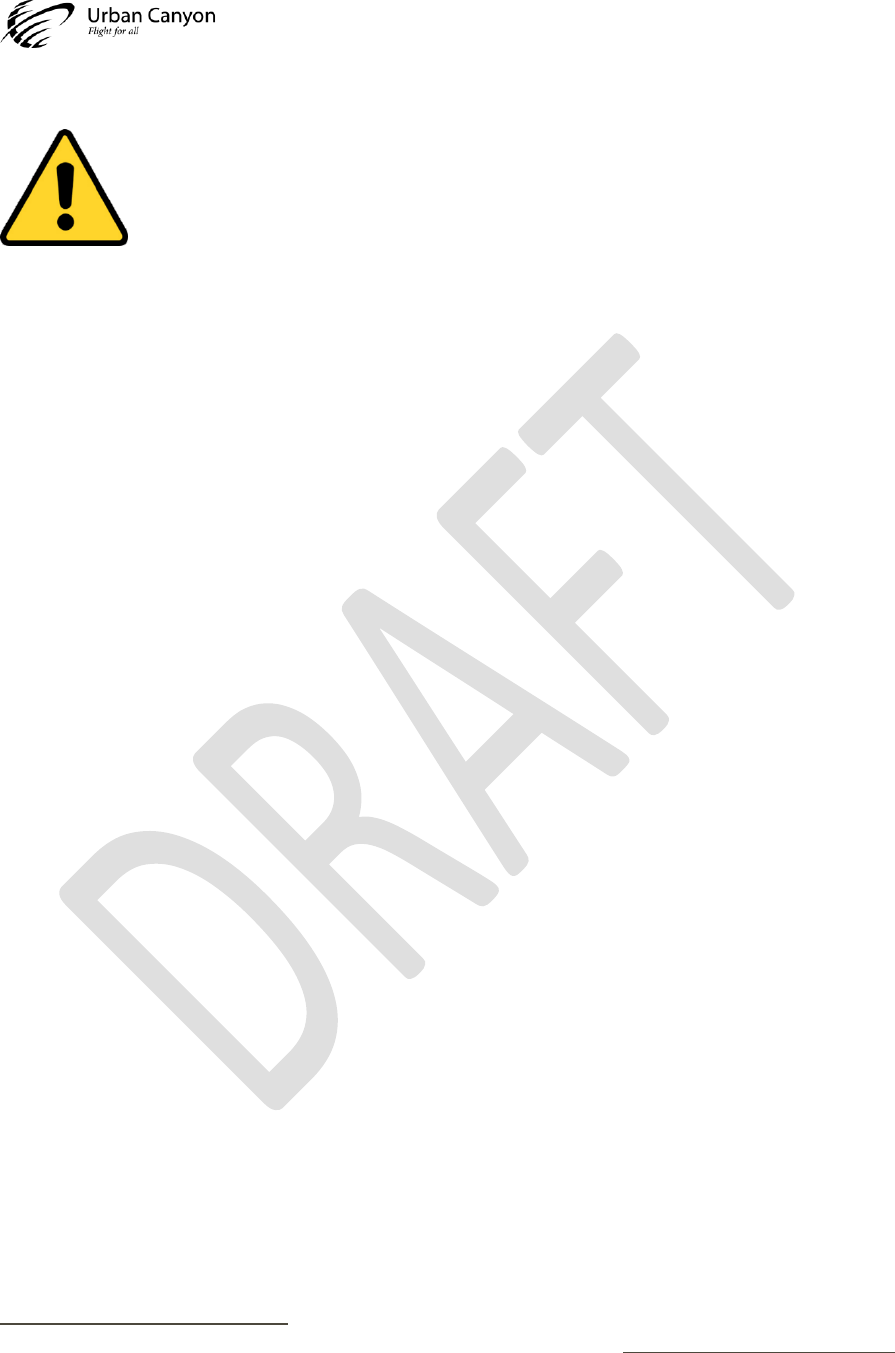
UC10x Installation Manual
URBAN CANYON FLIGHT INC UC10X-001-IM REV02
CONFIDENTIAL & PROPRIETARY PAGE 55 OF 69
WARNING: The cable losses / and calculated cable lengths in Table 20 are representative of
typical values, and do not include connector losses. Use this table as a maximum cable length for
a given cable type for cable design / product selection. The installer should verify cable loss is
acceptable through measurement (e.g. using a network analyzer
43
)
11.4.4 Antenna Installation Considerations
The antenna should be installed according to the manufacturer’s instructions. The following considerations should
be taken into account when determining appropriate installation location for the antenna.
➢ The antenna should be well removed from any projections, engine(s) and propeller(s). It should also be
well removed from landing gear doors, access doors or other openings which will break the ground plane
for the antenna.
➢ The antenna should be mounted on the bottom surface of the aircraft and in a vertical position when the
aircraft is in level flight.
➢ Where practical, plan the antenna location to keep the cable lengths as short as possible and avoid sharp
bends in the cable to minimize the VSWR.
Electrical connection to the antenna should be protected to avoid loss of efficiency as a result of the presence of
liquids or moisture. All antenna feeders shall be installed in such a way that a minimum of RF energy is radiated
inside the aircraft.
11.4.5 Antenna Cable Routing
When routing the cable, ensure that you:
➢ Route the cable away from source of heat.
➢ Route the cable away from potential interference sources such as ignition wiring, 400 Hz generators,
fluorescent lighting and electric motors.
➢ Keep the run as short as possible
➢ Avoid routing the cable around tight bends.
➢ Avoid kinking the cable even temporarily.
➢ Secure the cable so that it cannot interfere with other systems.
11.4.6 Antenna Ground Plane
When a conventional aircraft monopole antenna is used it relies on a ground plane for correct behavior. For ideal
performance, the ground plane should be large compared to the wavelength of the transmission, which is 275mm.
In a metal-skinned aircraft this is usually easy to accomplish, but is more difficult in a composite or fabric skinned
aircraft. In these cases, a metallic ground plane should be fabricated and fitted under the antenna.
The ground plane should be as large as practical. Because it is a function of the wavelength of the transmission, the
smallest practical ground plane for a transponder is a square around 120mm per side; as the size increases the
43
One example of an inexpensive network analyzer for cable loss measurement: Hewlett Packard (Keysight) 8753D
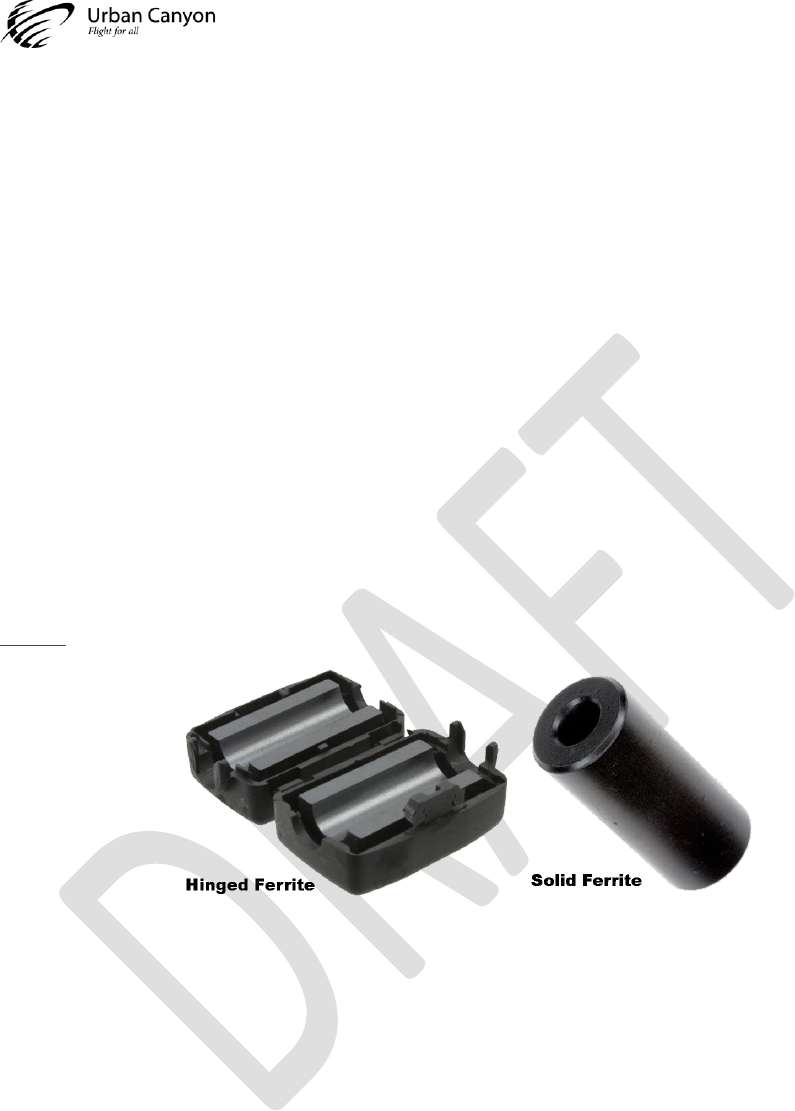
UC10x Installation Manual
URBAN CANYON FLIGHT INC UC10X-001-IM REV02
CONFIDENTIAL & PROPRIETARY PAGE 56 OF 69
performance improves until the ground plane is around 700 mm on each side. Anything much larger than that size
is unlikely to show significant further improvement.
The thickness of the material used to construct the ground plane is not critical, providing it is sufficiently
conductive. A variety of proprietary mesh and grid solutions are available. For example, heavyweight cooking foil
meets the technical requirements, but obviously needs to be properly supported.
For designs that wish to meet requirements of TSO, a ground plane with 4 ft. (1.2 meter) diameter should be used.
11.4.7 Interference Troubleshooting
Aircraft with composite skin can be susceptible to emissions from the transponder antenna coupling to and
reradiating from interconnecting cables and electrically conductive materials in close proximity to the antenna.
This issue can be exacerbated with an undersized antenna ground plane due to increased backwards radiation.
One component primarily prone to coupling with antenna emissions is the outer shield surface of the antenna
coaxial cable. When this coupling occurs, the antenna cable serves as an antenna, radiating to other components
within the aircraft. To help mitigate this issue, a ferrite bead can be clamped over the antenna cable and installed
as close to the antenna end of the cable as practical. For longer cable runs, additional ferrite beads spaced at
intervals of approximately a quarter wavelength at 1090 MHz maybe required. A hinged ferrite is convenient for
field troubleshooting, though a solid cylindrical ferrite is more mechanically robust. These can be purchased at
Digi-Key or other suppliers. Figure 17 below shows examples of various ferrite types.
Figure 17. Example over-the-cable ferrite beads to troubleshoot “reradiating” issue
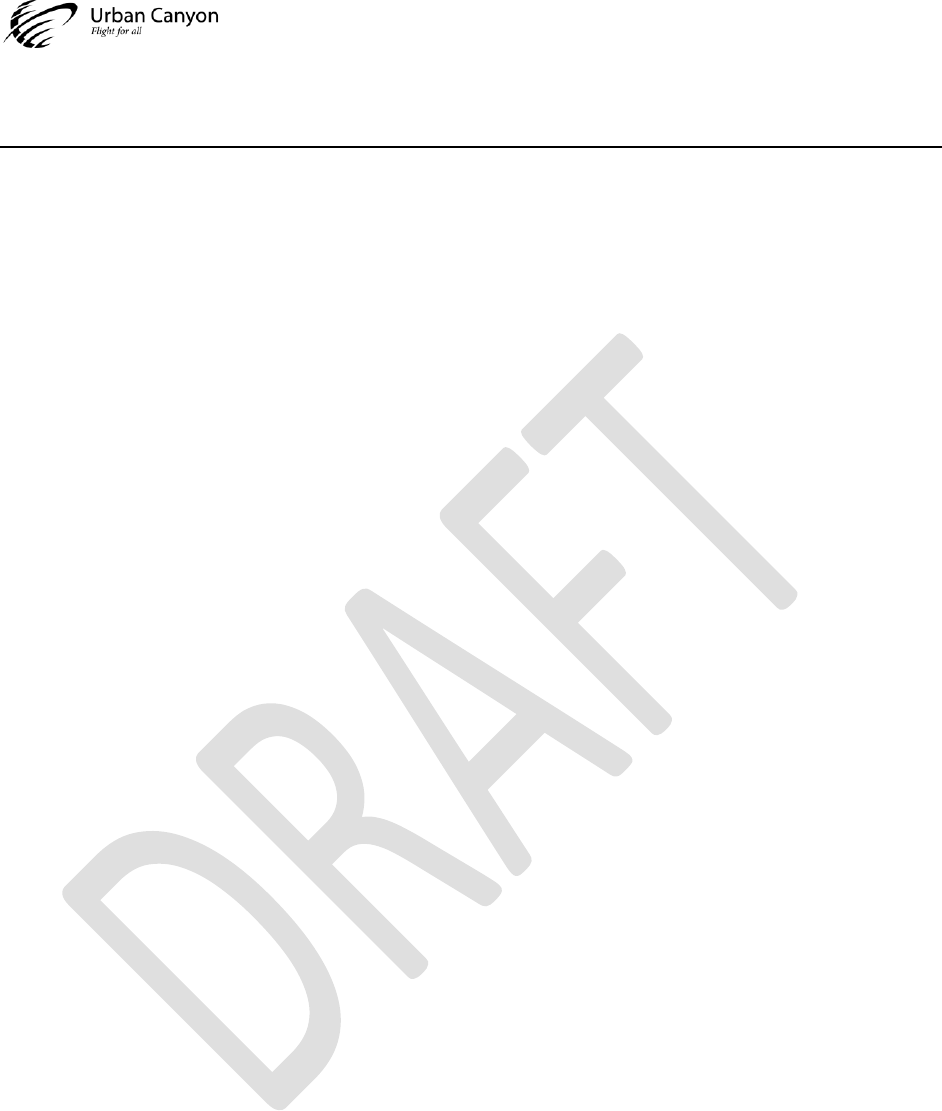
UC10x Installation Manual
URBAN CANYON FLIGHT INC UC10X-001-IM REV02
CONFIDENTIAL & PROPRIETARY PAGE 57 OF 69
12 Installation Setup and Test
12.1.1 Overview
This section provides an overview of information required to configure a unit at time of install. These functions
should be provided by head unit (display) manufacturer for manned aircraft installations, or through a GUI for
unmanned installations. For details, see ICD.
12.1.2 VFR Flight ID
The default Flight ID for an aircraft not on an IFR flight plan should be the aircraft registration.
12.1.3 Aircraft Address Programming
The Mode S Address is a 24-bit number issued to the aircraft by the registration authority for the aircraft. These
addresses are usually written as a 6-digit hexadecimal number, although you may also encounter one written as an
8-digit octal number.
12.1.4 VFR Squawk Code
When the pilot presses the VFR button, a pre-programmed code will replace the current squawk code. The pre-
programmed code is set up here; the choice of code will depend on the normal location of the aircraft. In the USA,
the VFR squawk code is 1200. In most parts of Europe, the VFR squawk code should be set to 7000.
NOTE: default VFR Squawk Code is not implemented directly on the transponder. This should be implemented in the
head unit or GUI, for convenience to the pilot, but is not required.
12.1.5 Airspeed Category
Mode S transponders can transmit their maximum airspeed characteristics to aircraft equipped with TCAS. This
information is used to help identify threats and to plan avoiding action by the TCAS equipped aircraft.
12.1.6 Aircraft Category
To assist ATC tracking of aircraft, an aircraft category can be transmitted by Mode S transponders. Select the
aircraft category that most closely matches the aircraft the transponder is installed in. If the transponder is fitted
to a vehicle rather than an aircraft, select “Surface Vehicle”.
12.1.7 GPS Input
If a GPS is connected for ADS-B position reporting, select the appropriate interface protocol.
12.1.8 GPS Certification Level
An important metric for ADS-B ground system behavior is the System Design Assurance (SDA) level. It is intended
to reflect the probability that the GPS position source is providing erroneous information, and is based on the
certification standard that was used by the GPS vendor. This will be indicated in the form of a letter code (A to D)
on the data plate or installation documentation for the GPS in accordance with the standards DO-178B and DO-
254, for example “DO-178B level C”. If both standards are reported but at different levels, use the standard with
the lower SDA level. Standards (or SDA levels) descend in reverse alphabetical order.
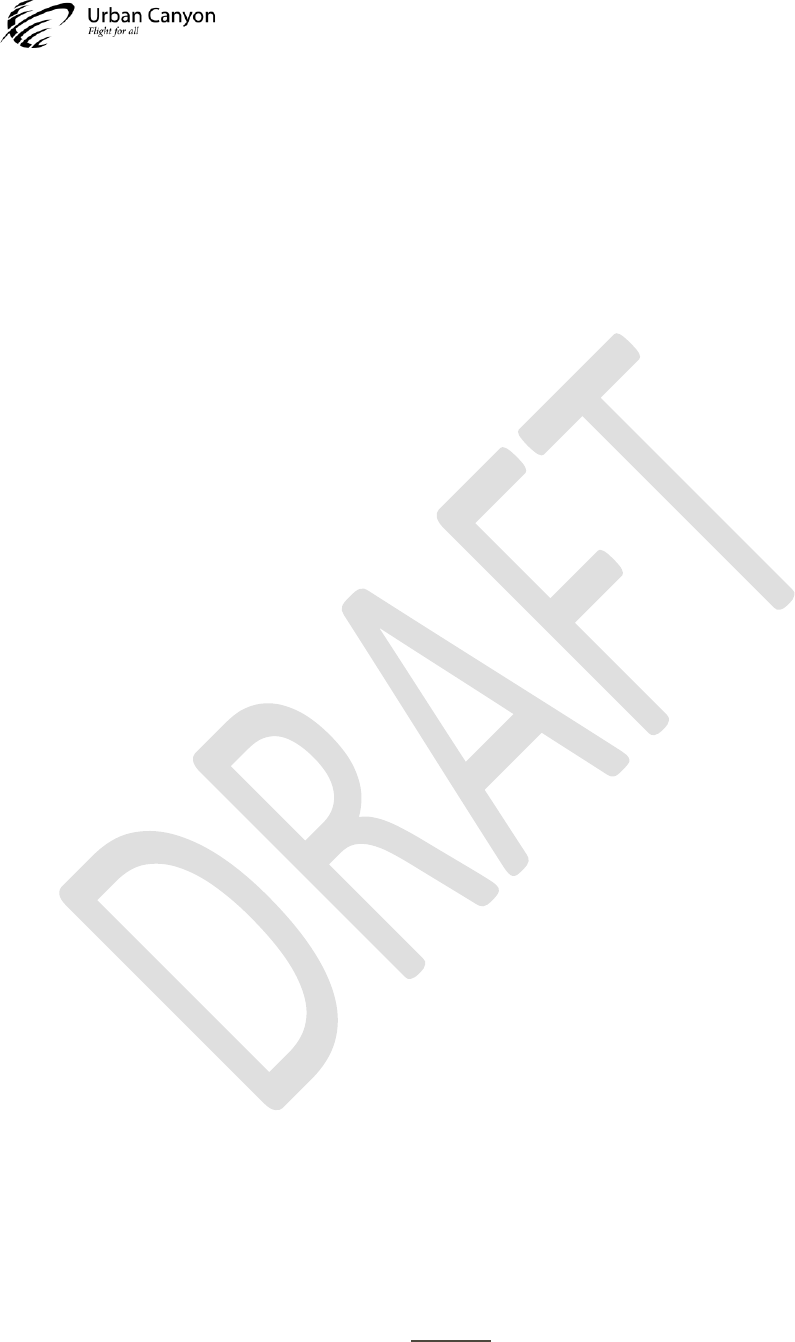
UC10x Installation Manual
URBAN CANYON FLIGHT INC UC10X-001-IM REV02
CONFIDENTIAL & PROPRIETARY PAGE 58 OF 69
12.1.9 GPS NAC velocity
Another metric that the ADS-B ground system uses to help it track the aircraft is NACv. NACv is the Navigational
Accuracy Category for velocity, and is a design feature of the GPS receiver. It represents the error bound for
velocity that the GPS may report in acceleration/deceleration or turning maneuvers. You can find this information
from your GPS installation manual.
12.1.10 Aircraft Length and Width
On the ground, ADS-B transmits encoded aircraft size information which is used by ATC to identify taxiing routes
and potential conflicts. When configured for ADS-B, the UC10x will require aircraft length and width (wingspan)
information, in meters, for proper configuration.
12.1.11 GPS Antenna Offset
The GPS antenna offset is used together with the aircraft length and width to manage taxiway conflicts. A typical
GPS installation does not report the geographic position of the center of the aircraft, or even the tip of the nose of
the aircraft; instead it usually reports the location of the actual GPS antenna (not the GPS receiver). During normal
flight operations, this distinction is of no practical importance at all, but if ADS-B is used to manage taxiway
conflicts, a significant offset in antenna position could mean that the aircraft is not in the same place as the ADS-B
reported position. Although primarily intended for position correction on large transport aircraft, General Aviation
aircraft can also have a significant offset. For example, if the aircraft has a long tail boom and the GPS antenna is
on the top of the tail, the GPS position could be 4 meters or more from the nose of the aircraft. Enter the position
of the GPS antenna relative to the nose of the aircraft. The position is stored and transmitted to the nearest 2
meters; great accuracy in measurement is not required.
12.1.12 1090 MHz Receiver Installed
The ADS-B transmissions include an indication to the ground stations of whether your aircraft includes a 1090 MHz
ADS-B receiver. This is then used by ground stations to manage the RF spectrum for uplink of traffic data. If you
have a 1090 MHz ADS-B receiver installed, be sure to indicate it so that you receive appropriate traffic data.
12.1.13 UAT Receiver Installed
The ADS-B transmissions include an indication to the ground stations of whether your aircraft includes a UAT ADS-
B receiver. This can be used by the ground stations to manage the uplink of traffic, weather, pilot data, etc. If you
have a UAT receiver installed, be sure to indicate it so that you receive appropriate data uplink.
12.2 Test and Calibration Items
12.2.1 Altitude Encoder Calibration
The Altitude Encoder is not provided with the UC10x. However, altitude encoder data—sourced from a static
pressure sensor—must be provided.
Altitude encoder calibration is typically performed every 24 months, as part of the altimeter checks on the aircraft.
Altitude encoder calibration ensures that the altitude transmitted by the transponder corresponds to the altitude
seen by the pilot on the primary altimeter. The maximum allowed difference between the primary altimeter and
the altitude encoder is 125 ft. (per ETSO-C88a and TSO-C88b).

UC10x Installation Manual
URBAN CANYON FLIGHT INC UC10X-001-IM REV02
CONFIDENTIAL & PROPRIETARY PAGE 59 OF 69
The altitude encoder calibration can be performed with the ATC transponder tests and inspections defined in 14
CFR Part 43 Appendix F, which are also required every 24 months.
Note: The purpose of calibrating the encoder is to make the output correspond to the primary altimeter. In the
event that the sensor used for the encoder is the same sensor used as the primary altimeter, no calibration should
be necessary. Any offset required should be applied to the altitude encoder / altimeter itself, or in the autopilot (not
stored in the transponder). It is always the responsibility of the installer to ensure compliance with relevant
standards.
12.3 Calibration Equipment
To calibrate the encoder, you will need to be able to power up the transponder subsystem, and you will need a
pitot-static test set with the appropriate adapters to connect to the static port on the aircraft. The pitot-static test
set should be able to drive the altitude down to sea level, and above the service ceiling of the aircraft.
12.4 Post Installation Checkout and Operation
Post installation checks should be carried out in accordance with your certification requirements. These checks
should include:
➢ Mode S interrogations to verify correct address programming.
➢ Verification of the reported altitude using a static pressure tester.
➢ Where installed, verification of correct squat switch ground/airborne indications. In an aircraft with a
squat switch, setting the mode to ALT when the aircraft is on the ground should cause the transponder to
GND mode; when the aircraft becomes airborne, the mode should switch automatically to ALT.
➢ Interrogations to verify the receiver sensitivity. A Mode S transponder should have a minimum triggering
level (MTL) of between -77 dBm and -71 dBm. Failure to meet this requirement usually indicates antenna
or coaxial cable problems.
➢ Interrogations to verify the transmitted power. A Class 1 installation should have no less than 125 Watts
at the antenna (and no more than 500 Watts). A Class 2 installation should have no less than 71 Watts at
the antenna (and no more than 500 Watts). Failure to meet this requirement is also generally due to
antenna or wiring issues.
➢ Where installed, verification of the GPS position source and ADS-B outputs. Whenever a valid position is
received by the transponder and the transponder is in any mode other than OFF, ADS-B Extended
Squitters should be observed on the transponder test set.
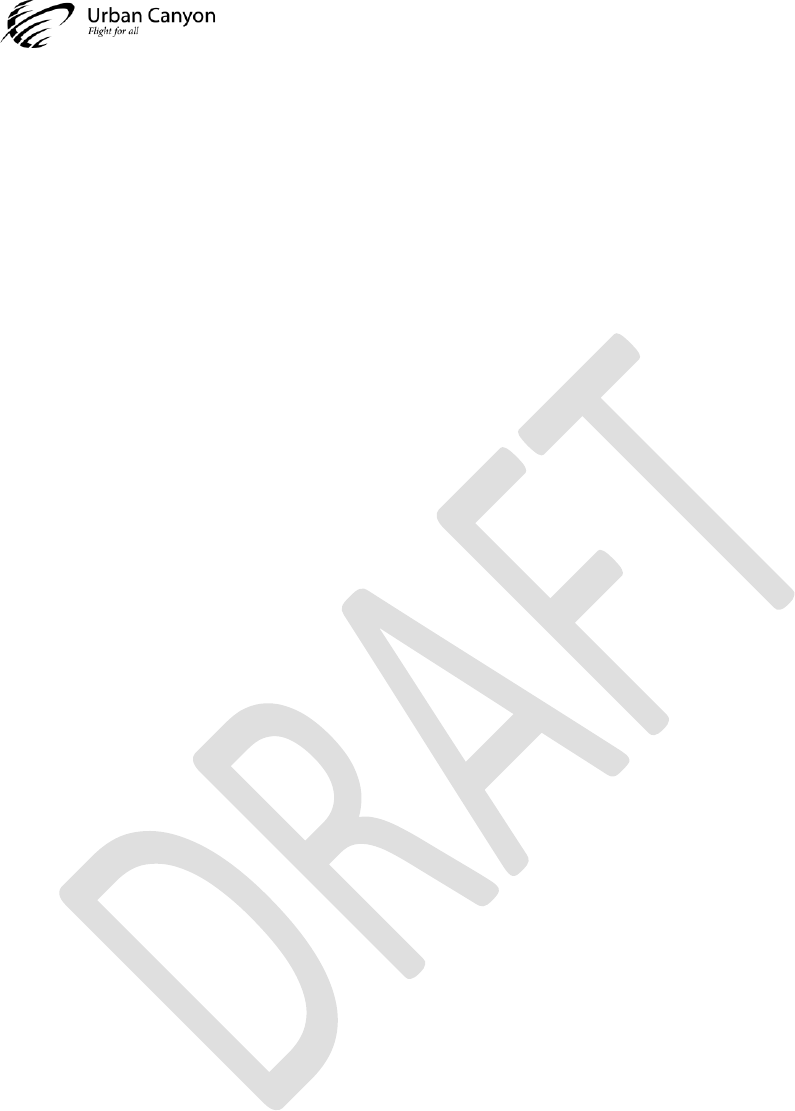
UC10x Installation Manual
URBAN CANYON FLIGHT INC UC10X-001-IM REV02
CONFIDENTIAL & PROPRIETARY PAGE 60 OF 69
This page intentionally left blank.

UC10x Installation Manual
URBAN CANYON FLIGHT INC UC10X-001-IM REV02
CONFIDENTIAL & PROPRIETARY PAGE 61 OF 69
13 Instructions for Continued Airworthiness
13.1 Scheduled Maintenance
The UC10x series is a transponder device and must be tested and inspected every 24 months subject to the
requirements of 14 CFR Part 43 Appendix F – ATC Transponder Tests and Inspections.
13.2 Service Life
The instructions for continued airworthiness given in the TC or STC approvals for this product supplements or
supersedes the instructions for continued airworthiness in this manual.
Urban Canyon Flight products are designed and manufactured such that there are no periodic service
requirements necessary to maintain continued airworthiness. Outside of inspections required by regulatory
agencies, no maintenance is required until the equipment does not properly perform its intended function. When
service is required, the unit should be returned to manufacturer for RMA.
13.3 Repairability
The UC10x is not field repairable, and must be returned to the manufacturer.
13.4 Field Firmware Updates
Field updates are not supported. The unit must be returned to the manufacturer.
13.5 ADS-B
The installed ADS-B OUT system must be shown to meet the equipment requirements of 14 CFR 91.227 or
equivalent.
13.5.1 Altimetry Systems and Altitude Reporting Equipment
Altitude reporting equipment connected to the ADS-B system must comply with all applicable 14 CFR 91.217, 14
CFR 91.411, and 14 CFR Part 43 Appendix E test and inspection requirements. Refer to FAA Advisory Circular AC 43-
6C. ADS-B installation (or lack thereof) does not alter these requirements.
13.5.2 Maintenance and Design Changes to Interfacing Components
The ADS-B system interfaces with multiple external components, such as position sources and altimetry sources.
The installer should list all interfacing components in the instructions for continued airworthiness (ICA). It is
important that any future maintenance or design changes to these interfacing components be accomplished in
such a way that continued satisfactory performance of the overall ADS-B system is maintained.
13.5.2.1 Maintenance of the ADS-B System
The ADS-B system installation must include ICA that meet the typical requirements for a system installation, which
includes how to accomplish a complete functional check of the system.
13.5.2.2 ADS-B Source System Components
The installer may not have access to the specific source system ICA to incorporate changes into those specific
documents, the installer must do an analysis of the source systems to determine what maintenance actions on
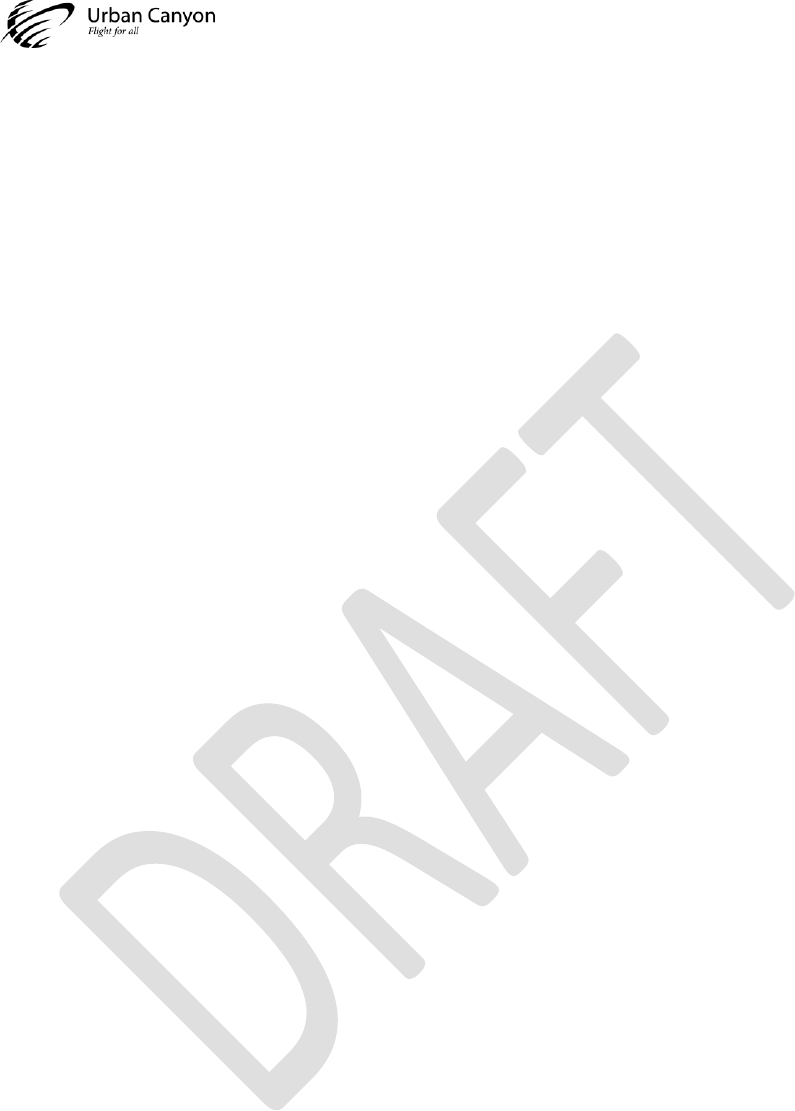
UC10x Installation Manual
URBAN CANYON FLIGHT INC UC10X-001-IM REV02
CONFIDENTIAL & PROPRIETARY PAGE 62 OF 69
those source systems would require a functional test of the ADS-B system to verify that the system is operating
properly. In particular, those systems providing a dedicated input to the ADS-B system that cannot be verified by
other means should be tested as part of the ADS-B system as a whole. Once the installer identifies those actions,
they must provide recommended language for the operator to include in their ICA. If the installer determines that
removal and replacement of the Global Positioning System (GPS) receiver requires a full functional check of the
ADS-B system because the GPS input to the ADS-B cannot be verified by other means.
13.5.2.3 Design Changes to Interfacing Components
Ensuring continued airworthiness of the ADS-B system following upgrades of interfacing components could be
problematic if the installer of the ADS-B system is unaware of design changes to interfacing components, or if the
installer of the updated interfacing component is unaware of a potential impact to the ADS-B system. To avoid this
problem, the ADS-B system installer must update the ICA for each interfacing system with a process that ensures
continued airworthiness of the ADS-B system following design changes to the interfacing component.
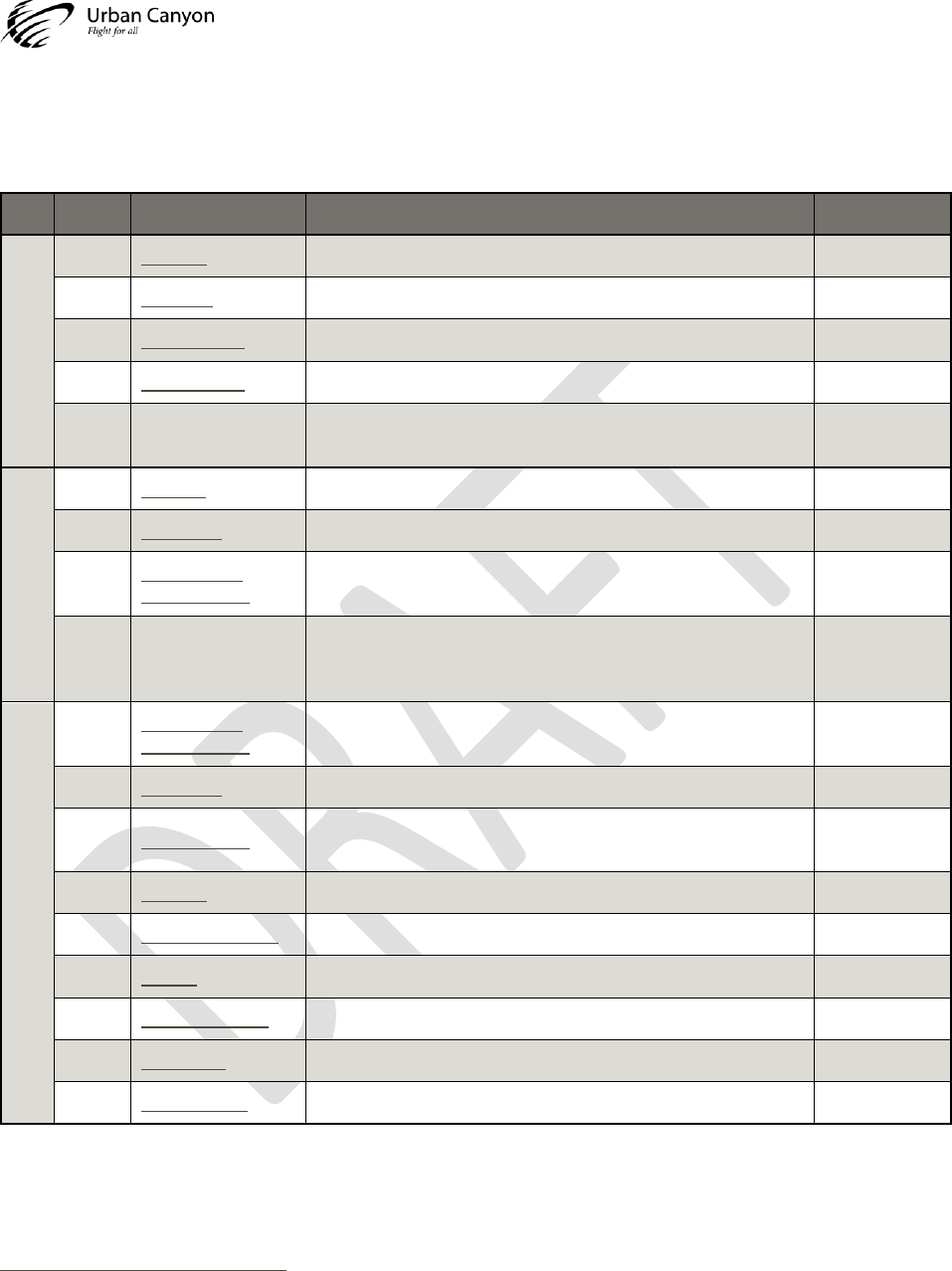
UC10x Installation Manual
URBAN CANYON FLIGHT INC UC10X-001-IM REV02
CONFIDENTIAL & PROPRIETARY PAGE 63 OF 69
14 Referenced & Important Documents
Table 21. Referenced & Important Standards & Regulatory Documents
Cat
Org
Doc. No.
Document Title
Date
Mode A/C
RTCA
DO-144A
MOPS for ATCRBS Airborne Equipment
2 Oct 2008
FAA
TSO-C74d
ATCRBS Airborne Equipment
17 Dec 2008
CFR
14 CFR 91.413
ATC transponder tests and inspections.
Current
CFR
14 CFR 91.215
ATC transponder and altitude reporting equipment & use
Current
ICAO
Annex 10, Volume
IV, Fourth Edition
Surveillance and Collision Avoidance Systems44
Jul 2007
Mode S
RTCA
DO-181E
MOPS for ATCRBS/Mode S Airborne Equipment
17 Mar 2011
FAA
TSO-C112e
ATCRBS/Mode S Airborne Equipment
16 Sept 2013
RTCA
DO-260B with
Corrigendum 1
MOPS for 1090ES ADS-B and TIS-B
13 Dec 2011
ICAO
Annex 10, Volume
III, Part 1, Chapter 5,
Second Edition
SSR Mode S Air-Ground Data Link45
20 Nov 2008
ADS-B
RTCA
DO-260B with
Corrigendum 1
MOPS for 1090ES ADS-B
13 Dec 2011
FAA
TSO-C166b
Extended Squitter ADS-B and TIS-B on RF of 1090 MHz
2 Dec 2009
FAA
None Provided
Note to Manufacturers Regarding the Use of Geometric Type
Codes When In the Altitude Reporting Off Condition
5 Nov 2015
RTCA
DO-242A
MASPS for ADS-B
25 Jun 2002
RTCA
DO-242A Change 1
MASPS for ADS-B Change 1
13 Dec 2006
RTCA
DO-289
MASPS for Aircraft Surveillance Applications (ASA)
09 Dec 2003
RTCA
DO-289 Change 1
MASPS for Aircraft Surveillance Applications (ASA) Change 1
13 Dec 2006
FAA
AC 20-165B
Airworthiness Approval of ADS-B OUT Systems
7 Dec 2015
DOT
14 CFR Part 91
ADS-B Final Rule
28 May 2010
44
Contains elaboration on ICAO 24-bit Address and Parity Field (AP and PI) Generation for Mode S
45
Contains elaboration on Mode S packet creation and interpretation
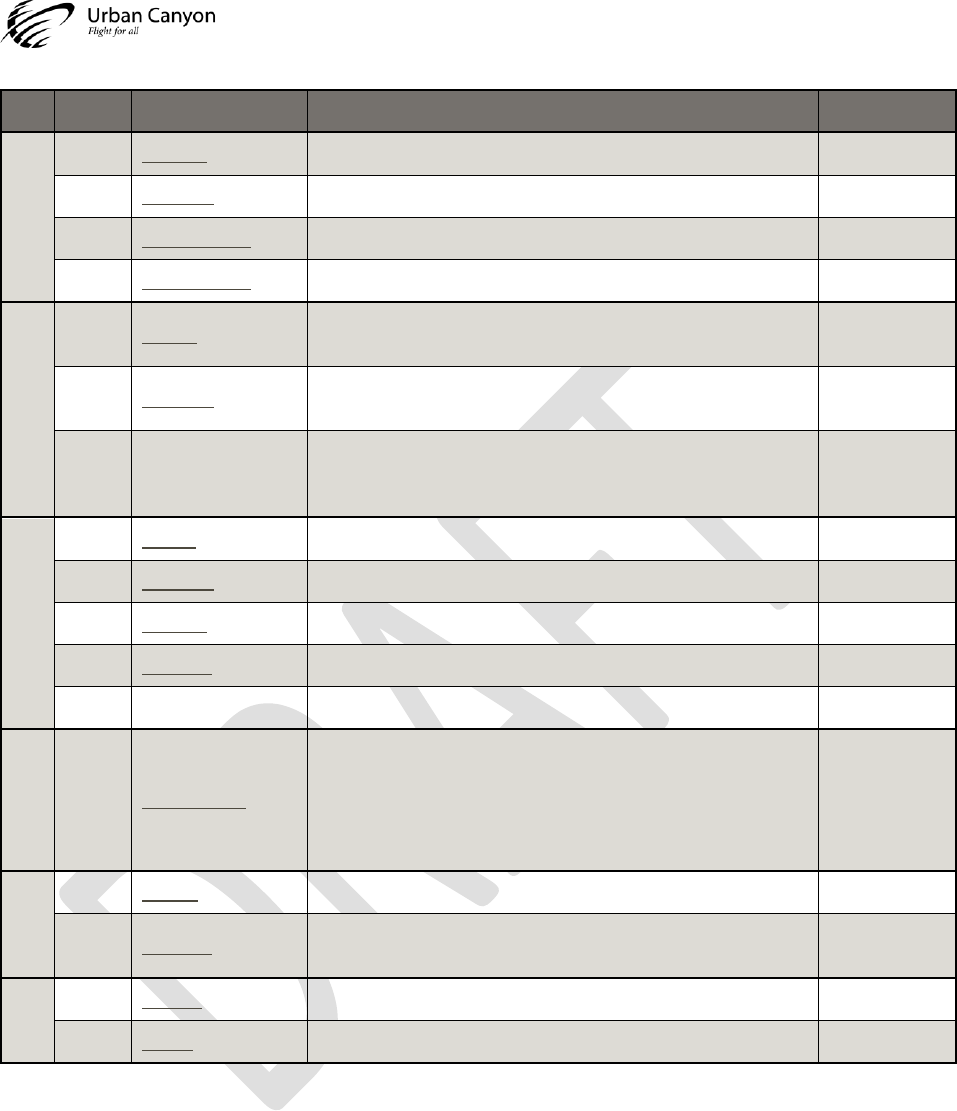
UC10x Installation Manual
URBAN CANYON FLIGHT INC UC10X-001-IM REV02
CONFIDENTIAL & PROPRIETARY PAGE 64 OF 69
Cat
Org
Doc. No.
Document Title
Date
TABS
RTCA
DO-181E
MOPS for ATCRBS/Mode S Airborne Equipment
17 Mar 2011
FAA
TSO-C199
Traffic Awareness Beacon System (TABS)
10 Oct 2014
FAA
None Provided
TSO-C199 TABS Public Review Comments
Current
FAA
None Provided
Changes to the TIS-B Service Beginning Late 2015
31 Mar 2015
Altitude Encoder
SAE
AS8003
MOPS for Automatic Pressure Altitude Code-Generating
Equipment
16 Feb 2008
FAA
TSO-C88b
Automatic Pressure Altitude Reporting Code-Generating
Equipment
06 Feb 2007
ICAO
Annex 10, Volume I,
Part 1, Equipment &
Systems
IFF Mark X (SIF)/ATCRBS
Altimeter
SAE
AS392c
Altimeter, Pressure Actuated Type
16 Feb 2008
FAA
TSO-C10b
Altimeter, Pressure Actuated, Sensitive Type
01 Sept 1959
SAE
AS8009C
Pressure Altimeter Systems
24 May 2016
FAA
TSO-C10c
Pressure Altimeter System
31 Oct 2016
NACA
Report 1235
Standard Atmosphere Tables to 65,800 ft.
Alt & Enc
CFR
14 CFR 91.217
Data correspondence between automatically reported pressure
altitude data and the pilot's altitude reference.
Current
DME
RTCA
DO-189
MOPS for DME
Sept 1985
FAA
TSO-C66c
Distance Measuring Equipment (DME) Operating Within 960-
1215MHz
18 Jan 1991
TSO
FAA
8150.1C
Technical Standard Order Program
08 Mar 2012
FAA
8110-3
Statement of Compliance with Airworthiness Standards
18 Mar 2010
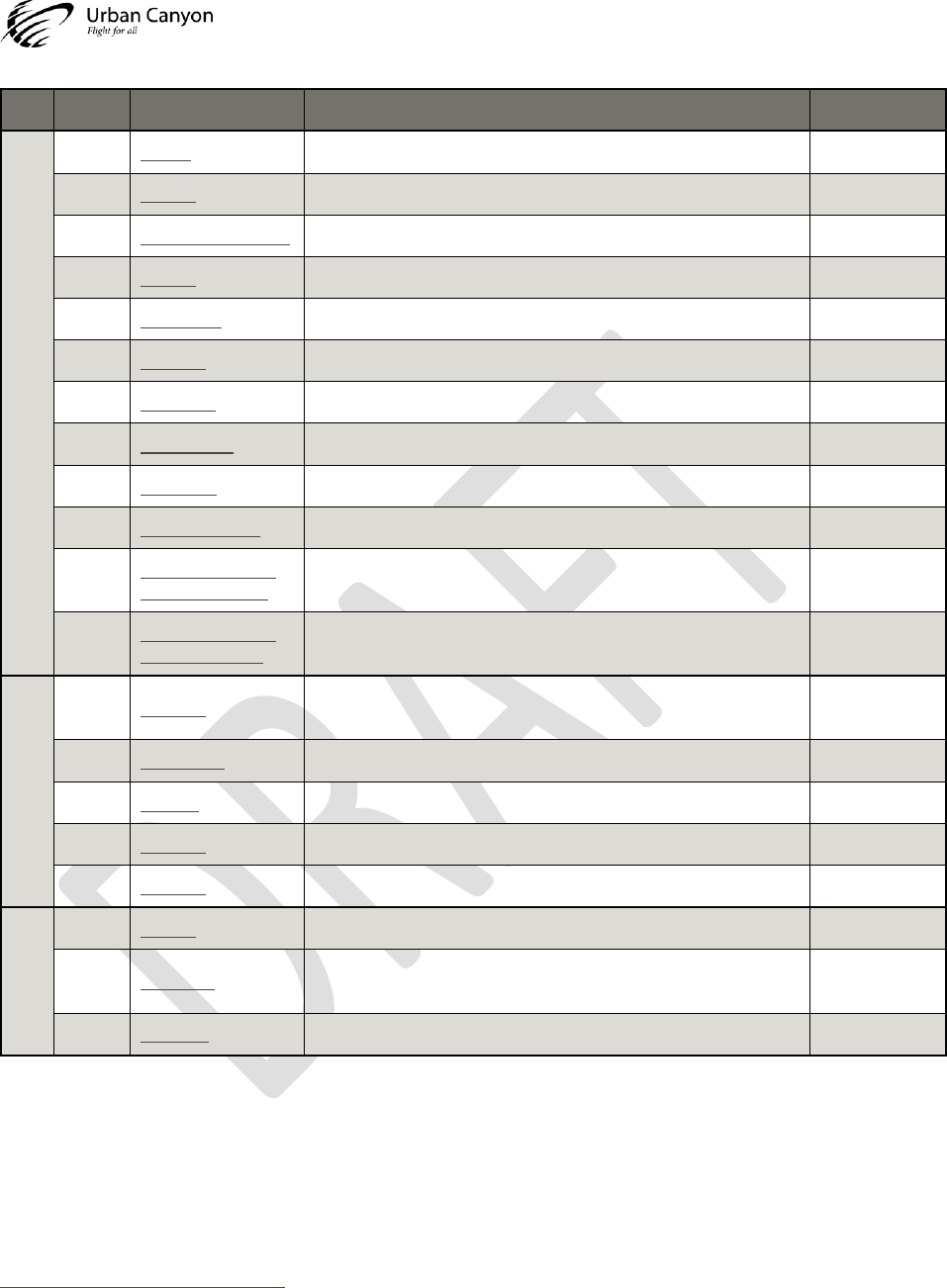
UC10x Installation Manual
URBAN CANYON FLIGHT INC UC10X-001-IM REV02
CONFIDENTIAL & PROPRIETARY PAGE 65 OF 69
Cat
Org
Doc. No.
Document Title
Date
UAS
RTCA
AWP-1
Detect and Avoid (DAA) White Paper
18 Mar 2014
RTCA
DO-365
MOPS for Detect and Avoid (DAA) Systems
31 May 2017
RTCA
DO-365 Test Vectors
DO-365 Detect and Avoid (DAA) Test Vectors
31 May 2017
RTCA
DO-366
MOPS for Air-to-Air Radar for Traffic Surveillance
31 May 2017
FAA
14 CFR 107
FAA Part 107 Small Unmanned Aircraft Systems
Current
FAA
AC 107-2
Small Unmanned Aircraft Systems (sUAS)46
21 Jun 2016
FAA
AC 21-12C
Application for US Airworthiness Certificate, FAA Form 8130-6
07 Sep 2012
FAA
Form 8130-6
Application for US Airworthiness Certificate
Apr 2011
FAA
AC 91-57A
Model Aircraft Operating Standards
02 Sep 2015
FAA
AC 91-57A Chg 1
Change1 to AC 91-57A
11 Jan 2016
DOT
Public Law 112-95,
Title III, Subtitle B
FAA Modernization and Reform Act of 2012
2012
DOT
Public Law 114-90,
Title II, Subtitle B
UAS Safety (FAA Extension, Safety, & Security Acot of 2016)
2016
Software
FAA
DO-178C
Software Considerations in Airborne Systems and Equipment
Certification
13 Dec 2011
FAA
AC 20-115C
Airborne Software Assurance
19 July 2013
FAA
8110.49
Software Approval Guidelines
28 Sep 2011
RTCA
DO-278A
Software Integrity Assurance Considerations for CNS/ATM Systems
13 Dec 2011
RTCA
DO-248C
Supporting Information for DO-178C and DO-278A
13 Dec 2011
AEH
RTCA
DO-254
Design Assurance Guidance for Airborne Electronic Hardware
19 Apr 2000
FAA
AC 20-152
RTCA, Inc., Document RTCA/DO-254, Design Assurance Guidance
for Airborne Electronic Hardware
30 June 2005
FAA
8110.105
Simple and Complex Electronic Hardware Approval Guidance
23 Sep 2008
46
Includes guidance for airmen (remote pilot) certification, aircraft registration and marking, aircraft airworthiness, and
operations of small Unmanned Aircraft Systems (sUAS) in the National Airspace System (NAS).
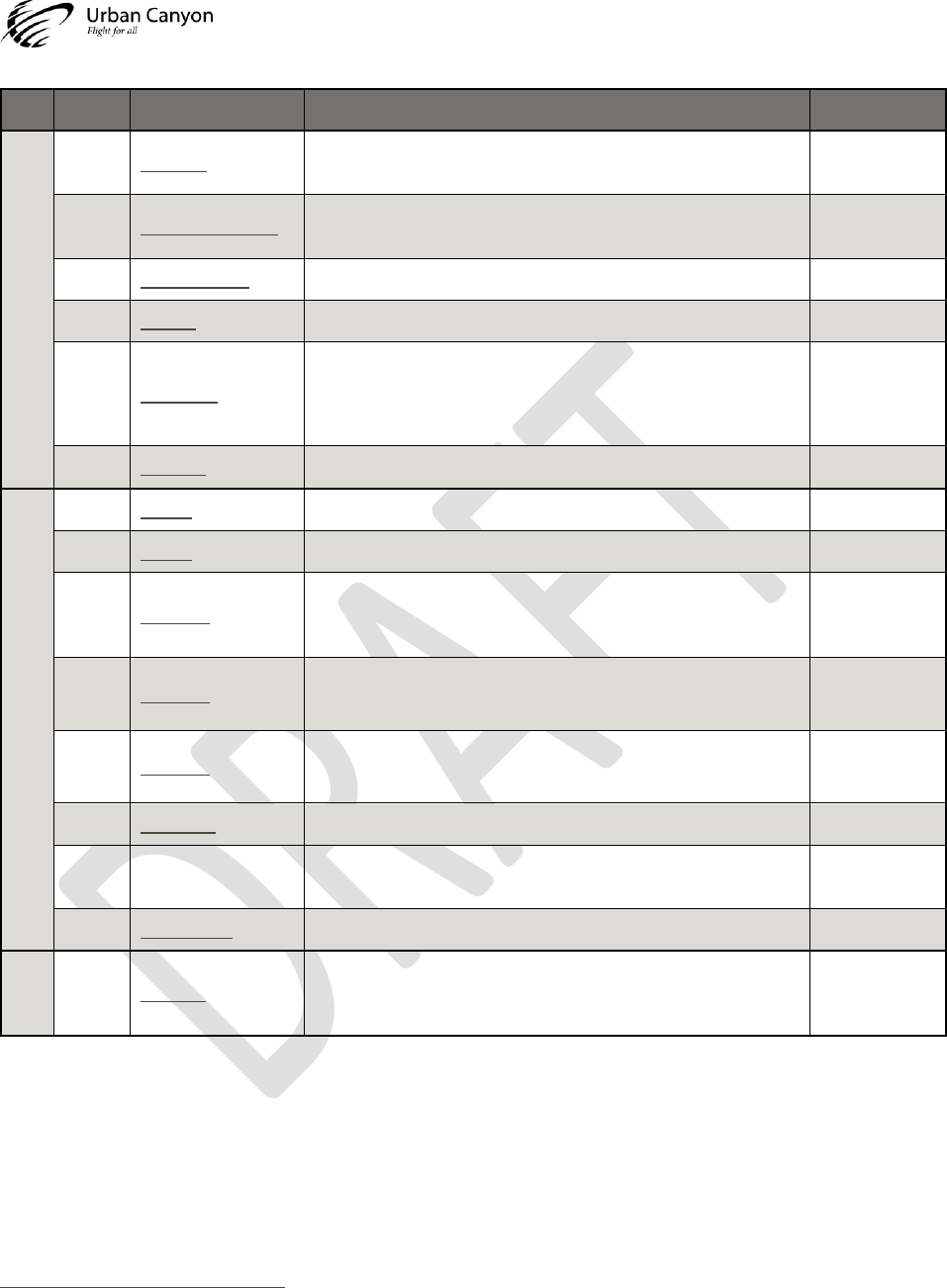
UC10x Installation Manual
URBAN CANYON FLIGHT INC UC10X-001-IM REV02
CONFIDENTIAL & PROPRIETARY PAGE 66 OF 69
Cat
Org
Doc. No.
Document Title
Date
Environmental
RTCA
DO-160G
Environmental Conditions and Test Procedures for Airborne
Equipment
8 Dec 2010
RTCA
DO-160G Change 1
Environmental Conditions and Test Procedures for Airborne
Equipment
16 Dec 2014
RTCA
DO-160G Form
Environmental Qualification Form
8 Dec 2010
RTCA
DO-357
User Guide: Supplement to DO-160G
16 Dec 2014
FAA
AC 21-16G
RTCA Document DO-160 versions
D, E, F, and G, “Environmental Conditions
and Test Procedures for Airborne Equipment”
22 Jun 2011
FAA
AC 25-16
Electrical Fault Fire Prevention and Protection
5 Apr 1991
Interface
ARINC
718A-4
Mark 4 ATCRBS/Mode S ARINC Characteristic
15 Nov 2011
ARINC
743A-5
GNSS Sensor ARINC Characteristic
29 May 2009
ARINC
429P1-18
Digital Information Transfer System (DITS) Part 1 Functional
Description, Electrical Interfaces, Label Assignments and Word
Formats
29 Nov 2012
ARINC
429P2-16
MARK 33 Digital Information Transfer System (DITS)
Part 2 Discrete Word Data Standards
17 Dec 2004
ARINC
429P3-19
MARK 33 Digital Information Transfer System (DITS)
Part 3 File Data Transfer Techniques
25 June 2009
SAE
ARP4754A
Guidelines for Development of Civil Aircraft and Systems.
21 Dec 2010
TIA
TIA/EIA-232-F47
Interface Between Data Terminal Equipment and Data Circuit-
Terminating Equipment Employing Serial Binary Data Interchange
2012
NMEA
0183 Ver 4.1
Standard for Interfacing Marine Electronic Devices
June 2012
TC/STC
SAE
ARP4761
Guidelines and Methods for Conducting the Safety Assessment
Process on Civil Airborne Systems and Equipment.
01 Dec 1996
47
RS-232 interface standard. TIA/EIA-232 is functionally equivalent with international standards ITU-T V.24, V.28,
and ISO/IEC 2110
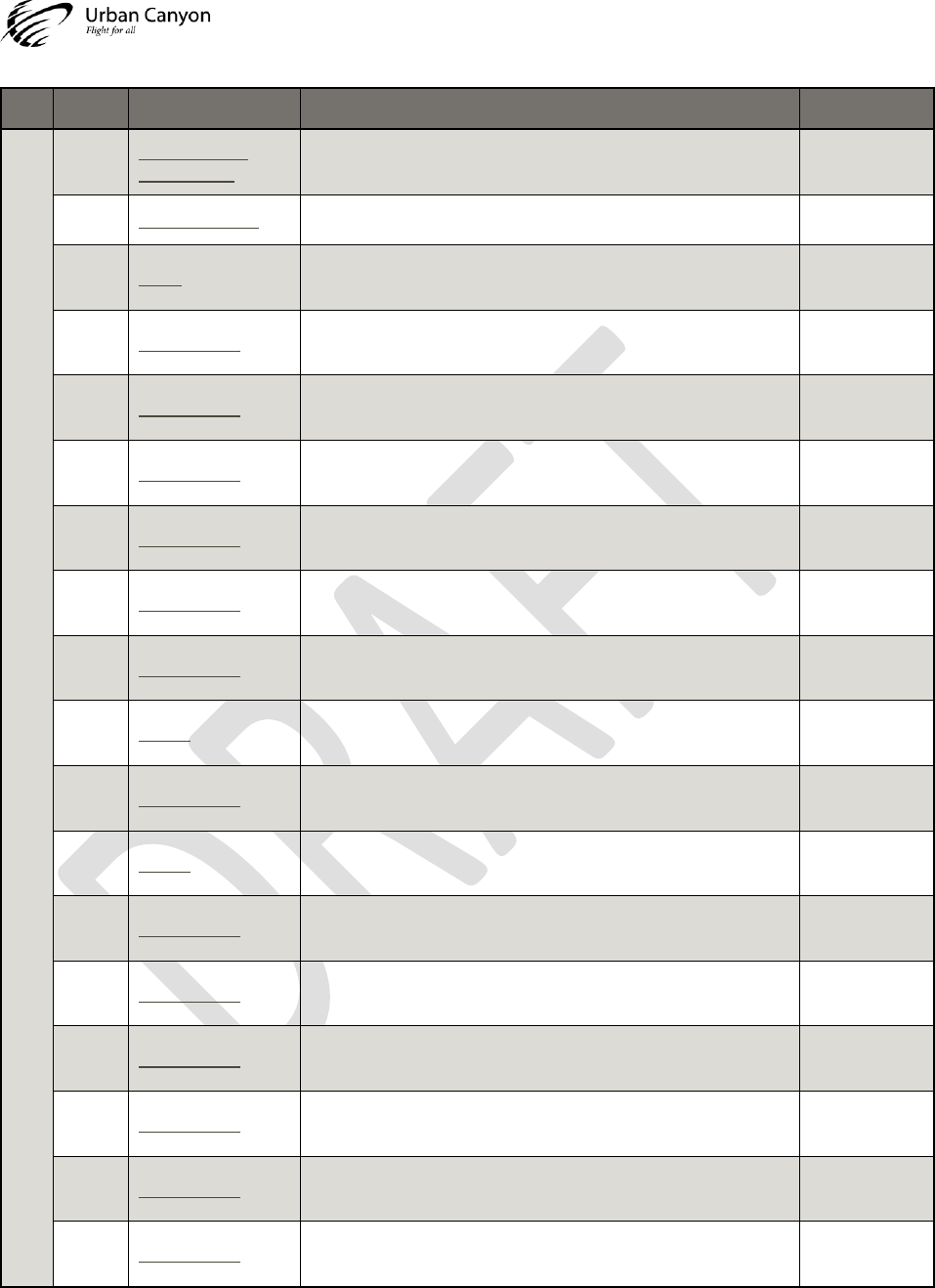
UC10x Installation Manual
URBAN CANYON FLIGHT INC UC10X-001-IM REV02
CONFIDENTIAL & PROPRIETARY PAGE 67 OF 69
Cat
Org
Doc. No.
Document Title
Date
FCC
FCC
OET Bulletin 65
Edition 97-01
Evaluating Compliance with FCC Guidelines for Human Exposure to
Radiofrequency Electromagnetic Fields
Aug 1997
FCC
KDB 447498 D01
General RF Exposure Guidance v06
23 Oct 2015
FCC
Part 2
Frequency Allocations; General Rules & Regulations
Current
FCC
47 CFR 2.1046
Measurements Required: RF Power Output
Current
FCC
47 CFR 2.1047
Measurements Required: Modulation Characteristics
Current
FCC
47 CFR 2.1049
Measurements Required: Occupied Bandwidth
Current
FCC
47 CFR 2.1051
Measurements Required: Spurious Emissions at Antenna Term.
Current
FCC
47 CFR 2.1053
Measurements Required: Field Strength of Spurious Radiation
Current
FCC
47 CFR 2.1055
Measurements Required: Frequency Stability
Current
FCC
Part 15
Radio Frequency Devices
Current
FCC
Part 15.109(a)
Unintentional Radiators – Radiated Emission Limits
Current
FCC
Part 87
Aviation Services
Current
FCC
47 CFR 87.131
Power and Emissions
Current
FCC
47 CFR 87.133
Frequency Stability
Current
FCC
47 CFR 87.135
Bandwidth of Emission
Current
FCC
47 CFR 87.137
Types of Emission
Current
FCC
47 CFR 87.139
Emission Limitations
Current
FCC
47 CFR 87.143
Transmitter Control Requirements
Current
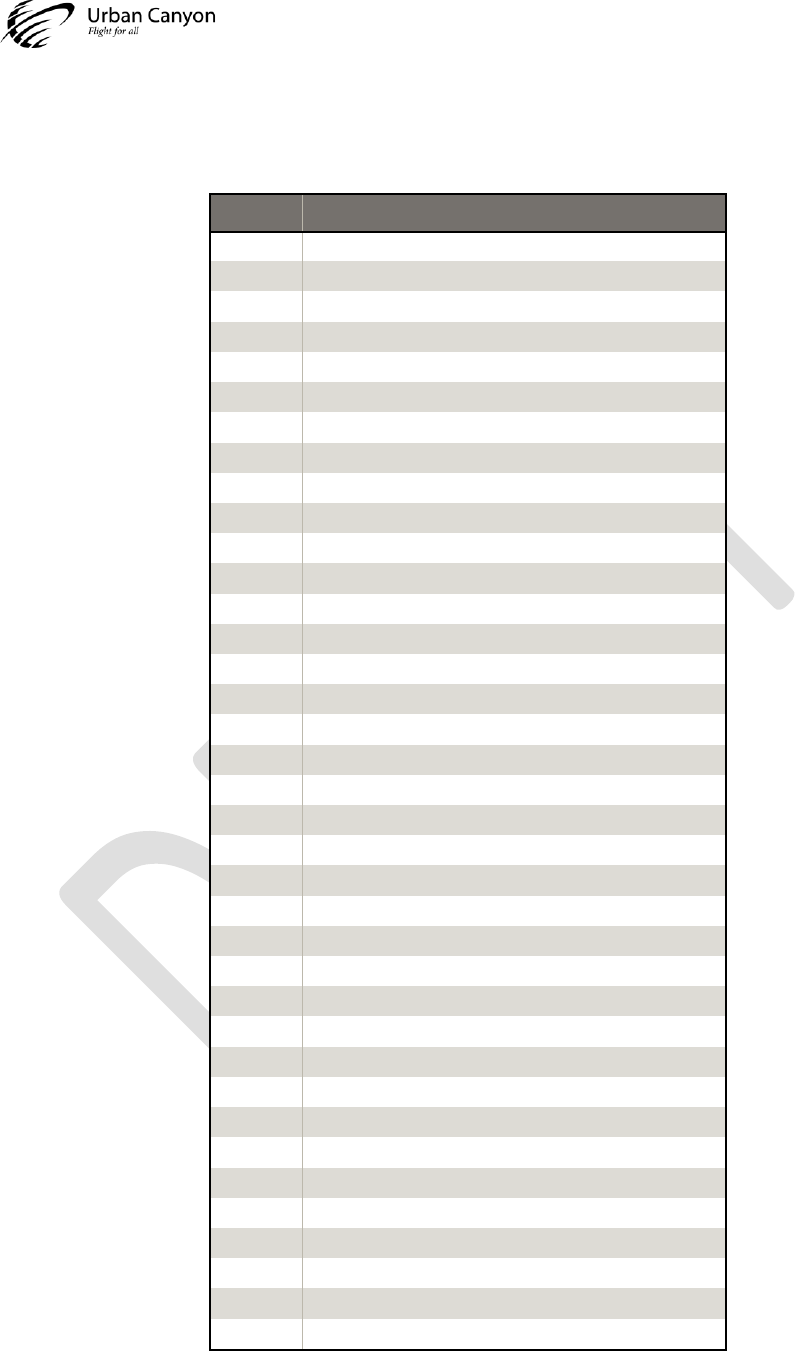
UC10x Installation Manual
URBAN CANYON FLIGHT INC UC10X-001-IM REV02
CONFIDENTIAL & PROPRIETARY PAGE 68 OF 69
15 Acronyms
Table 22. Definition of Acronyms
Acronym
Meaning
TSO
Technical Standards Order
TSOA
TSO approval
TC
Type certificate
STC
Special type certificate
MOPS
Minimum Operational Performance Standard
MASPS
Minimum Aviation System Performance Standard
ATC
Air traffic control
ATCRBS
ATC radar beacon system
SSR
Secondary surveillance radar
PPM
Pulse position modulation
1090ES
1090MHz Extended Squitter
DF
Downlink format
UF
Uplink format
CPR
Compact position reporting
SV
State vector
MS
Mode status
ARV
Air referenced velocity
BDS
Comm-B data selector
GICB
Ground Initiated Comm-B
BER
Bit error rate
BW
Bandwidth
FEC
Forward error correction
ERP
Effective Radiated Power
RF
Radio frequency
MTL
Minimum triggering level
IAS
Indicated airspeed
TAS
True airspeed
IFR
Instrument flight rules
VFR
Visual flight rules
UTC
Universal Coordinated Time
GPS
Global Positioning System
GNSS
Global navigation satellite system
WAAS
Wide Area Augmentation System
SBAS
Satellite-based augmentation system
WGS84
World Geodetic System 1984
NIC
Navigation integrity category
NAC
Navigation accuracy category
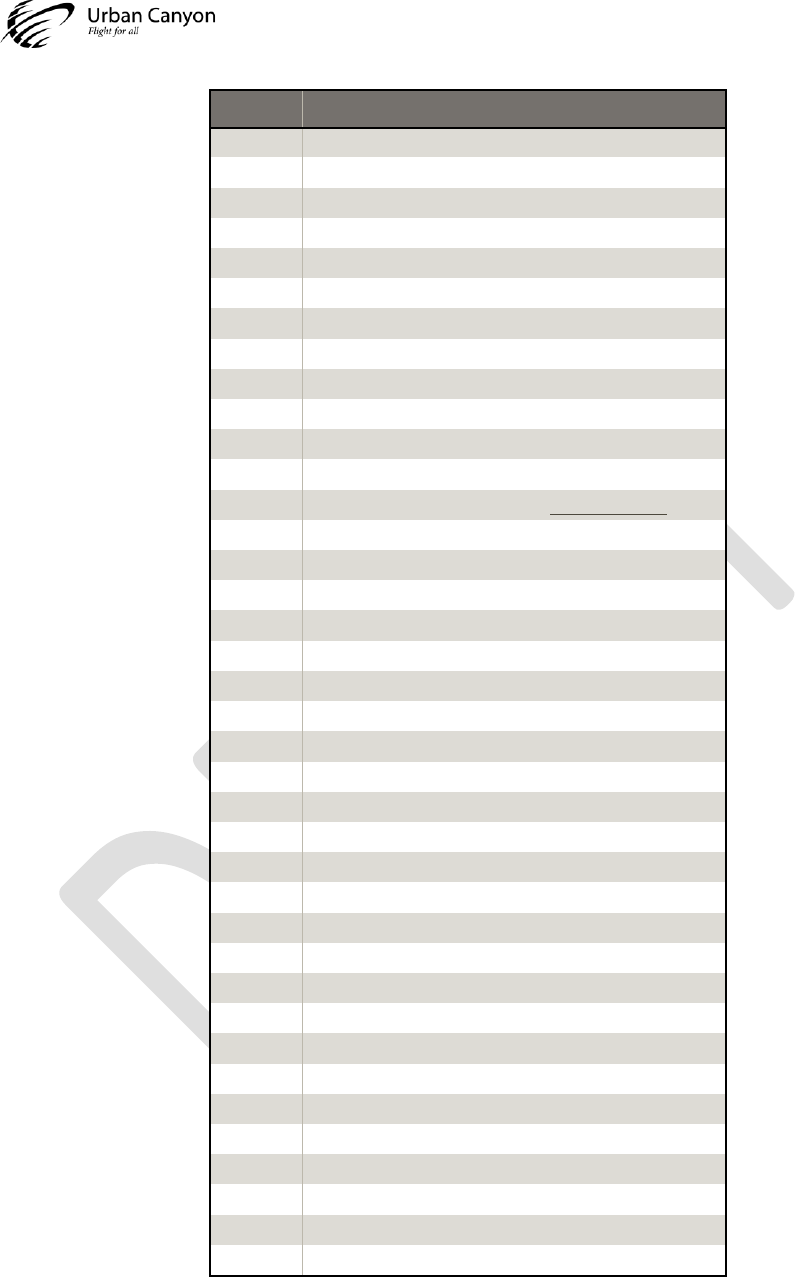
UC10x Installation Manual
URBAN CANYON FLIGHT INC UC10X-001-IM REV02
CONFIDENTIAL & PROPRIETARY PAGE 69 OF 69
Acronym
Meaning
SIL
Source integrity level
HDOP
Horizontal dilution of precision
Mode S
Mode select
ADS-B
Automatic Dependent Surveillance-Broadcast
UAT
Universal Access Transceiver
TCAS
Traffic collision avoidance system
TA
Traffic advisory
RA
Resolution advisory
CDTI
Cockpit display of traffic information
SPI
Special position identification
NOTAM
Notice to Airmen
NAS
National Airspace System
FAR
Federal aviation regulations (Title 14 of CFR)
FAA
Federal Aviation Administration
DoT
Department of Transportation (U.S.A.)
DoD
Department of Defense (U.S.A.)
FCC
Federal Communications Commission
CFR
Code of Federal Regulations
EASA
European Aviation Safety Agency
ICAO
International Civil Aviation Organization
SAE
Society of Automotive Engineers
NMEA
National Marine Electronics Association
DAL
Design assurance level
SDA
System design assurance
AC
Advisory circular
RTCA
Radio Technical Commission for Aeronautics
ARINC
Aeronautical Radio, Incorporated
PTI
Peckham Technology Inc
UCF
Urban Canyon Flight, Inc
MCU
Microcontroller
FPGA
Field-programmable gate array
UUT
Unit under test
PM
Project manager
CM
Configuration Management
QA
Quality Assurance
WOW
Weight on Wheels
LAST
Light Aviation SSR Transponder
TABS
Traffic Awareness Beacon System